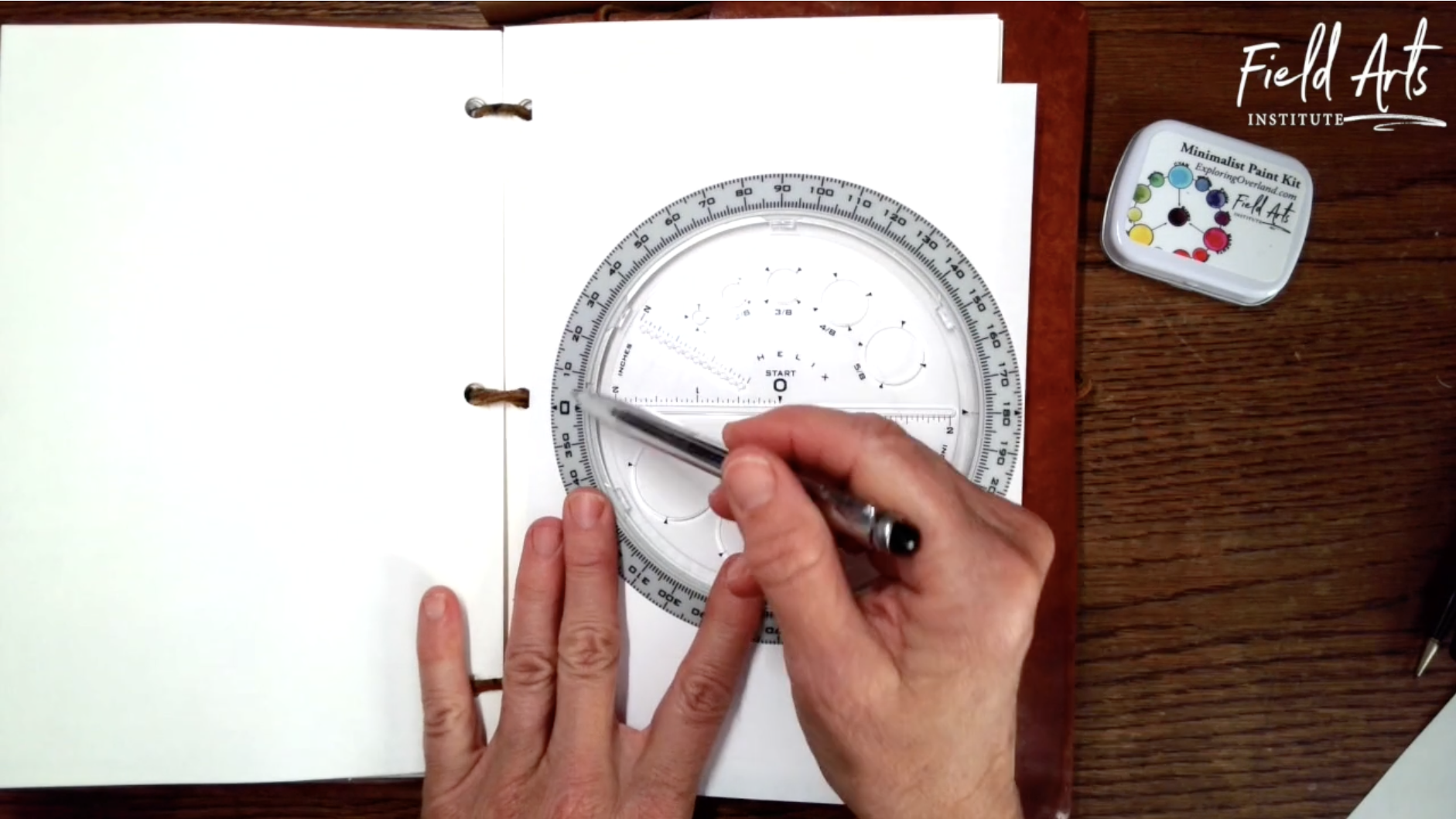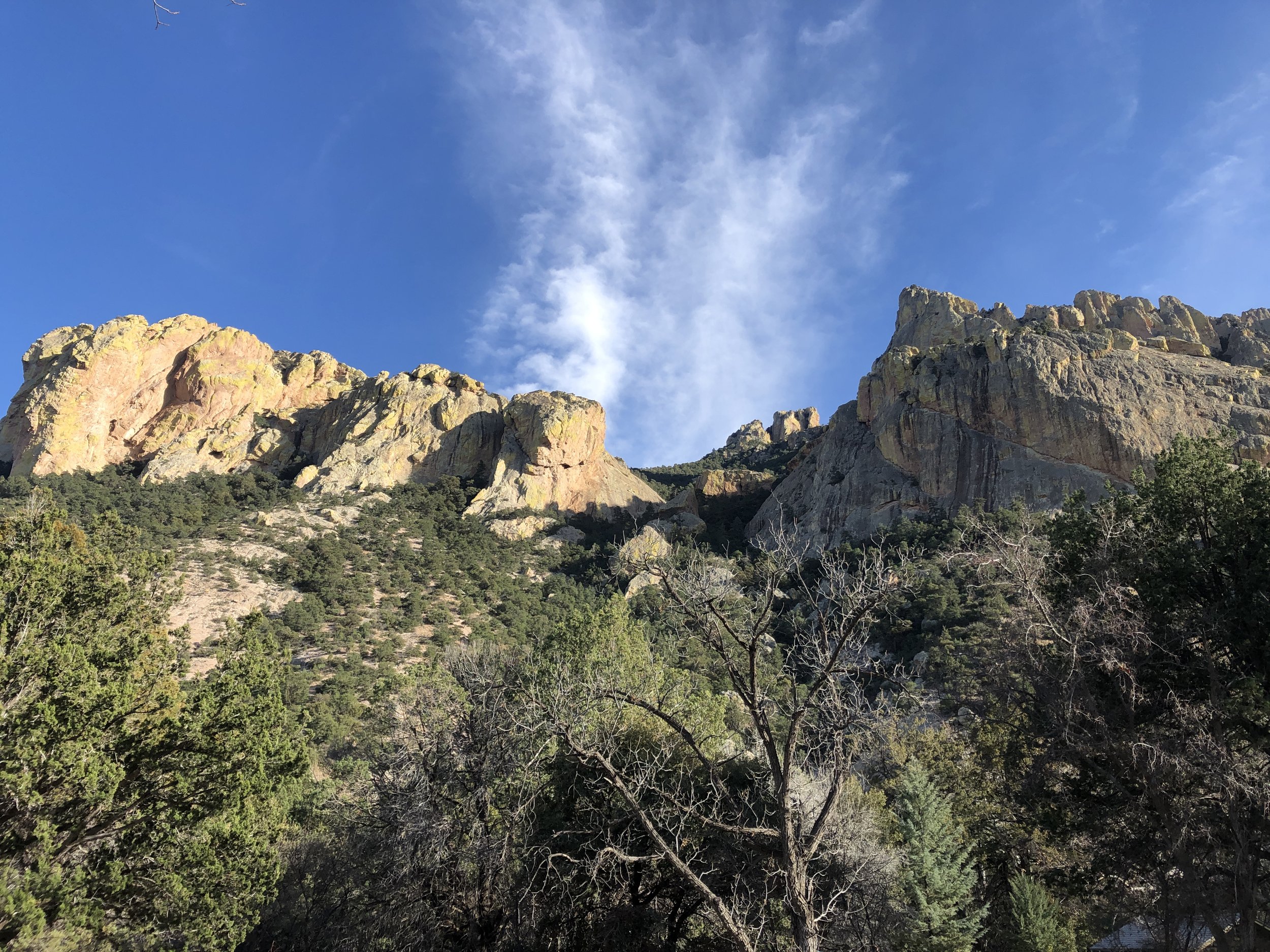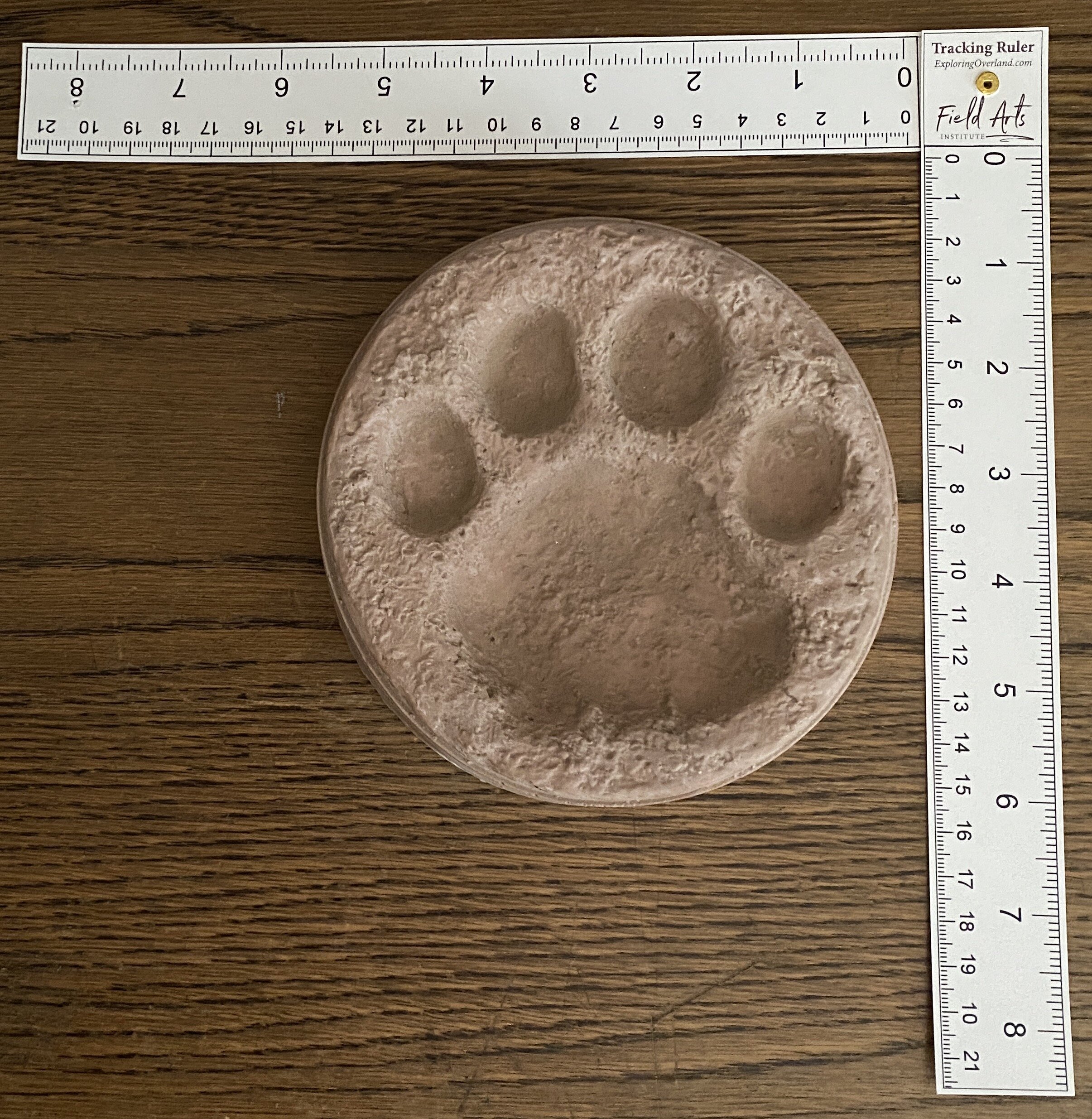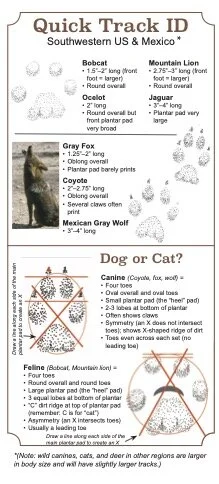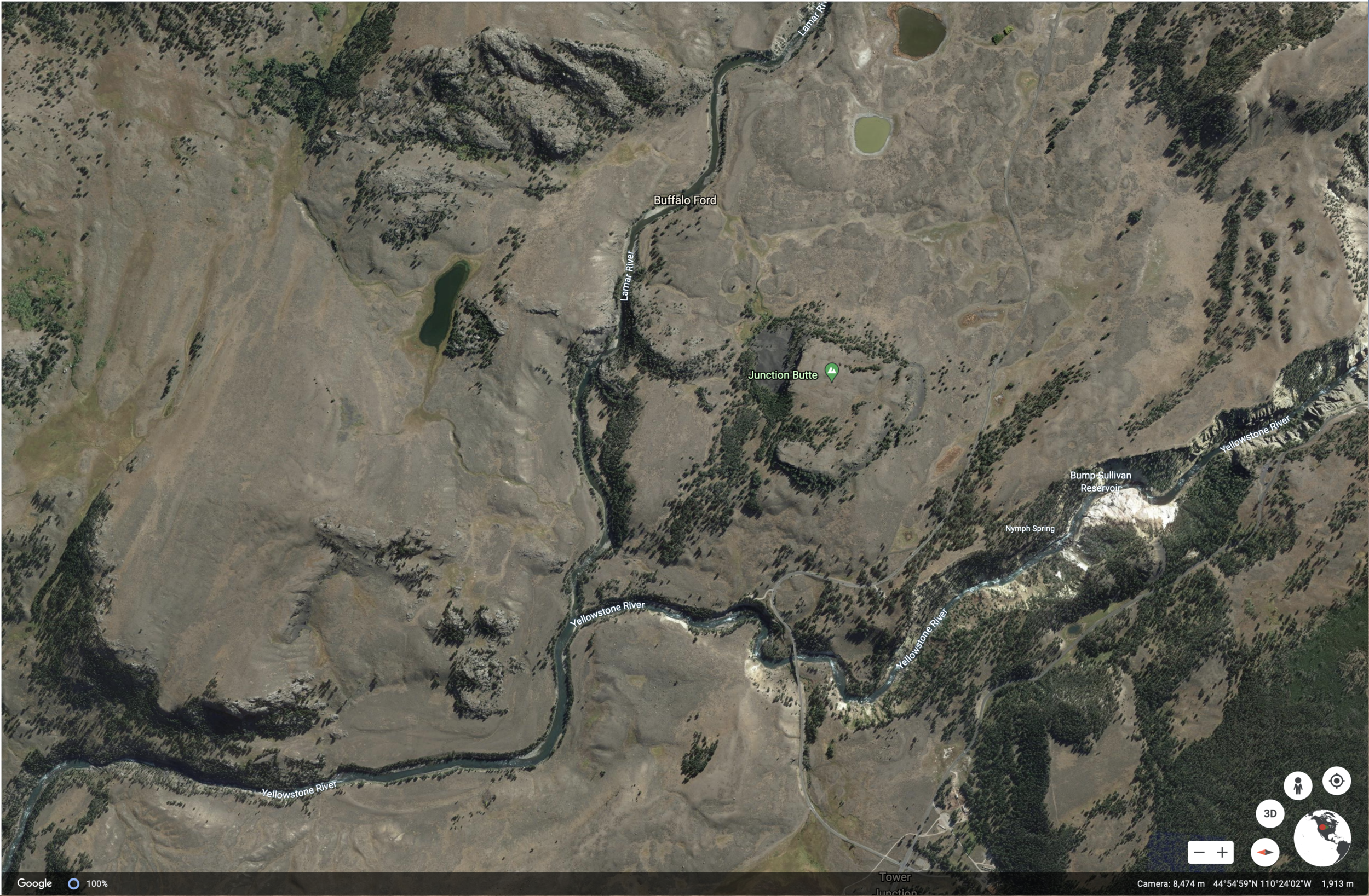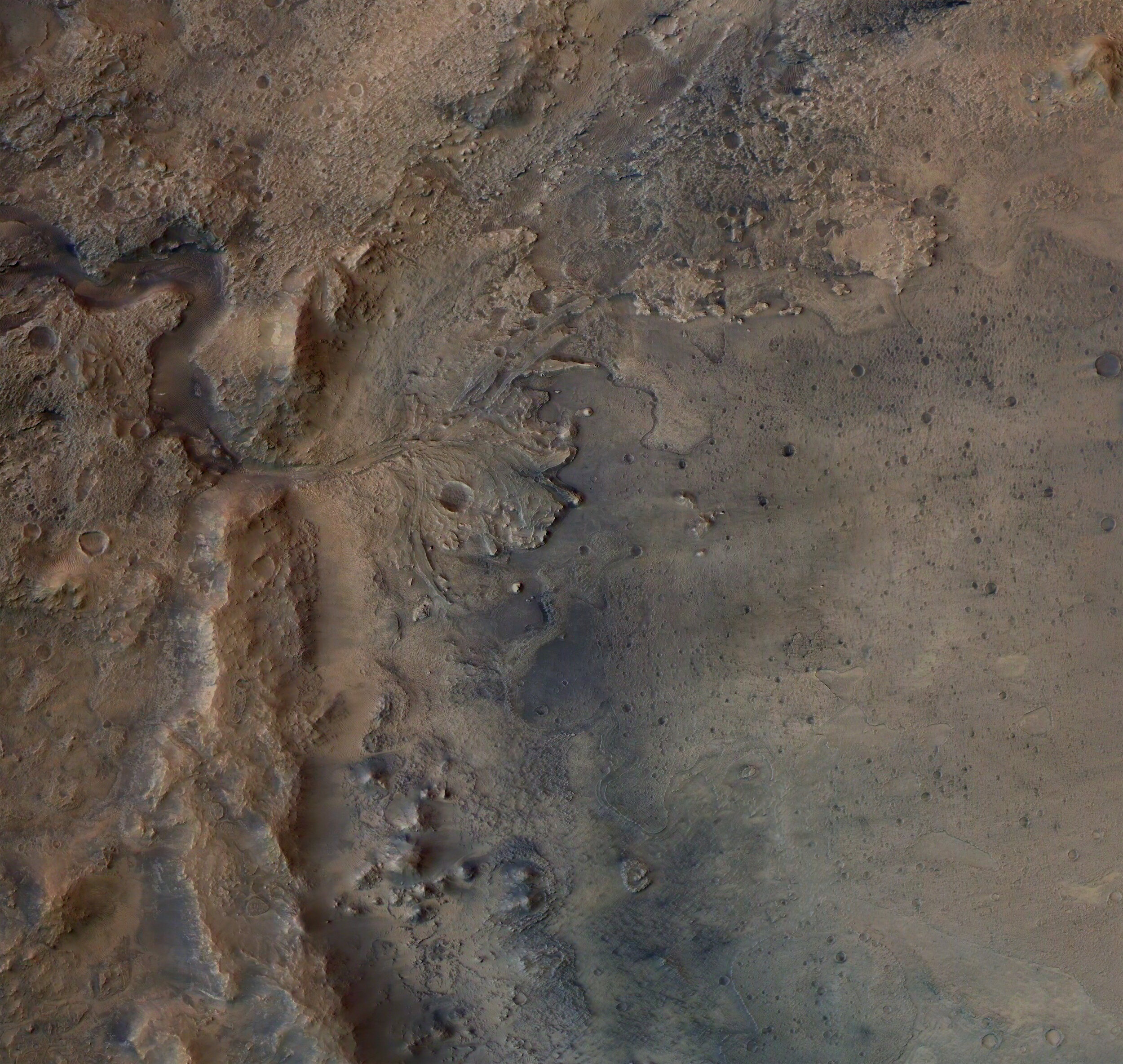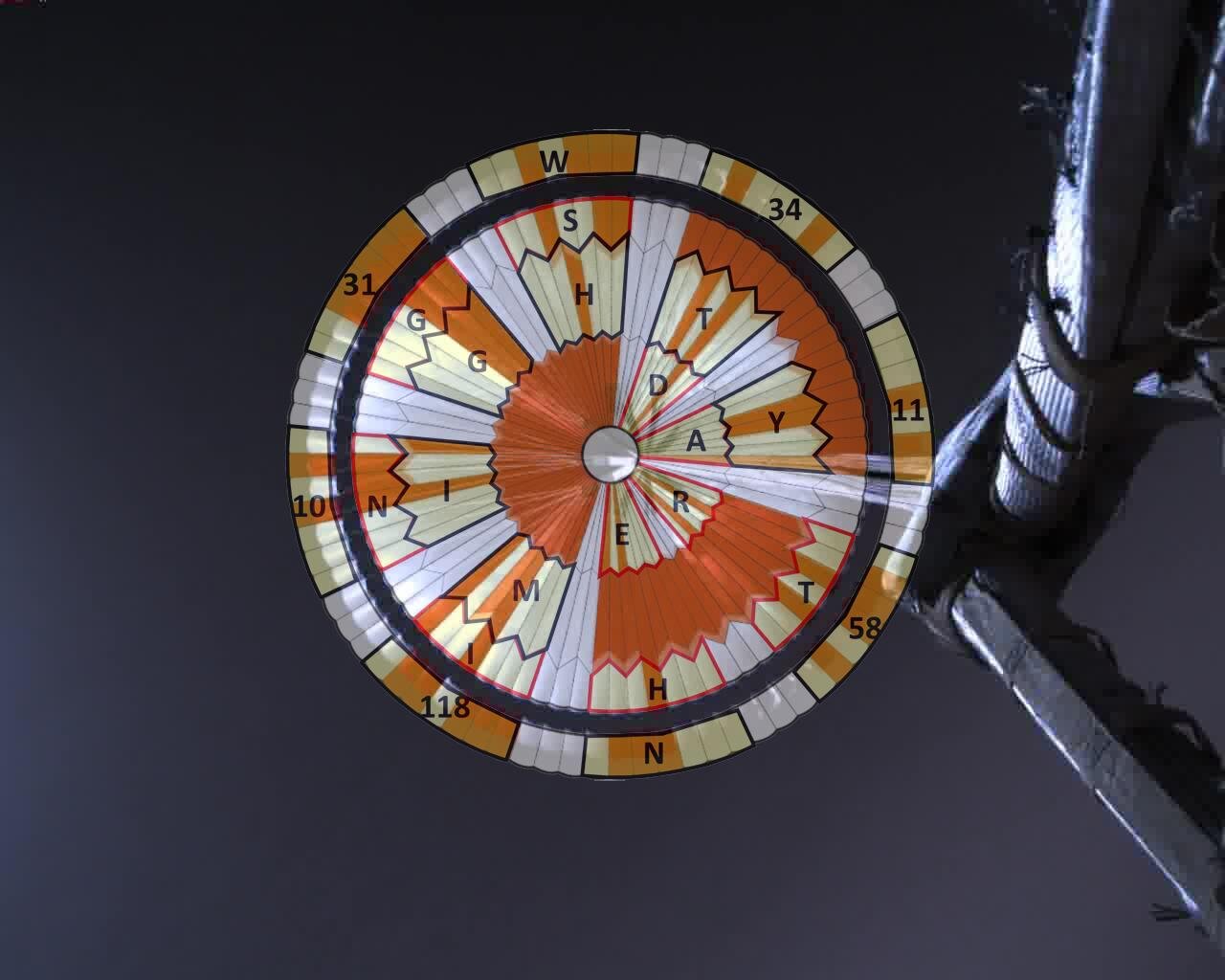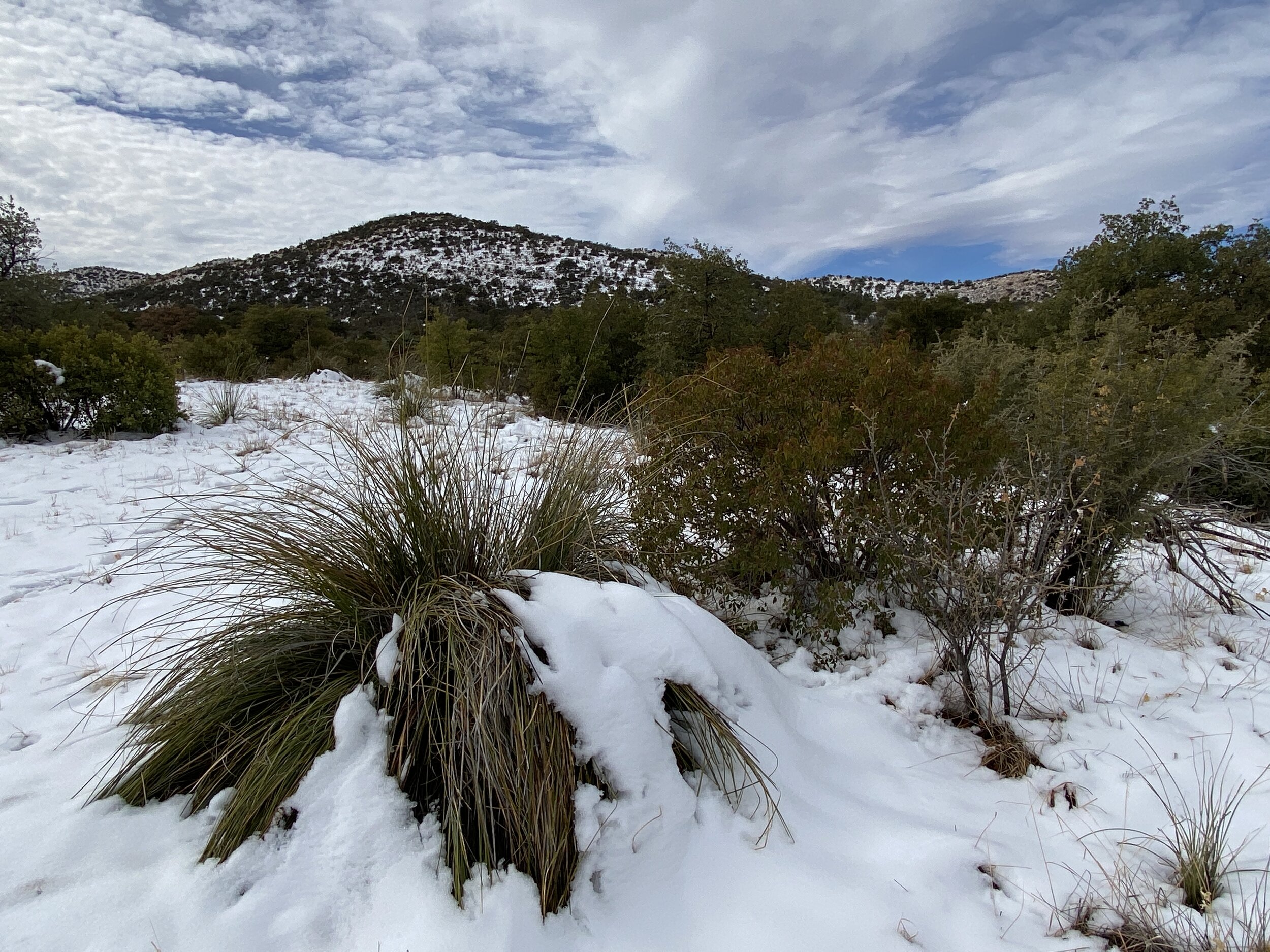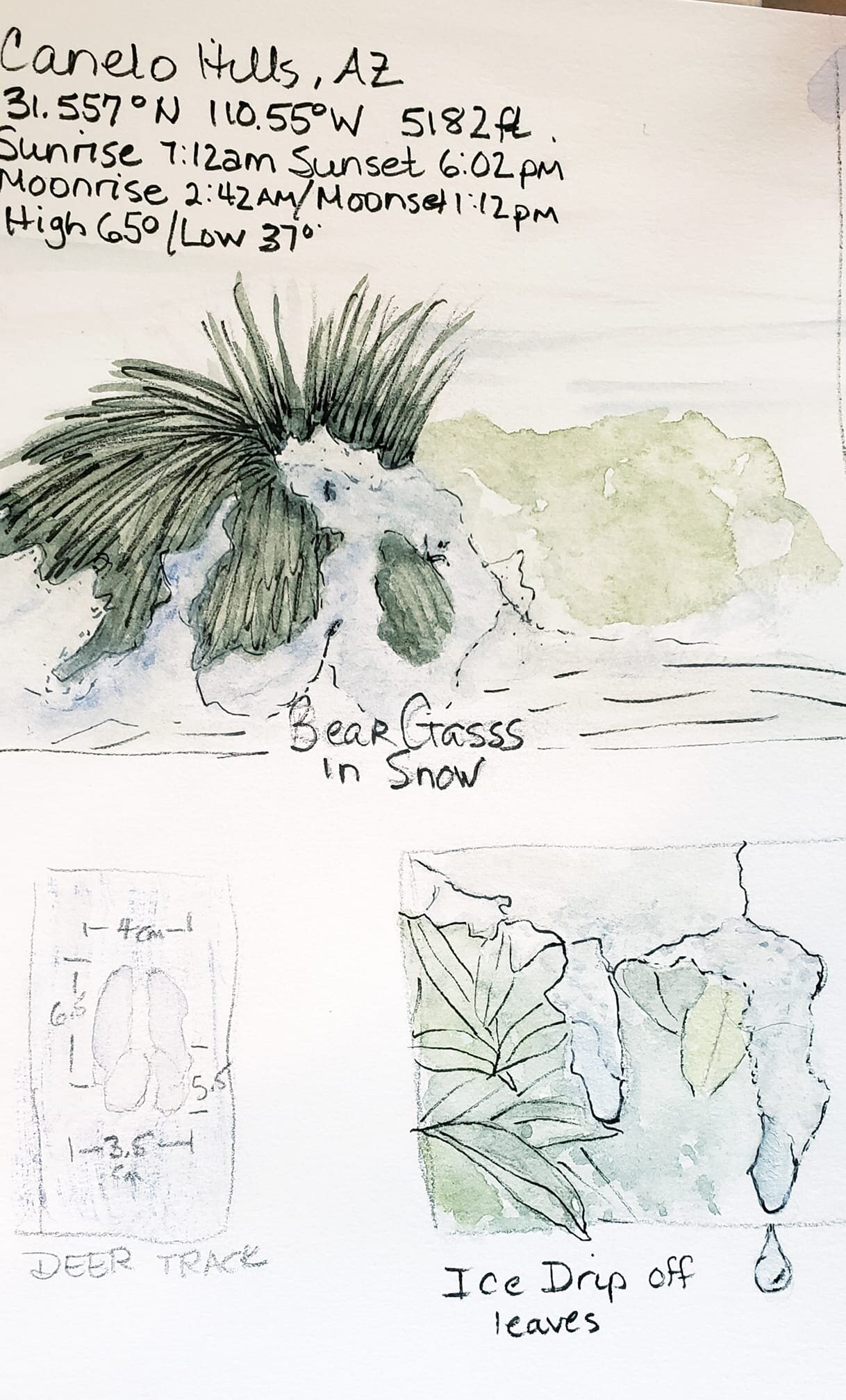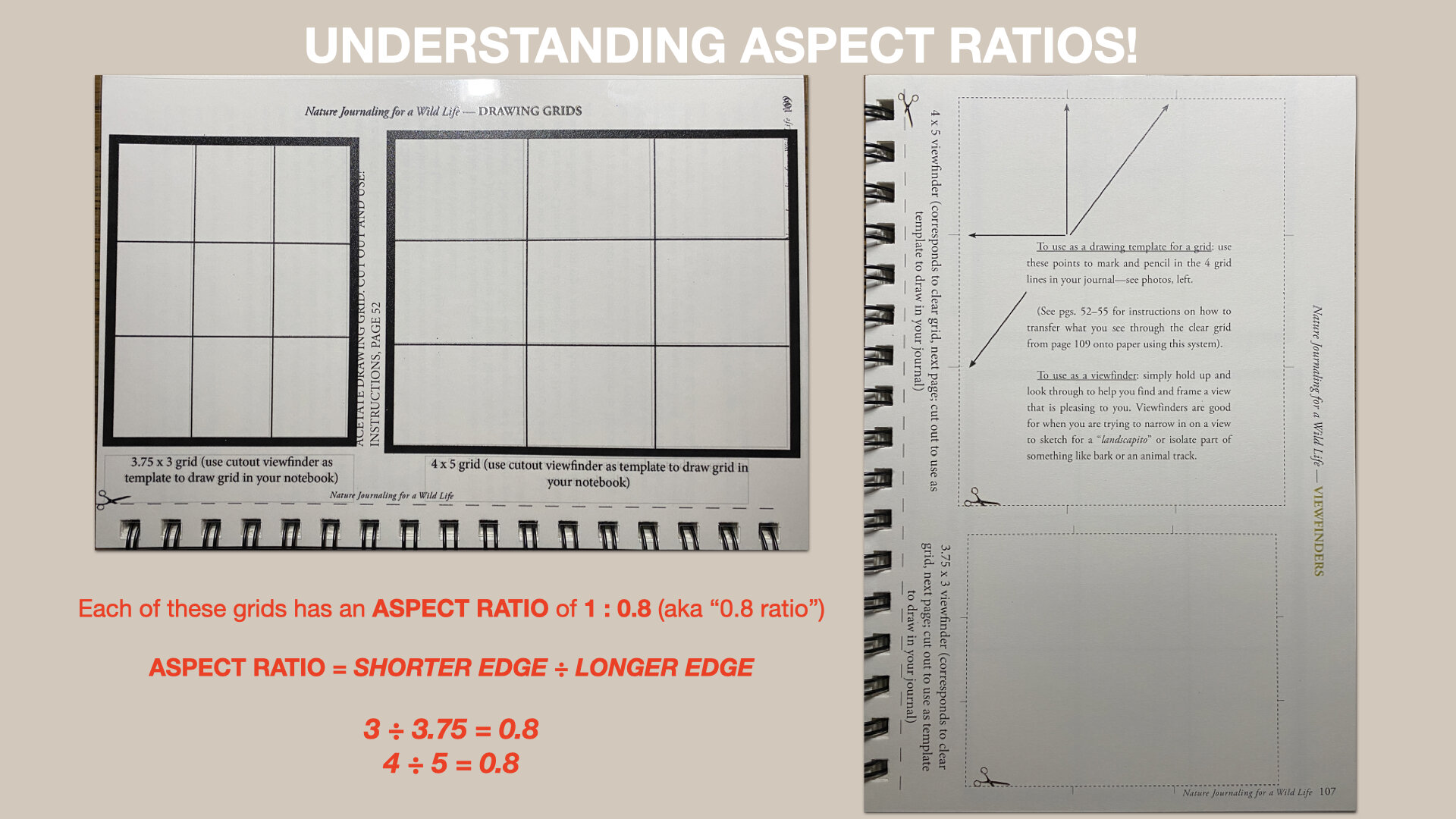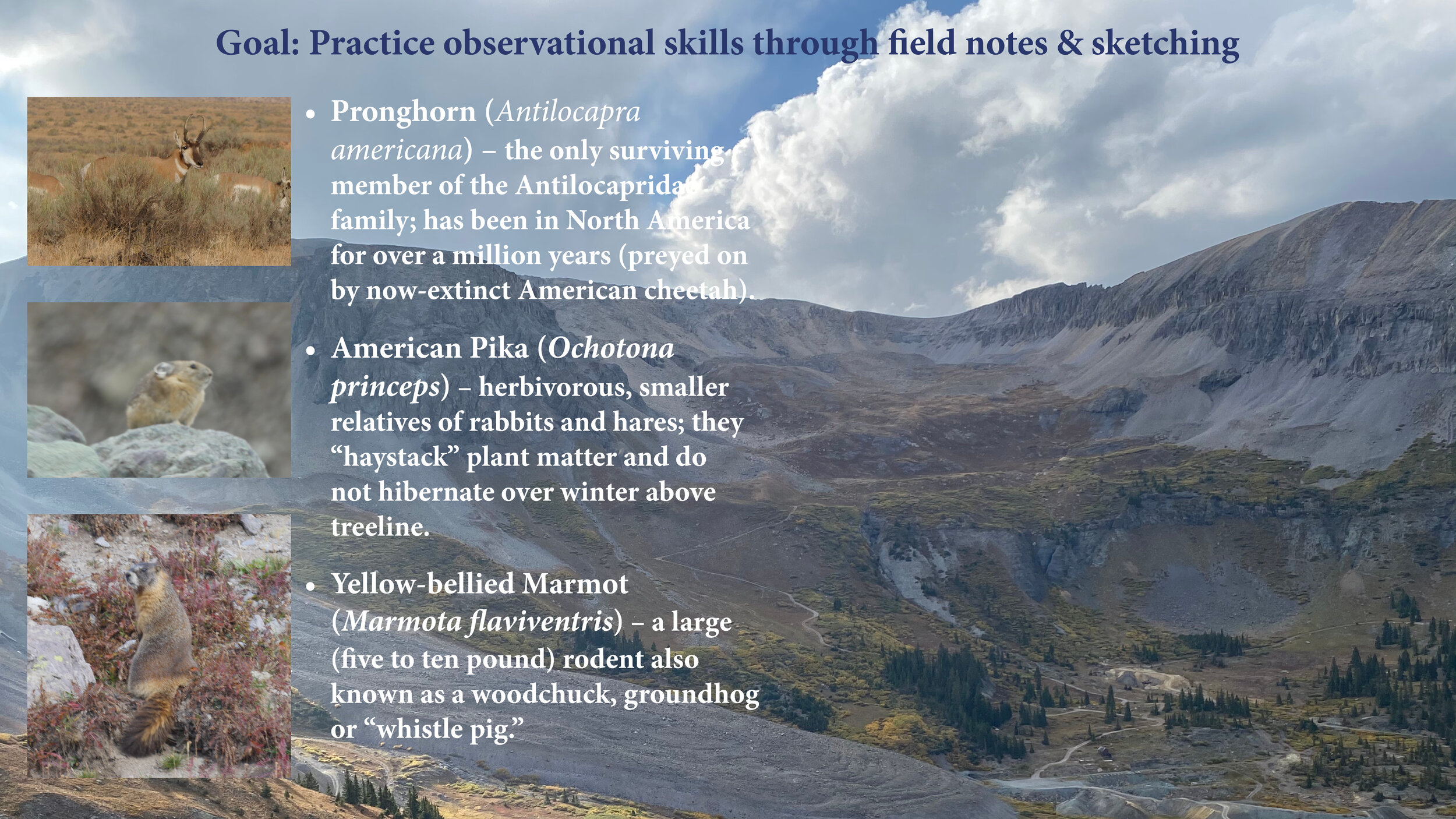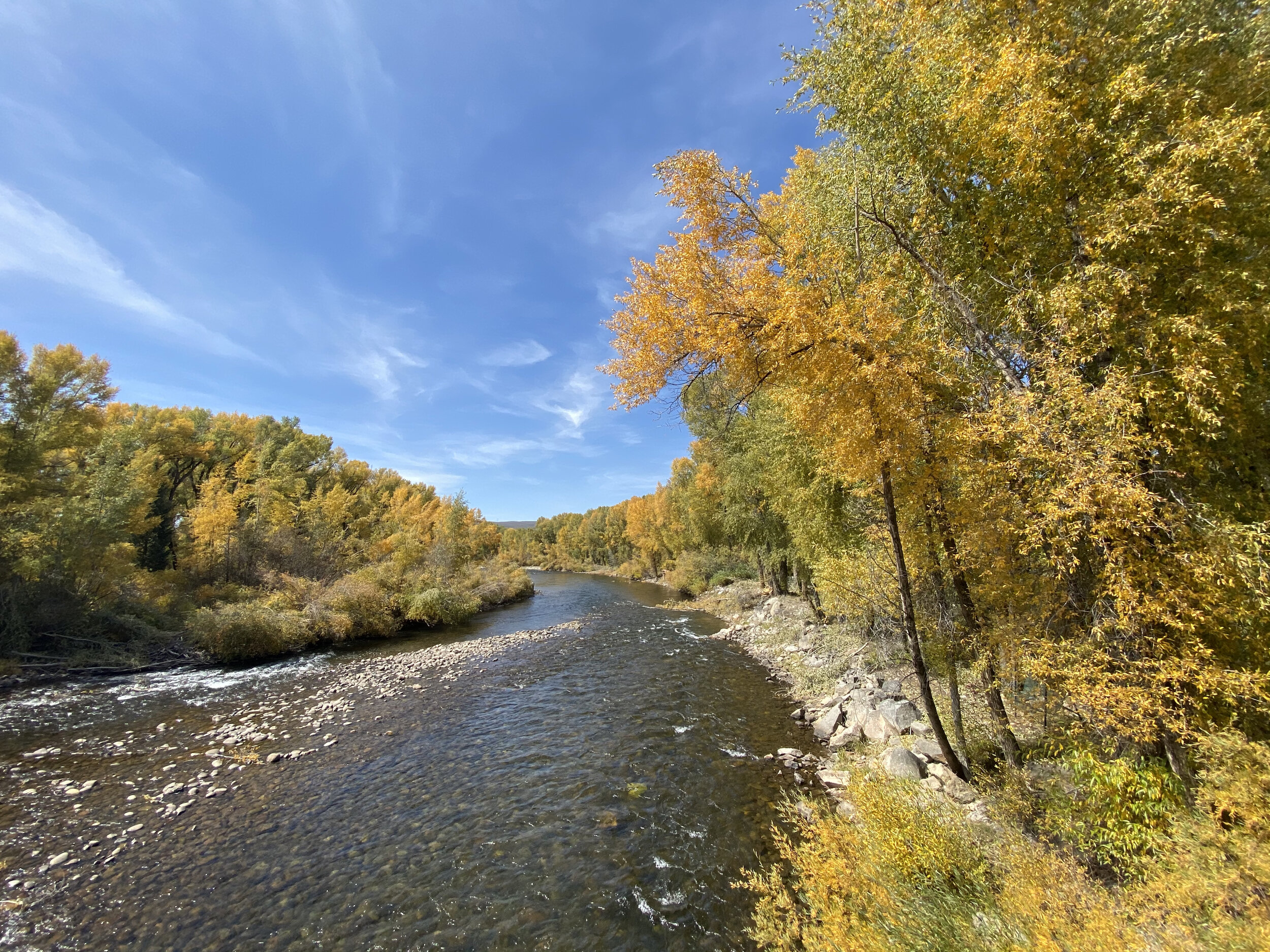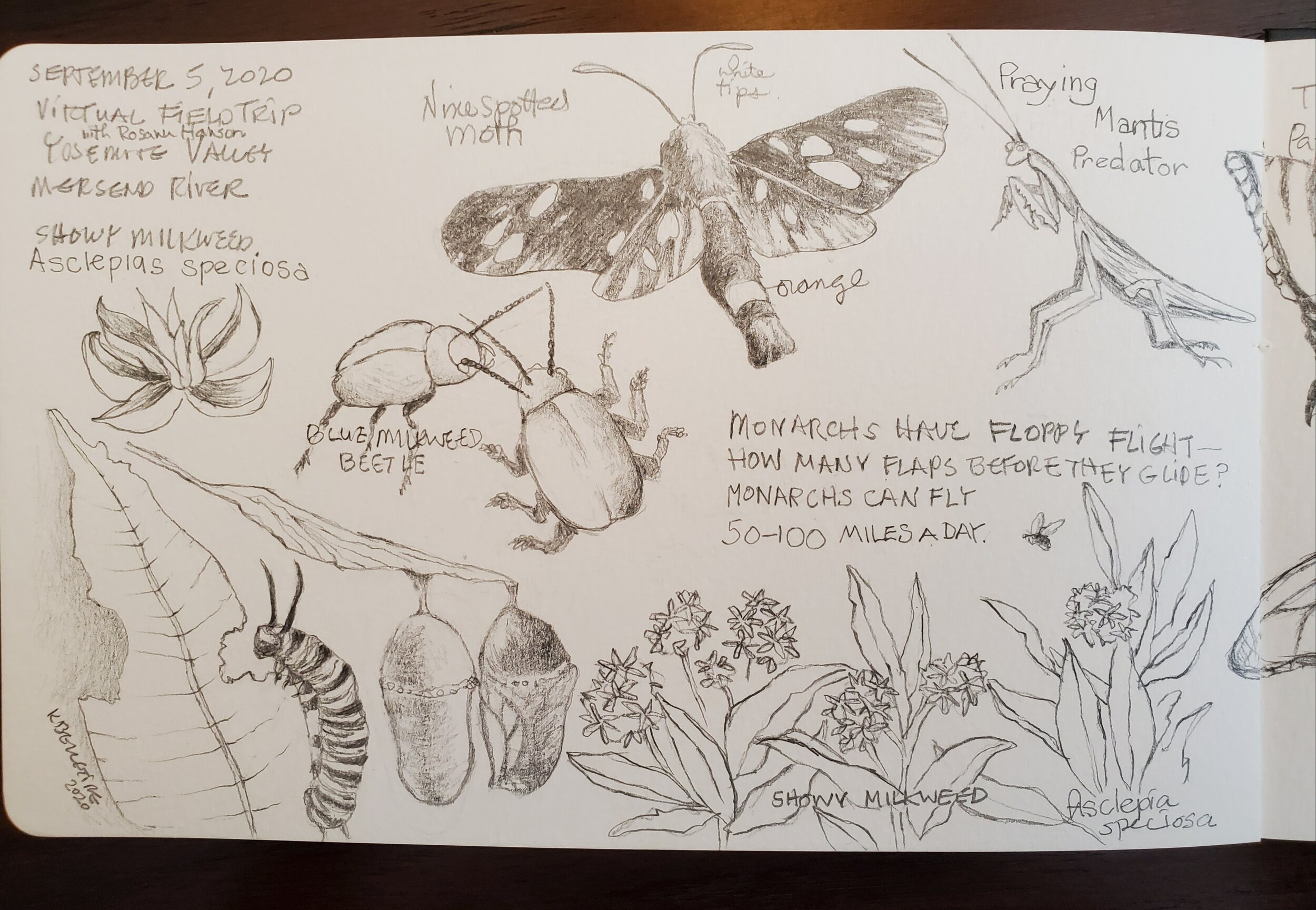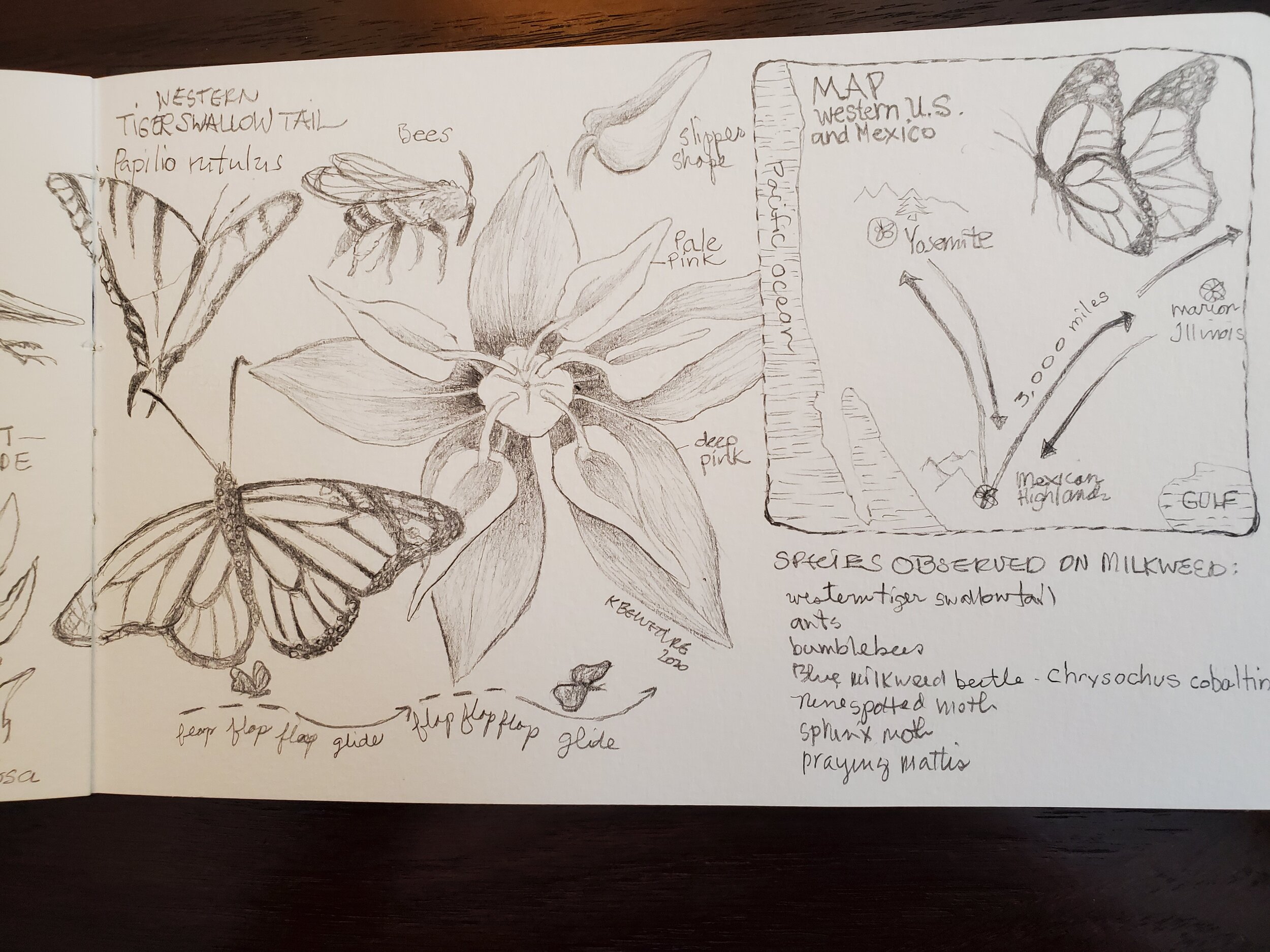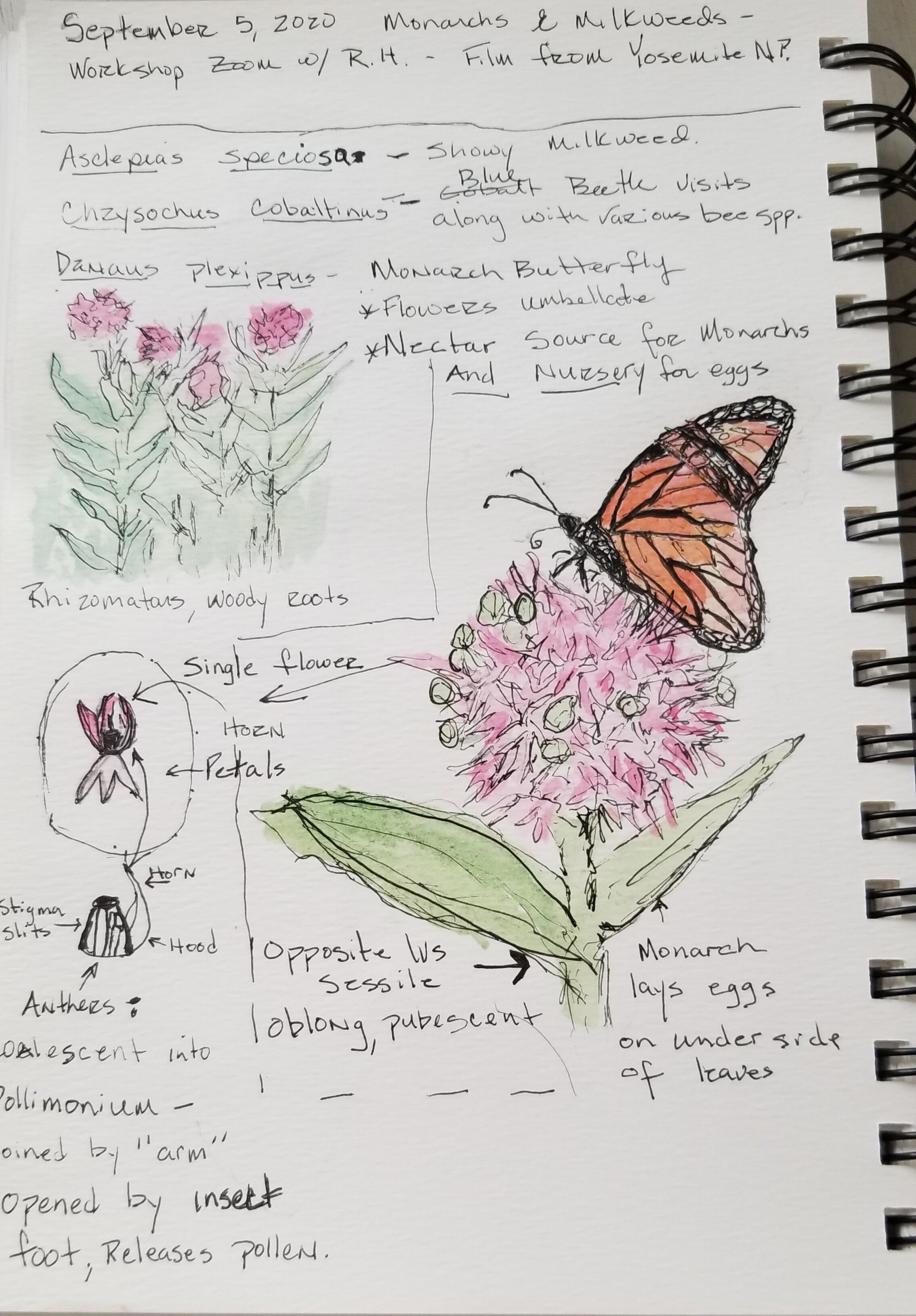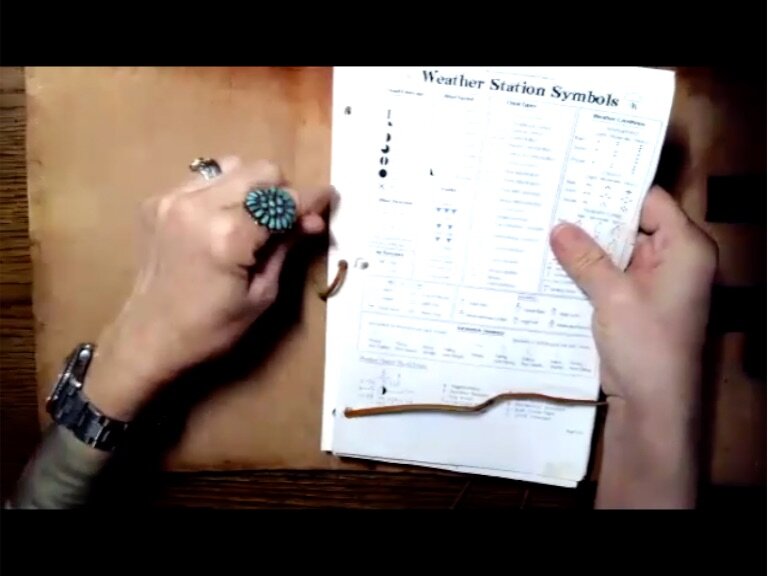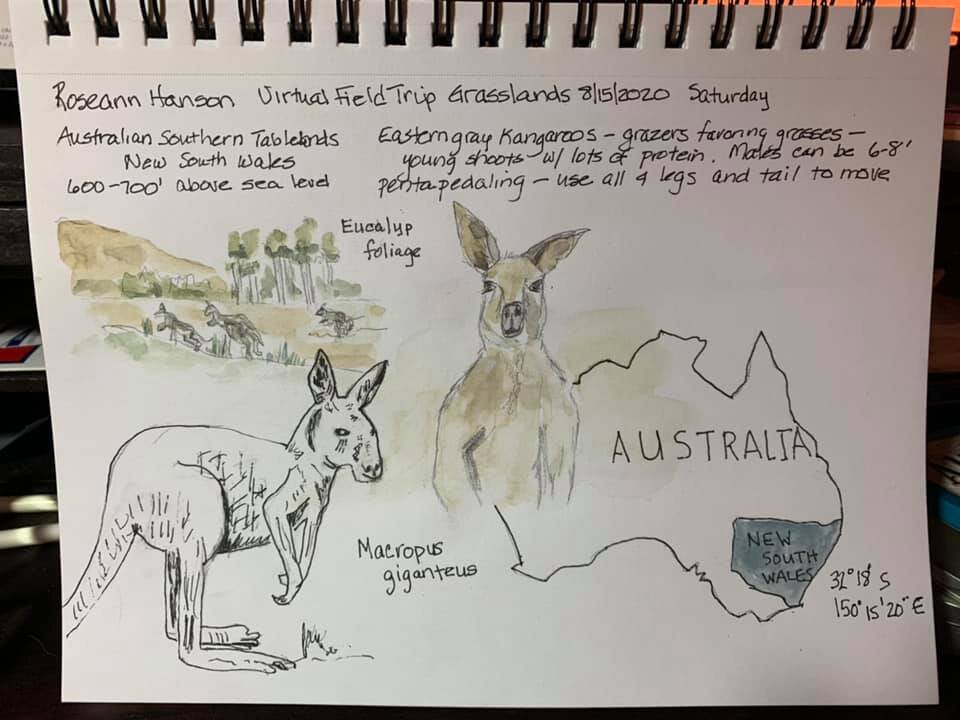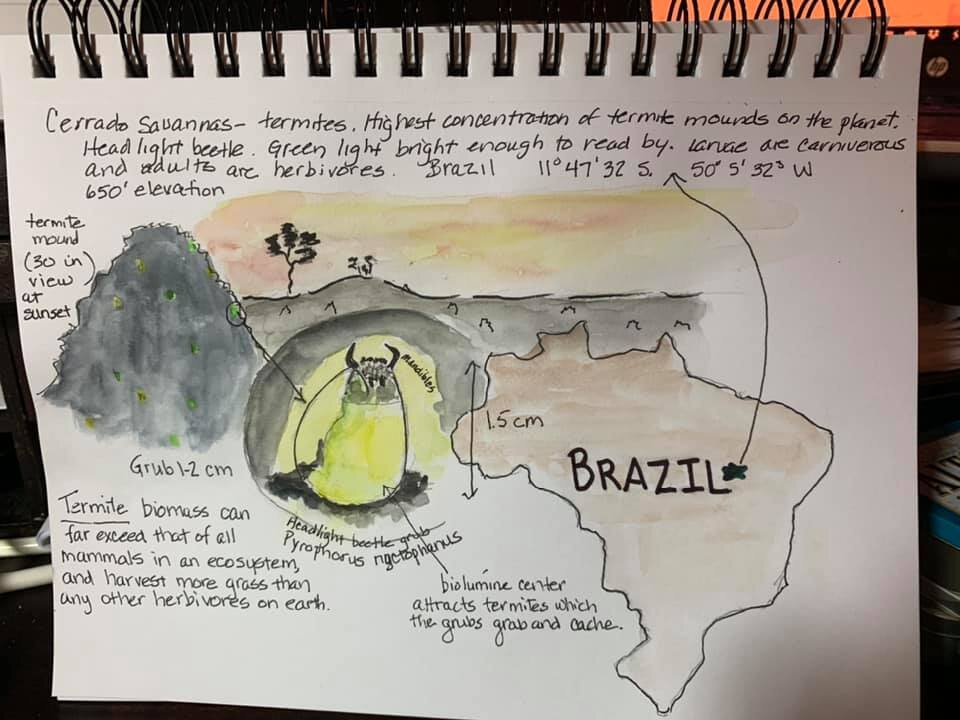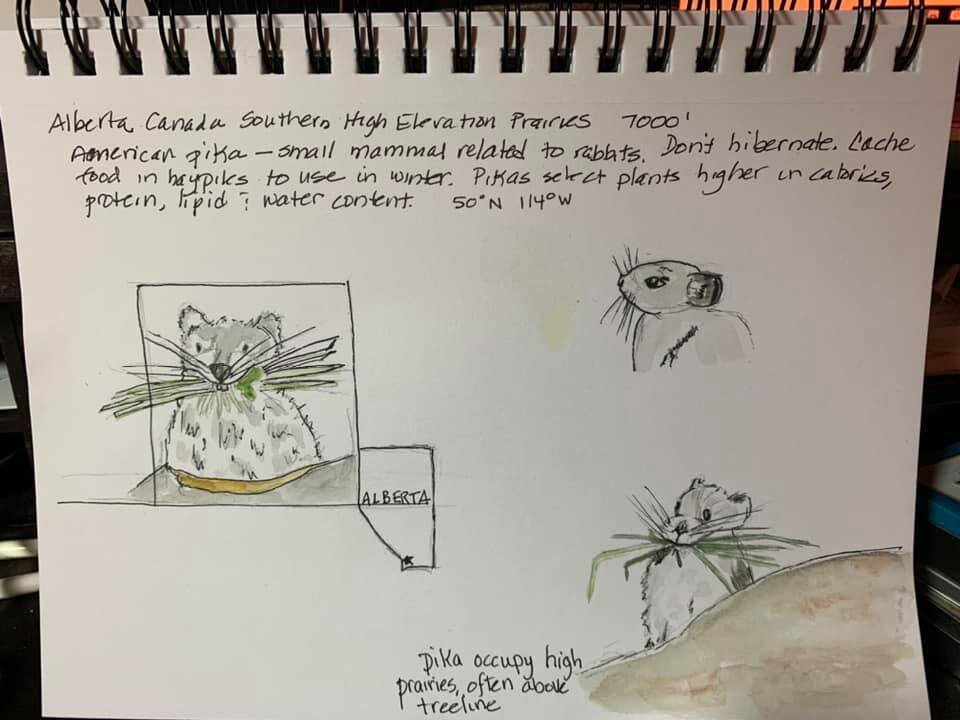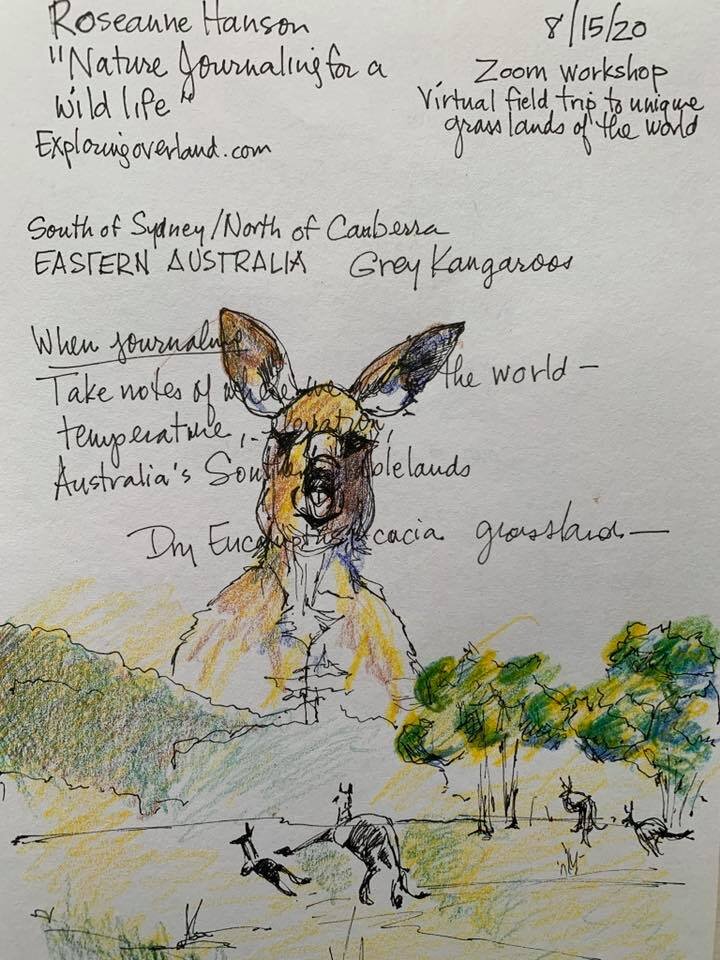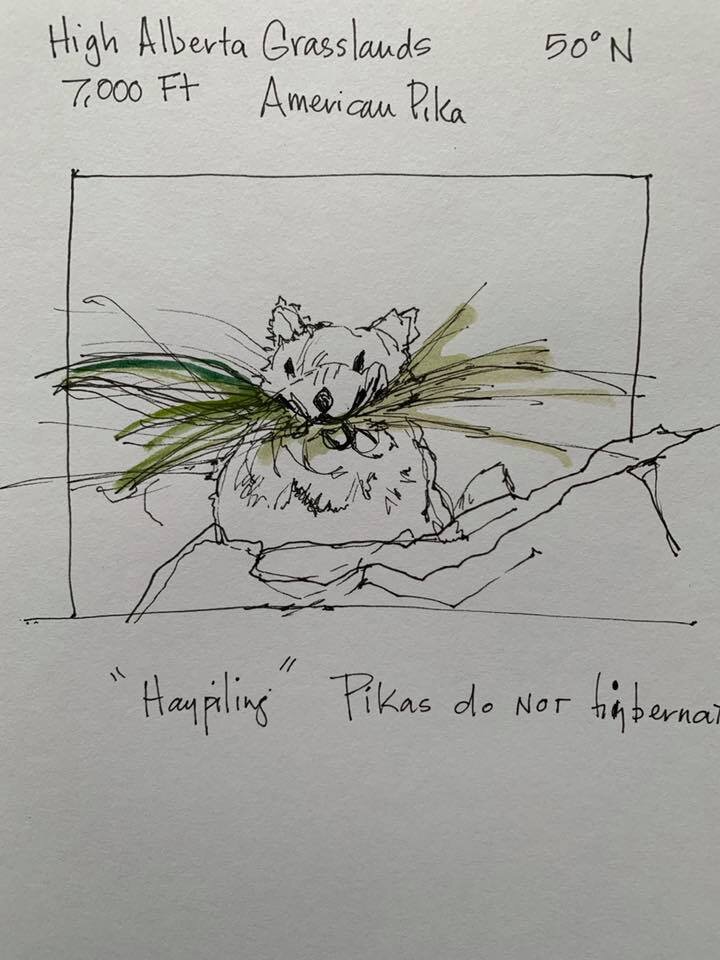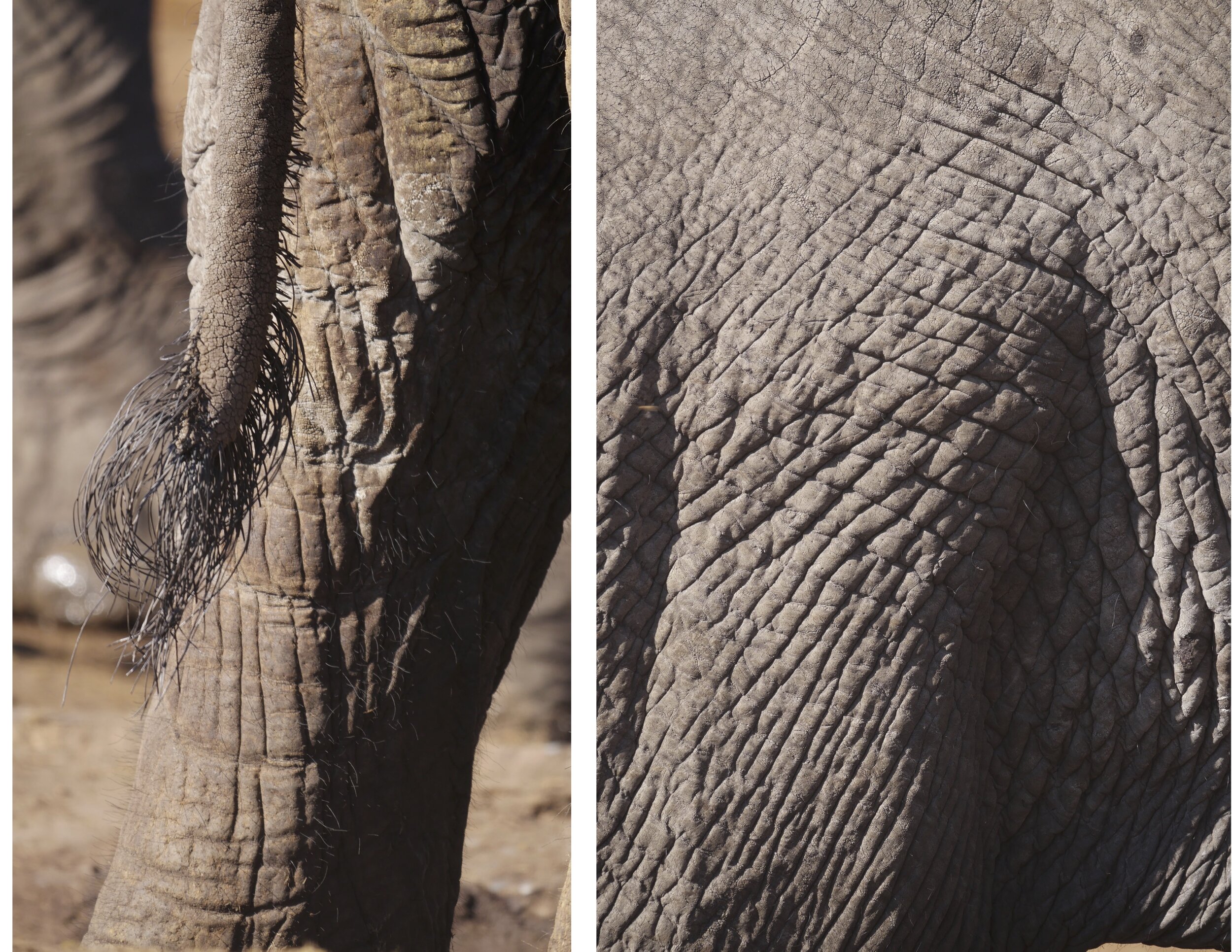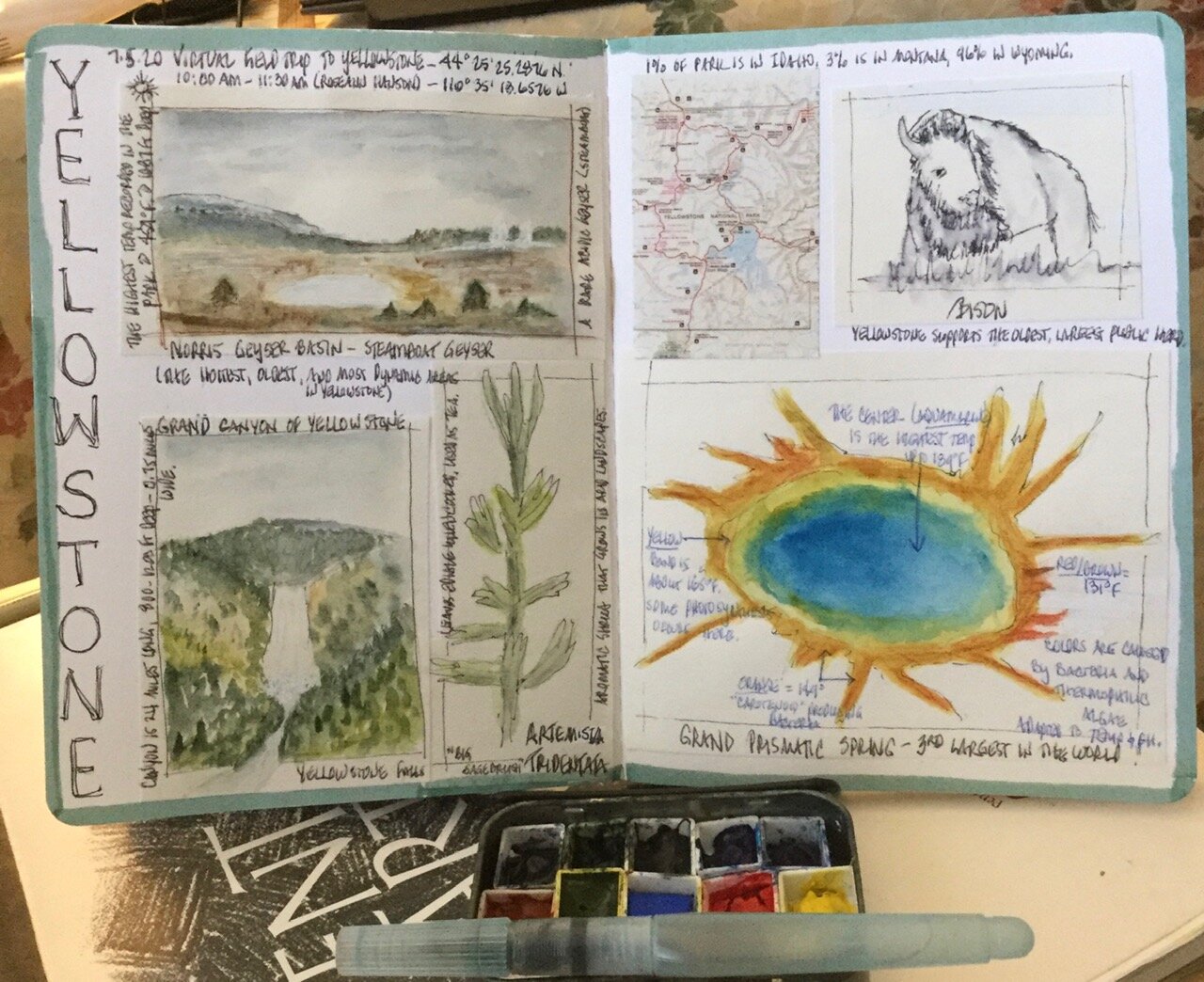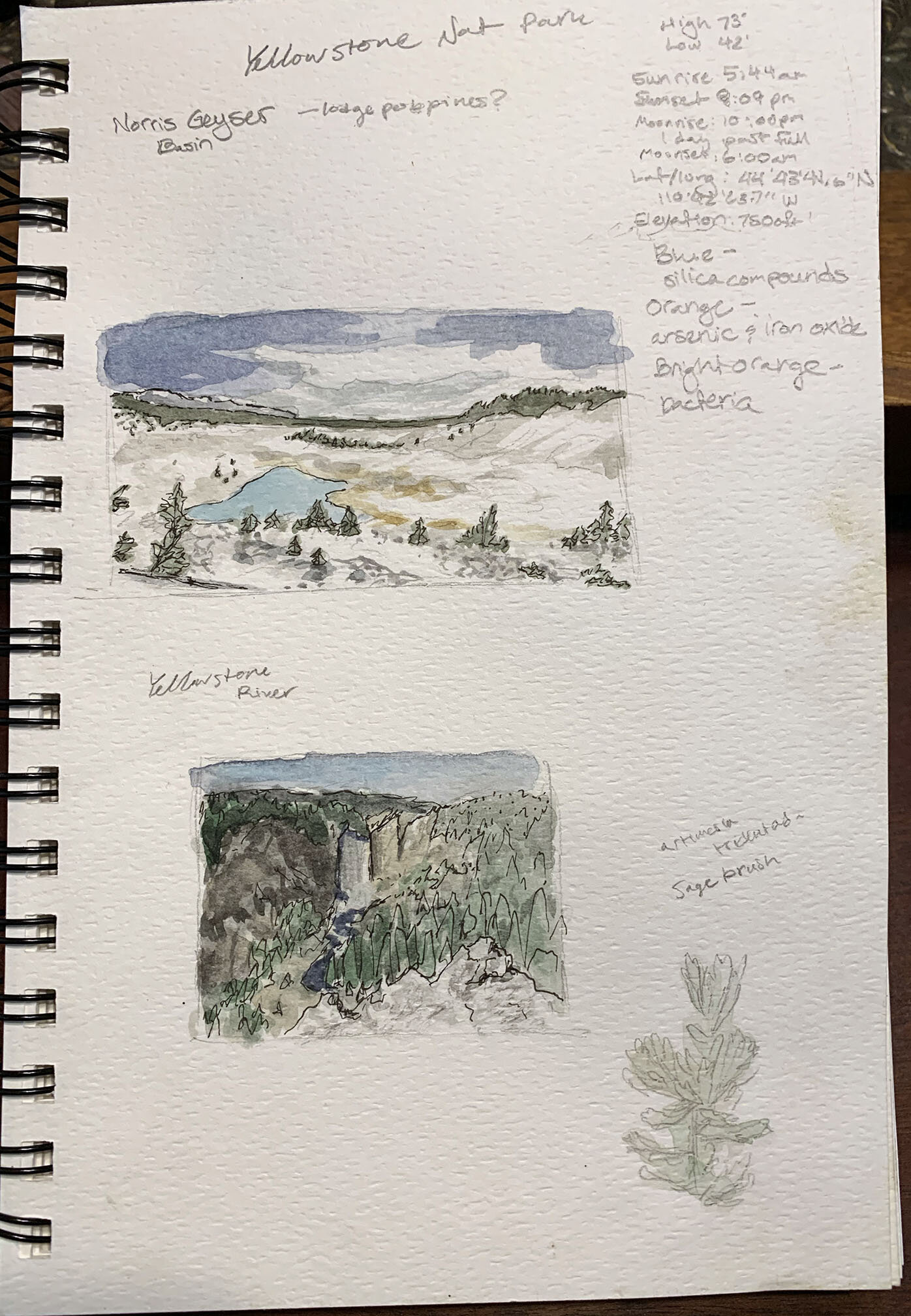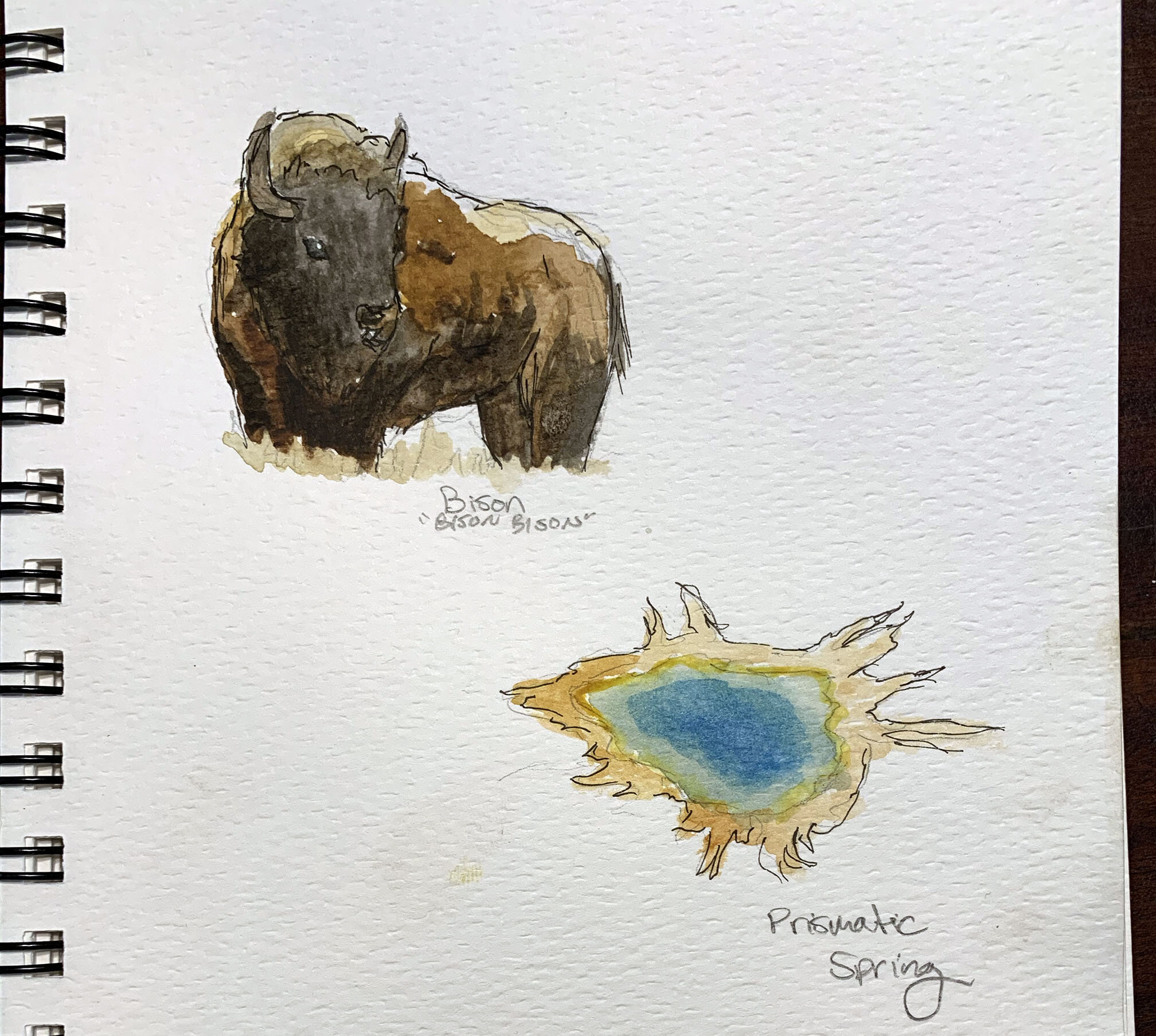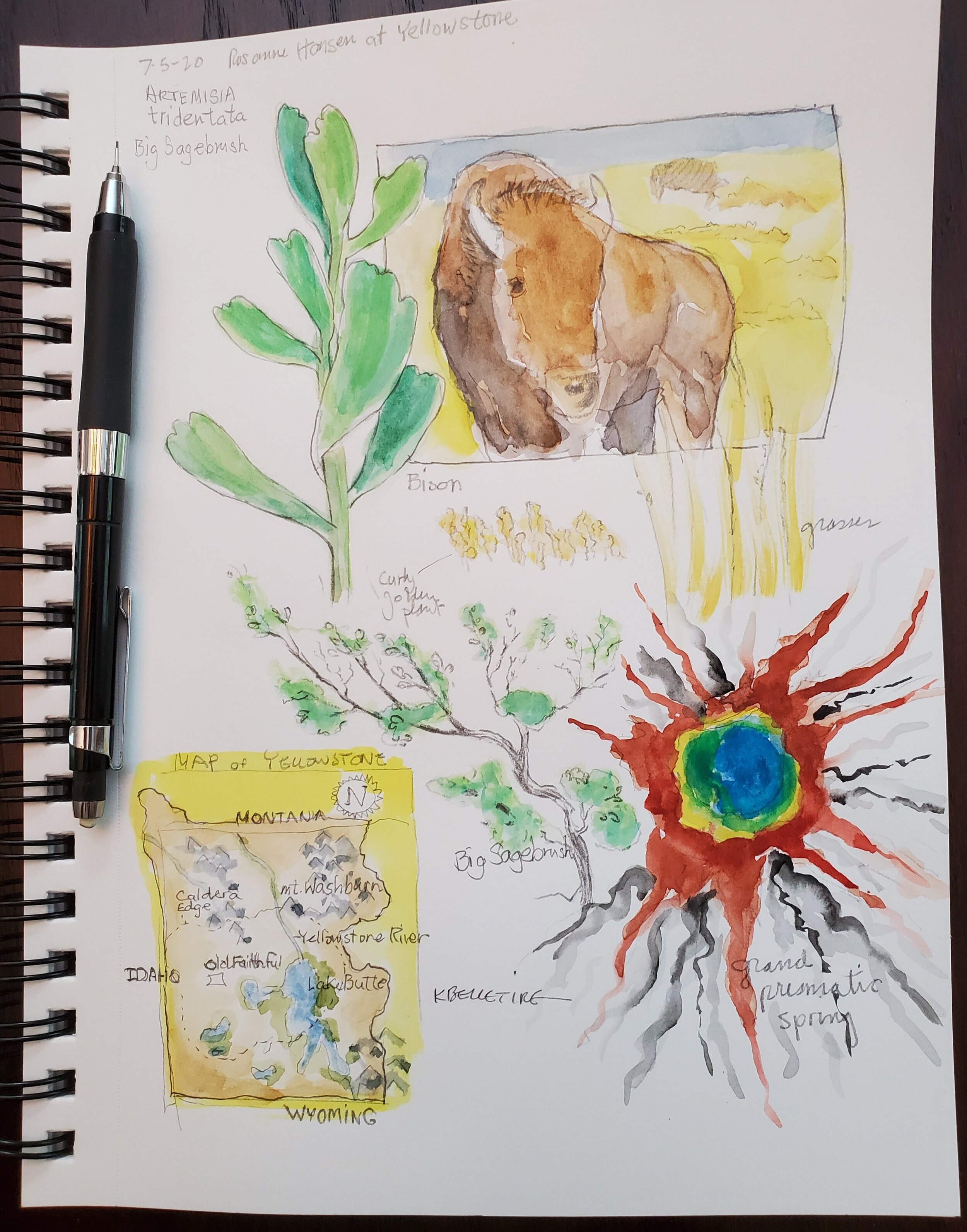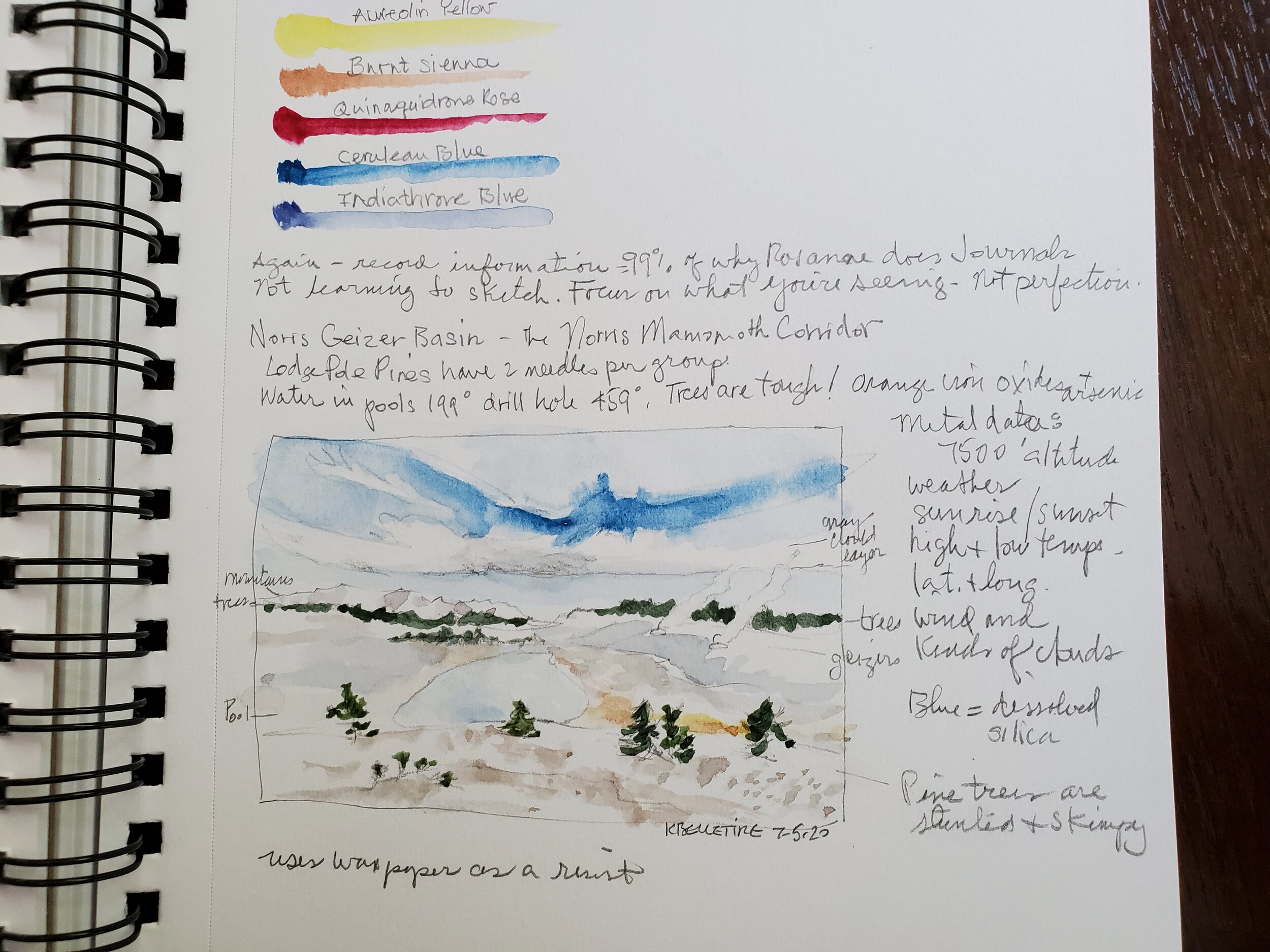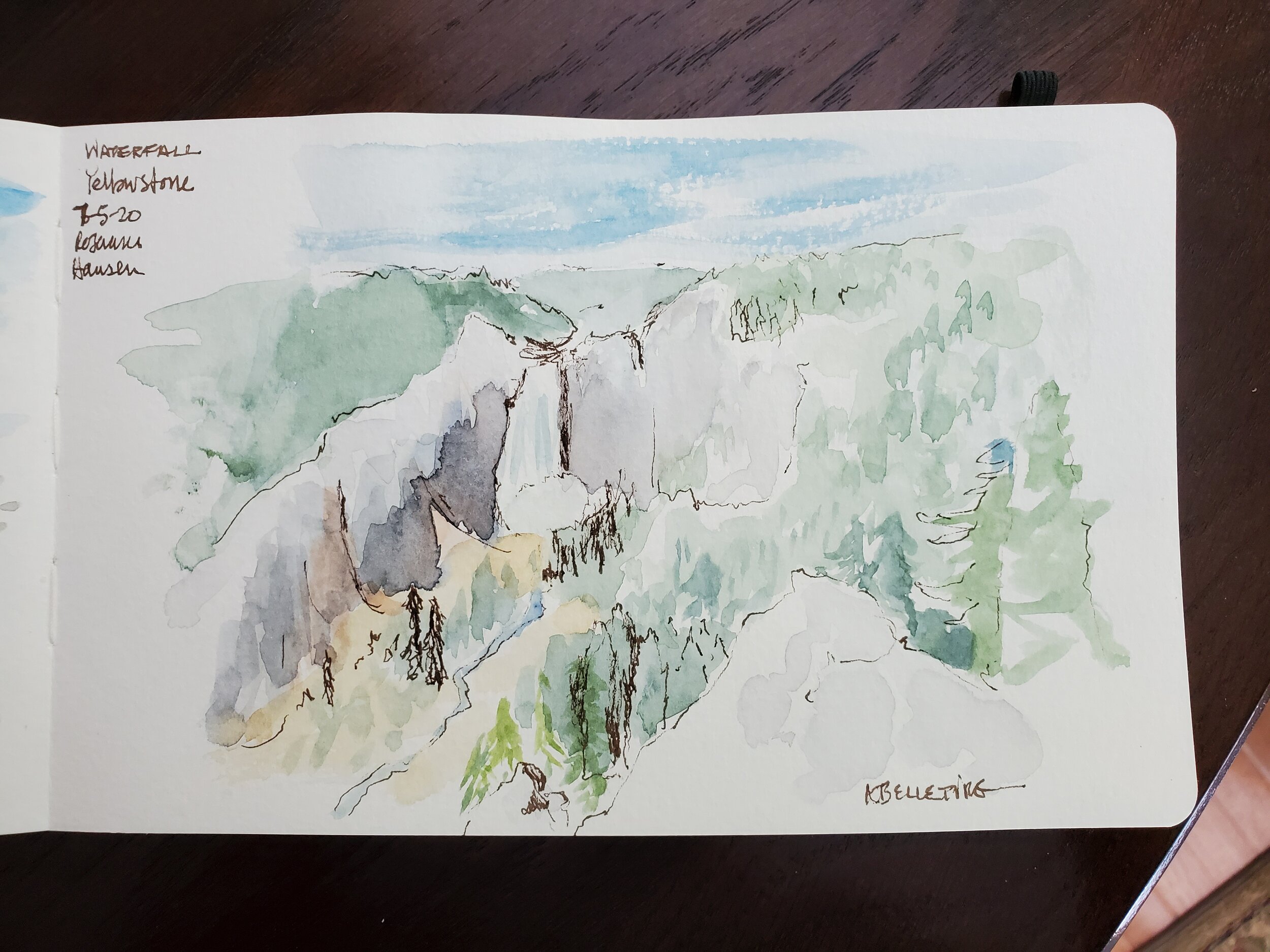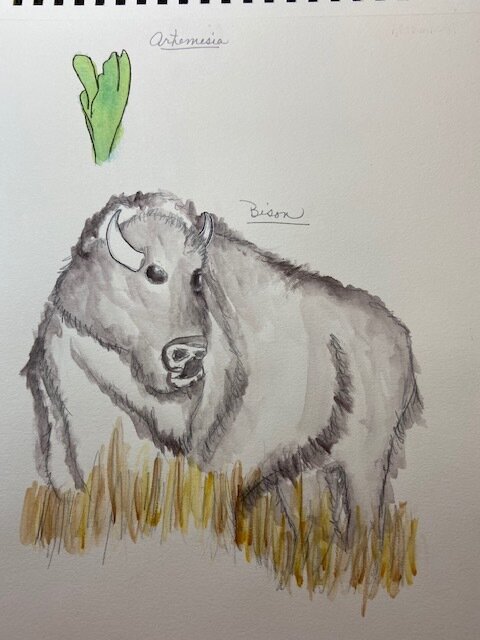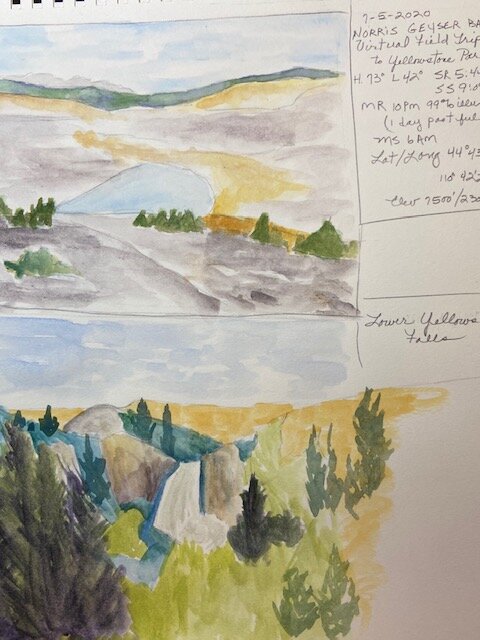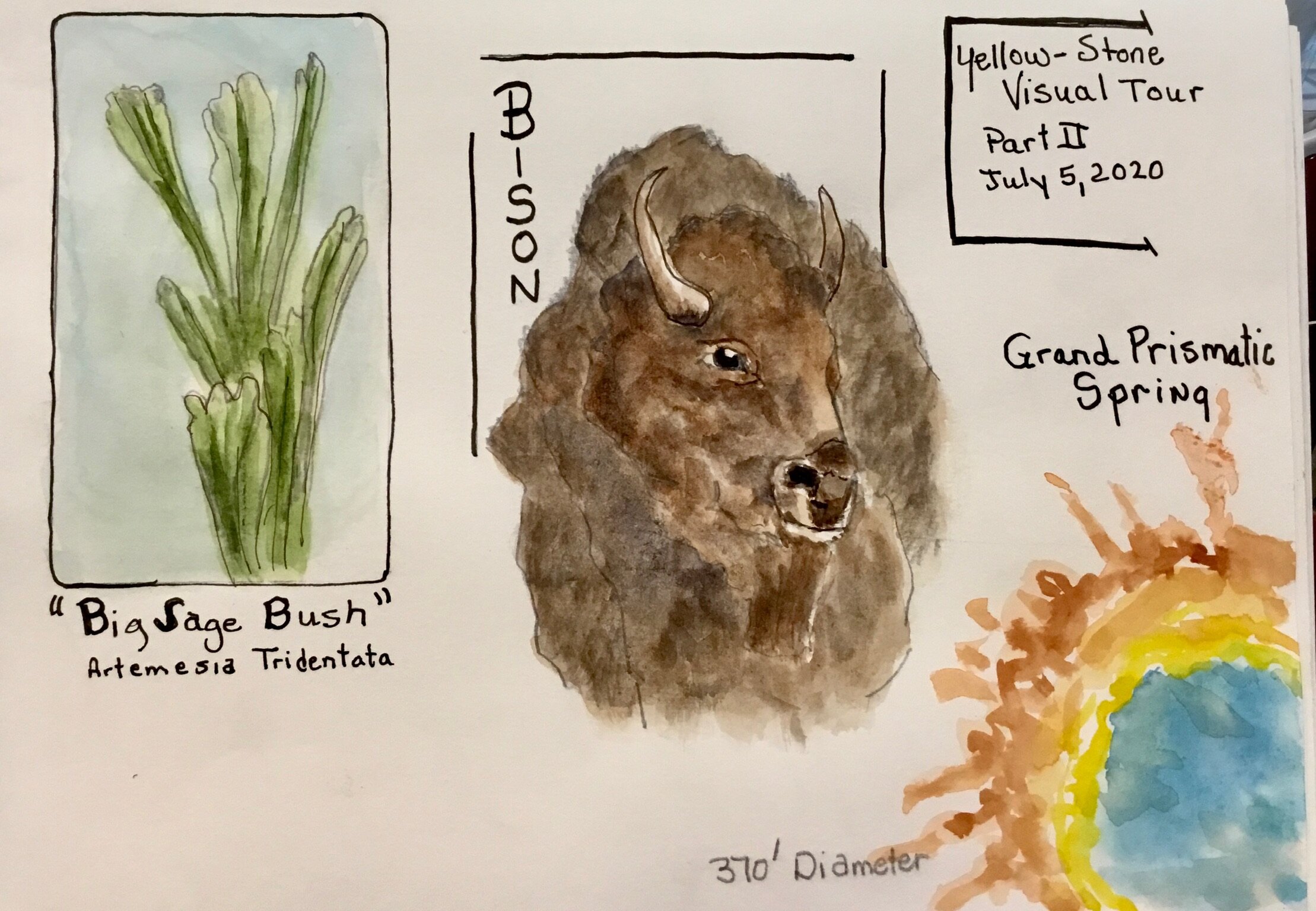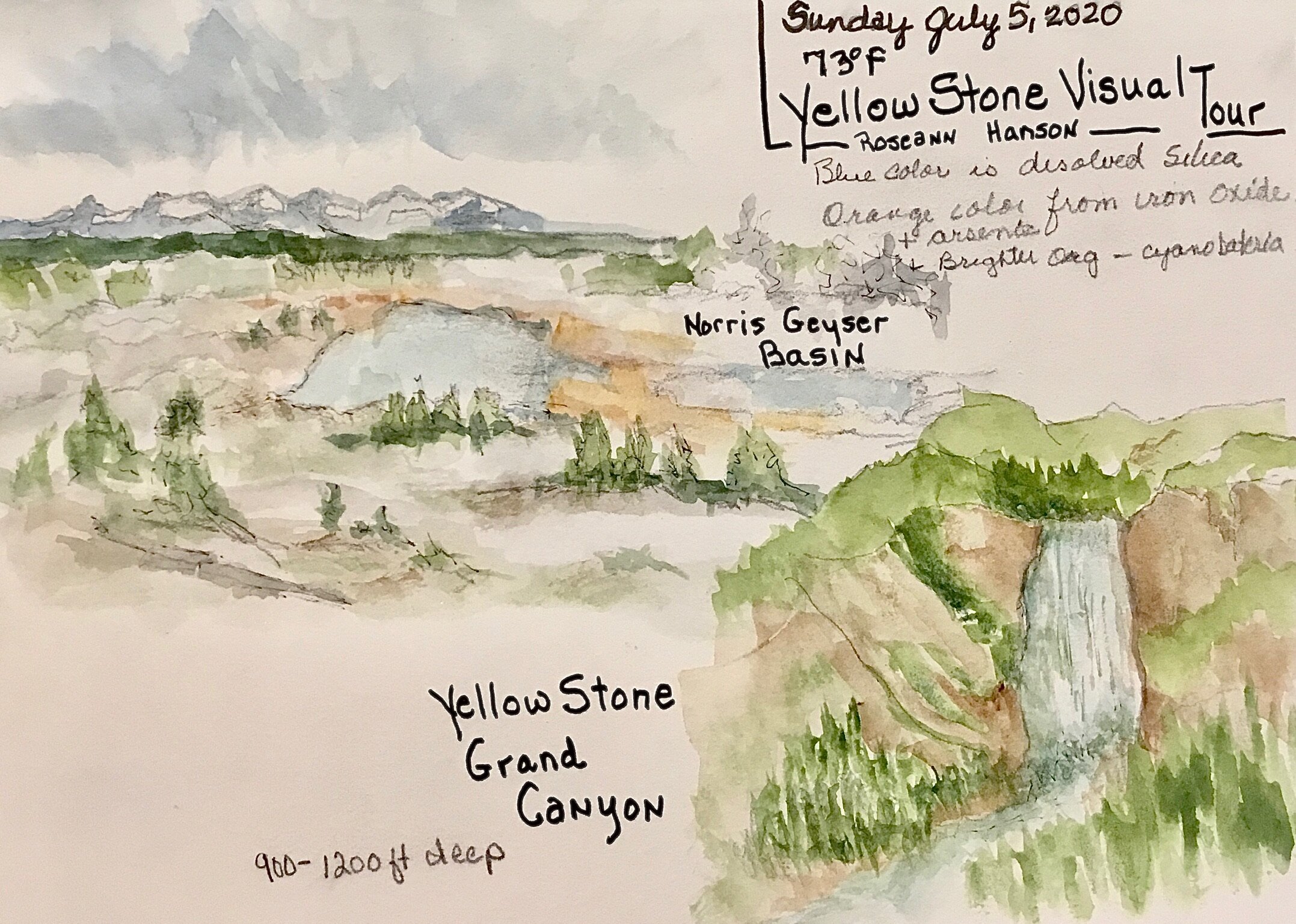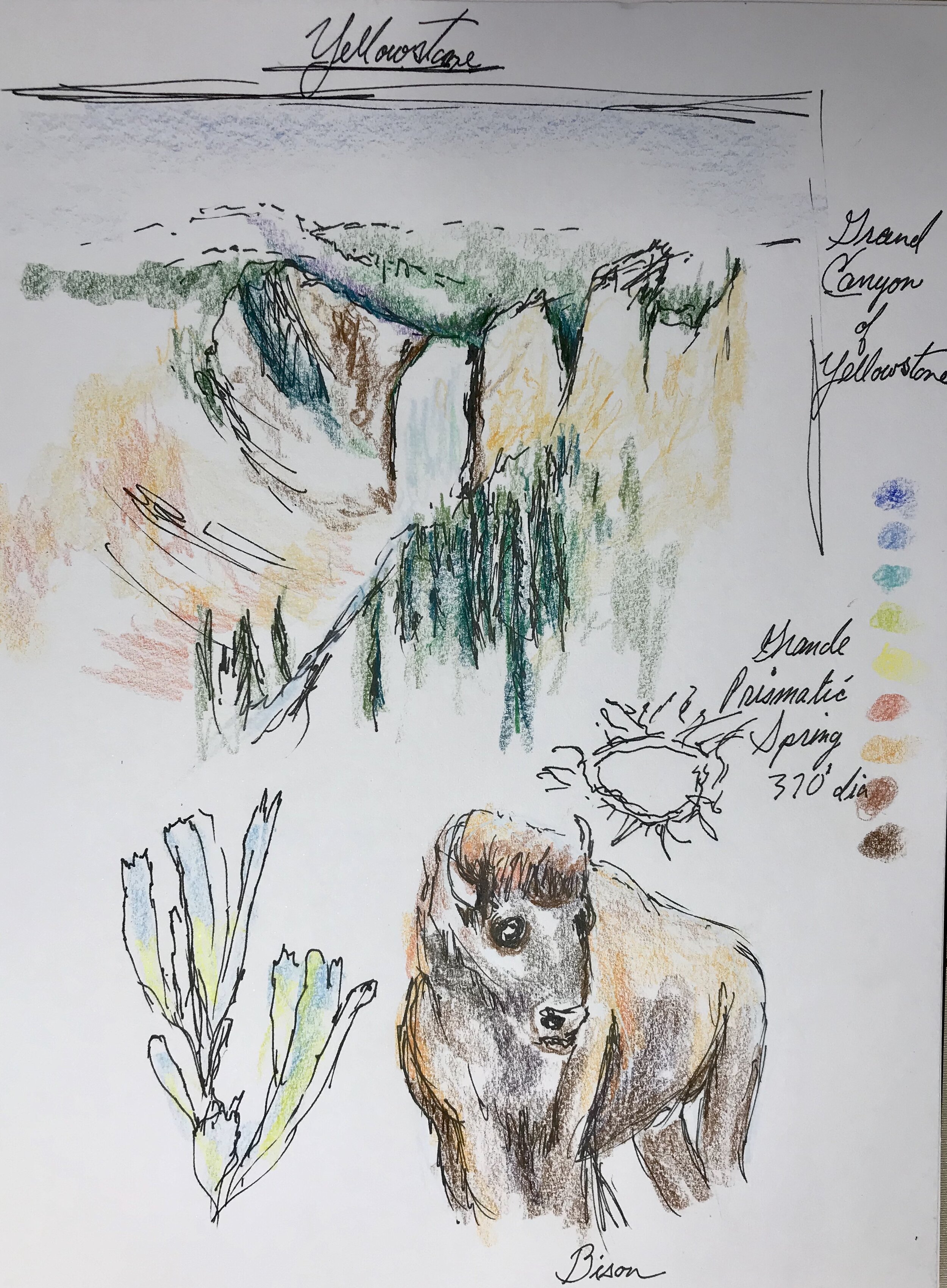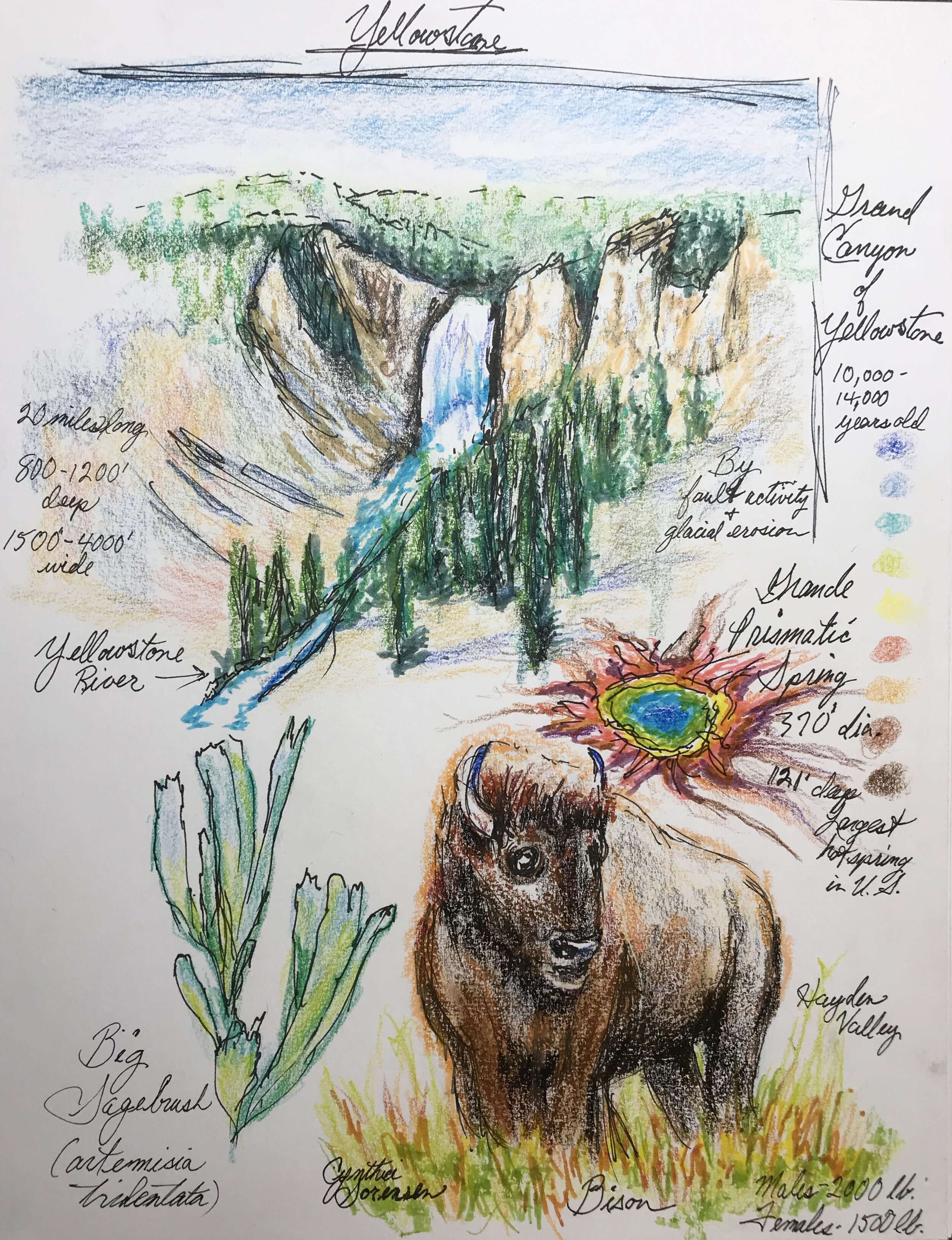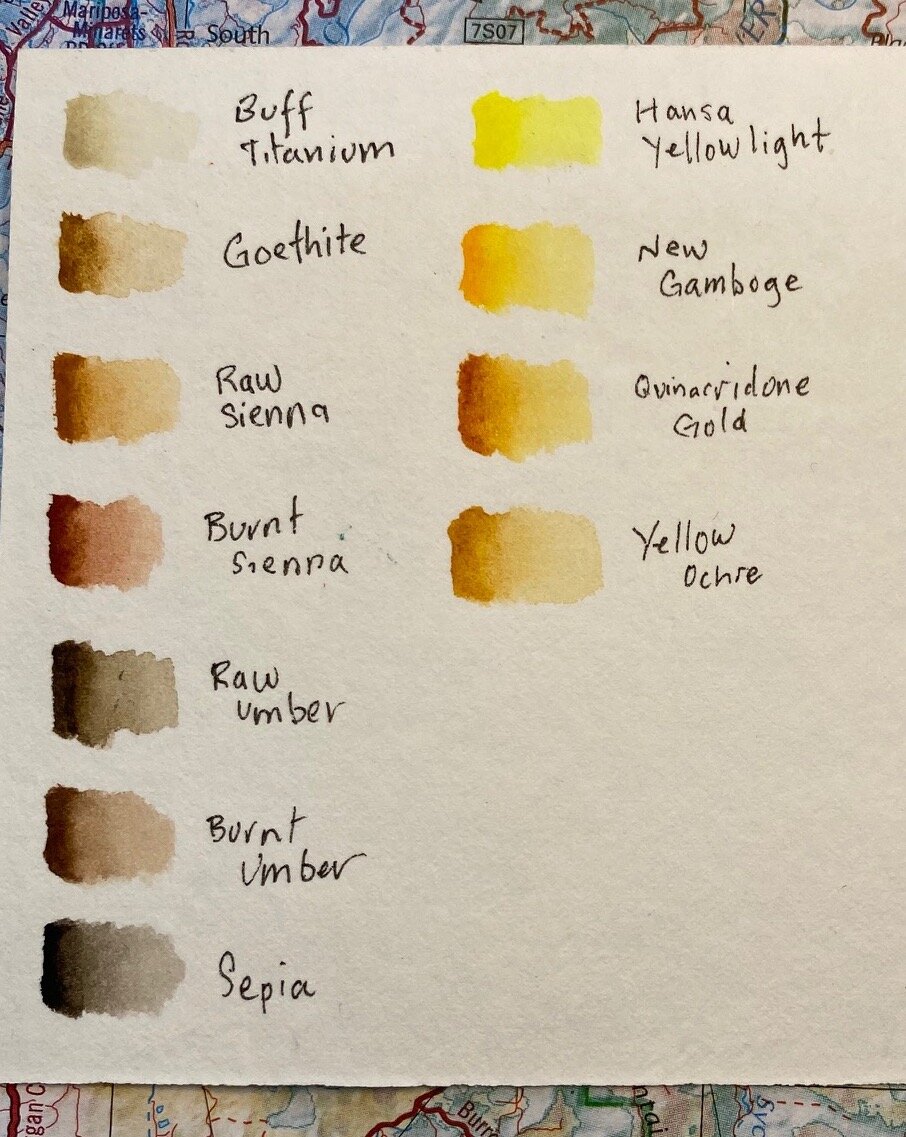Field Arts Workshop: Ancient Ochres
Human use of pigments to express ourselves may be—literally—a watershed moment in evolutionary time. Perhaps among the first to be used were iron oxides (ochres) such as at France’s famous Lascaux. Archaeologist Tammy Hodgskiss wrote: “People may say ochre is the earliest form of art and symbolism, but there’s more to it. Ochre shows how our brains were developing, and that we were using our environment. It bridges the divide between art and science.”
In this deep dive into the science of artistic pigments and look at our earliest history as artists, we will also learn to create beautiful images in our field notebooks and nature journals using natural earth pigments such as ochres (yellow, red, purple), manganese, lapis lazuli, graphite, and more.
Length: 2 hours
Resources from the Workshop
CHAT transcript — click > HERE <
Click to initiate download of a PDF of the workshop presentation: https://www.dropbox.com/s/qk9sp3baj3v8u7s/Ancient%20Ochres%2011-13-2021.pdf?dl=0
Pigment and natural paint sources:
Greenleaf & Blueberry – handmade in Colorado by Jess Greenleaf and her team, amazing quality and natural pigments
Clearwell Caves (you will need to call; scroll to the bottom of this page for pricing)
Natural Earth Pigments – great pigments and mulling equipment
Cornelissen & Sons – classic London colourists for artists for several hundred years
Kremer Pigments – fantastic source with full disclosure of pigment origins; lots to choose from in earth / iron oxides https://shop.kremerpigments.com/us/shop/pigments/
For the Love of Soil – women-owned who are also soil scientists
Beam Paints – indigenous women-owned; I don’t have personal experience with the quality of these paints
Natural pigment demo landscapito of Cave Creek Canyon in the Chiricahua Mts., southeast Arizona; pigments from top to bottom: Chiricahua Red Ochre (wildcrafted by Roseann); Yellow Ochre (Greenleaf & Blueberry); Sleeping Beauty Turquoise (Daniel Smith); Lapis Lazuli (made by Roseann from pigment from Cornellisen & Sons, London); Point Reyes Quaternary Dune (wildcrafted by Roseann).
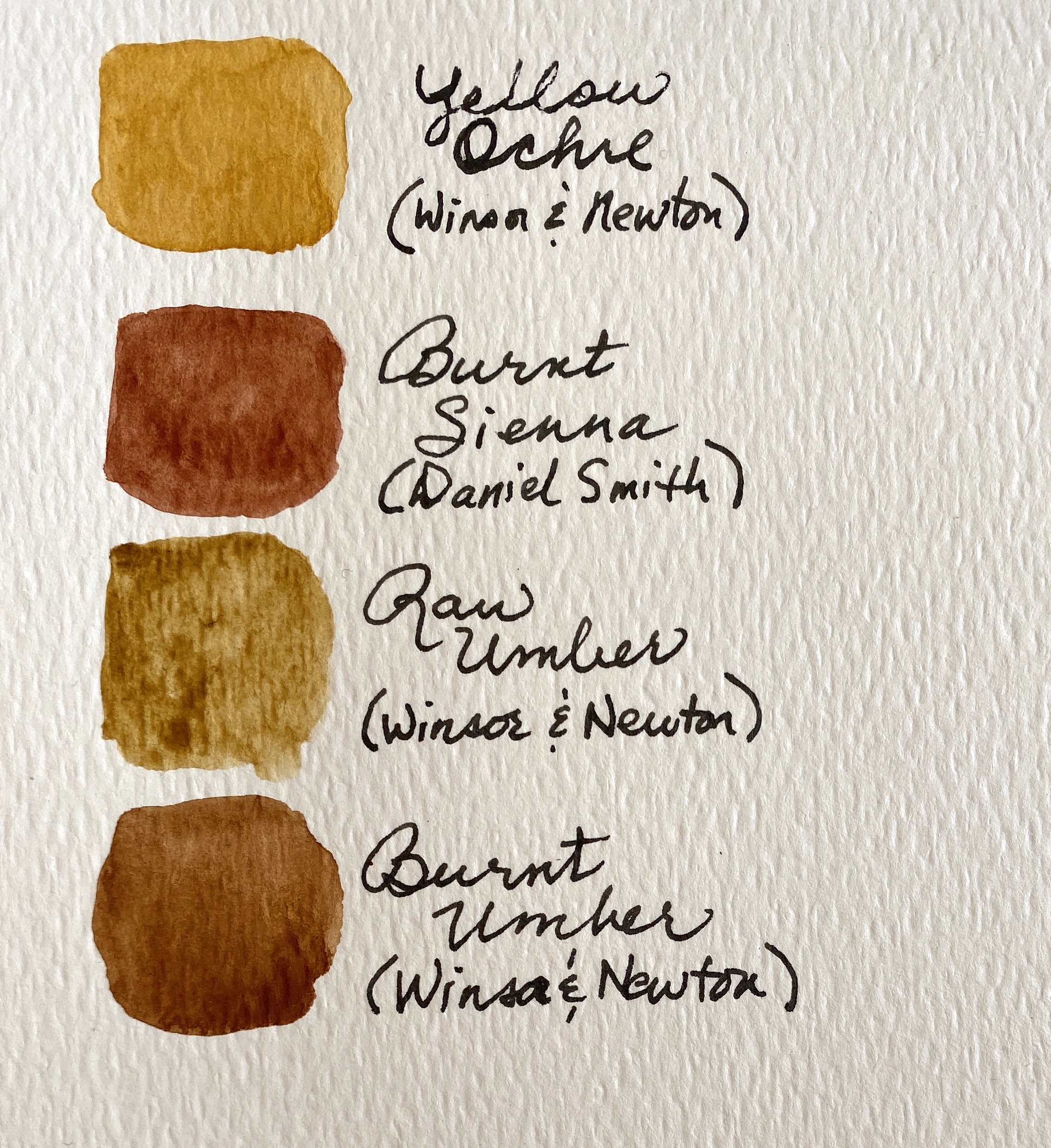
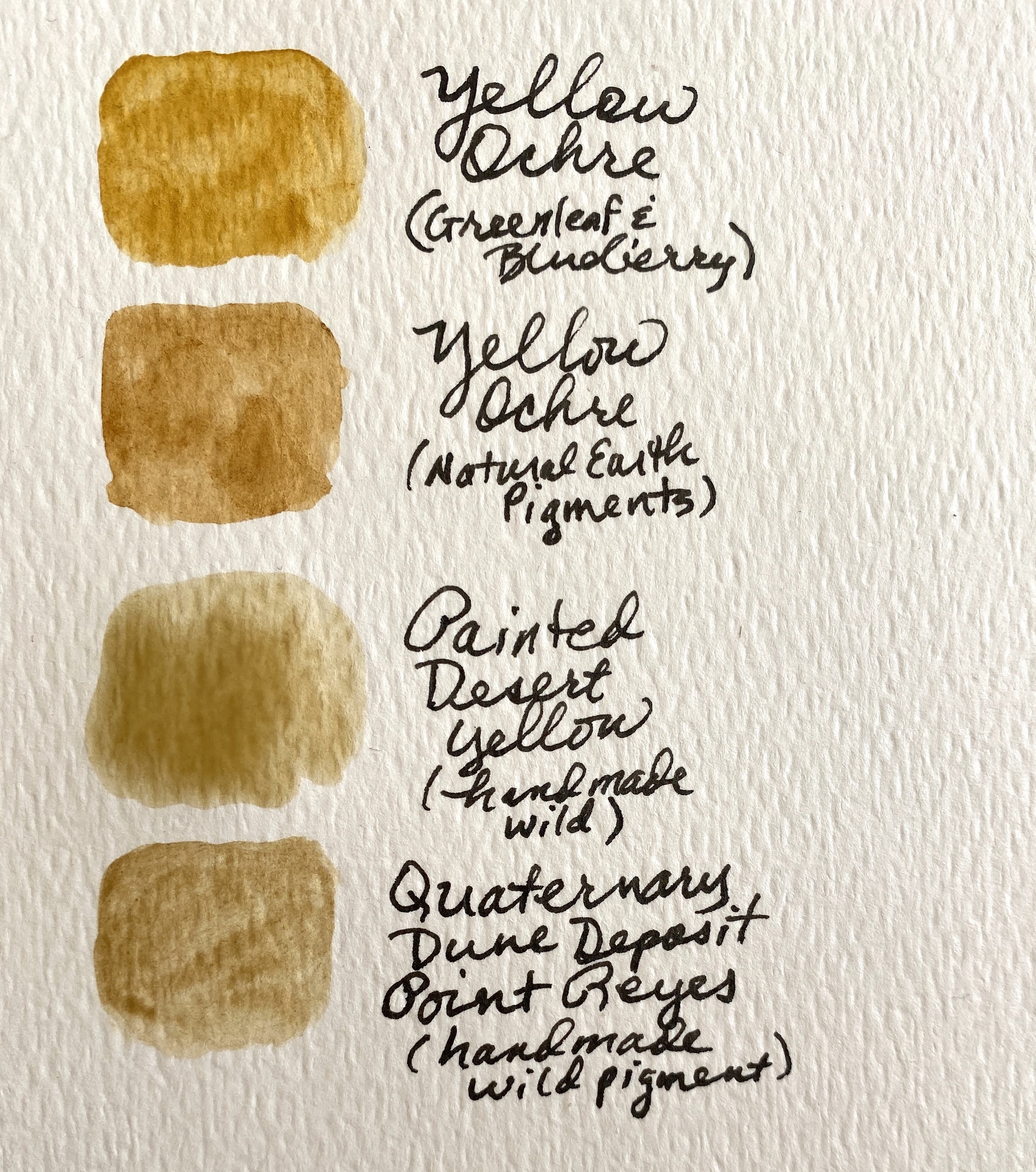
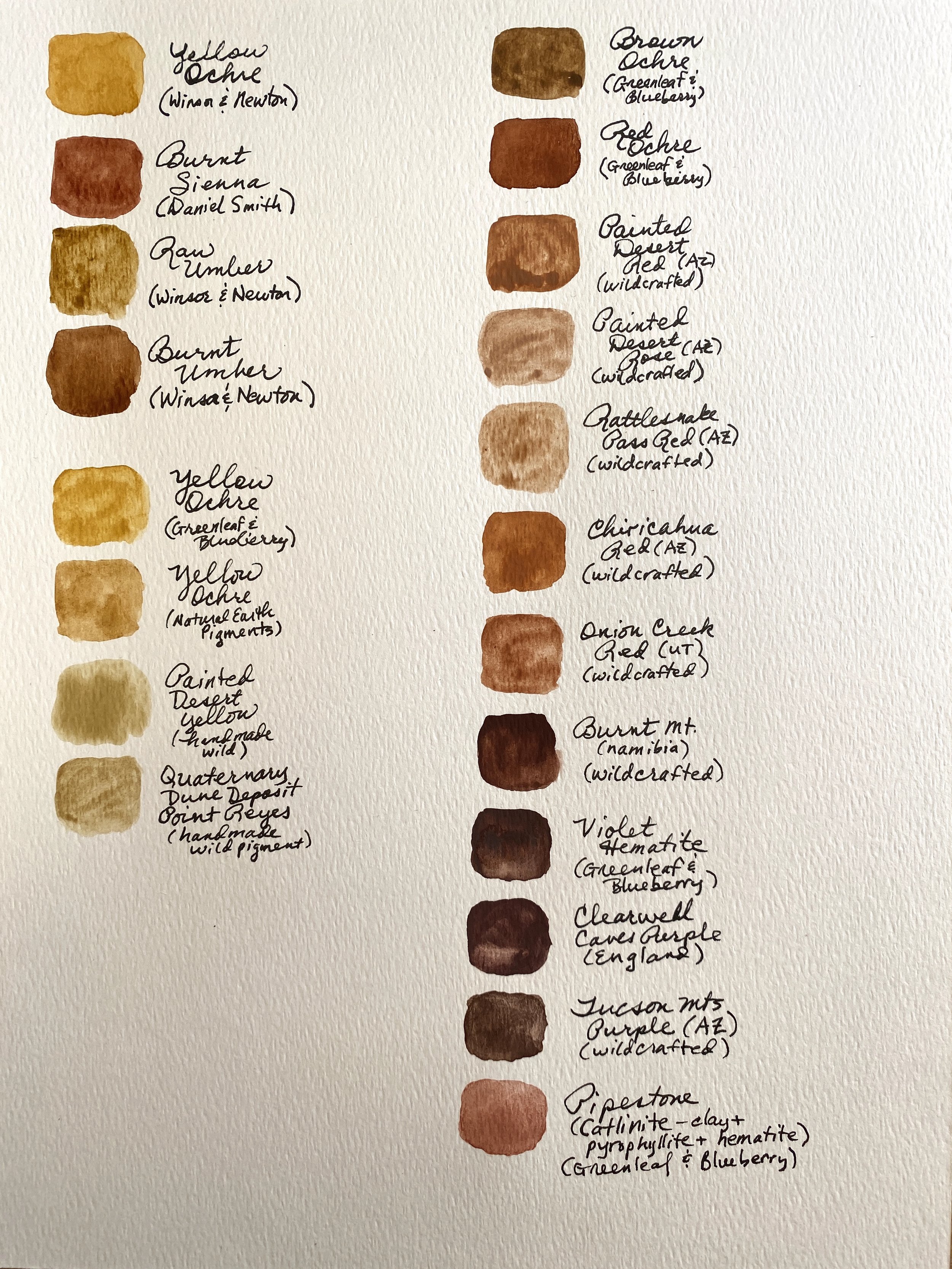
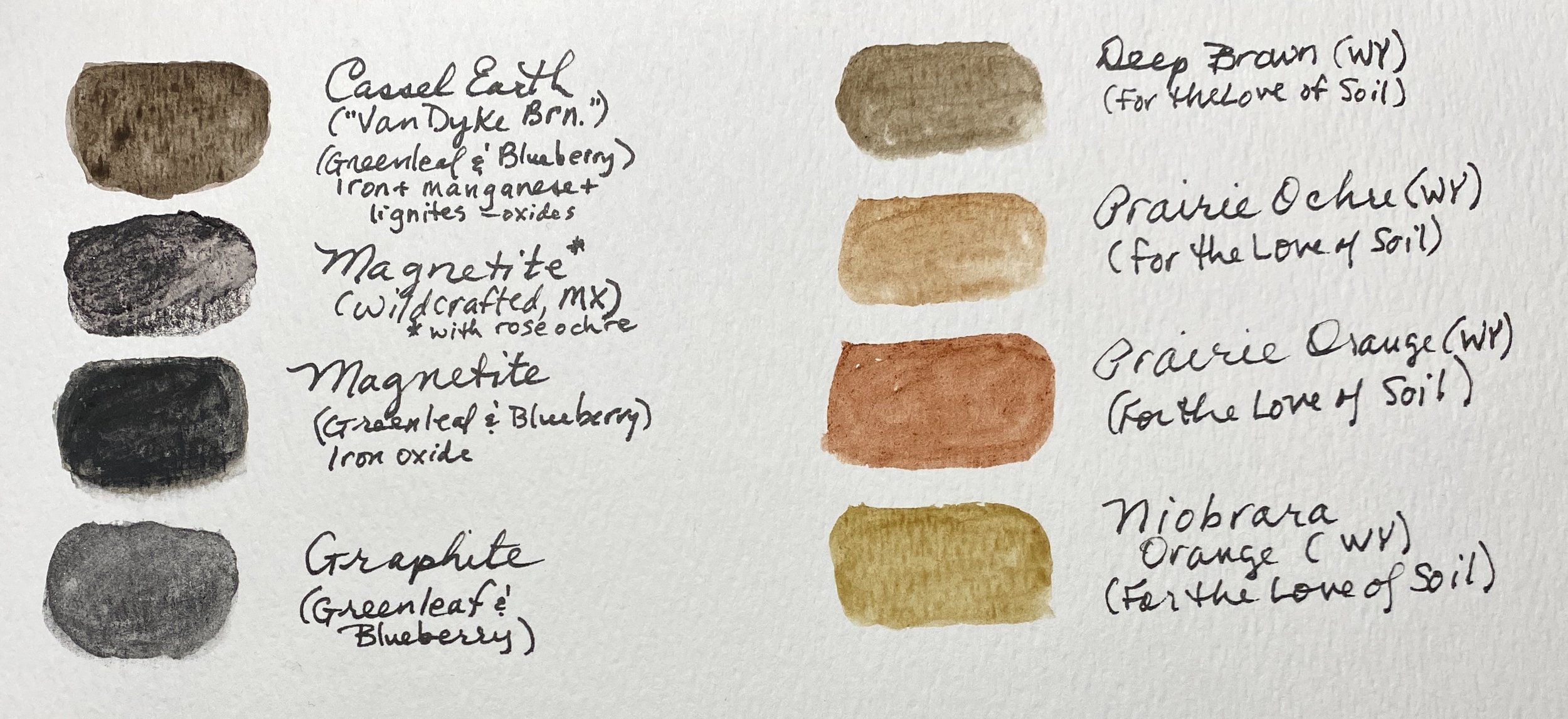
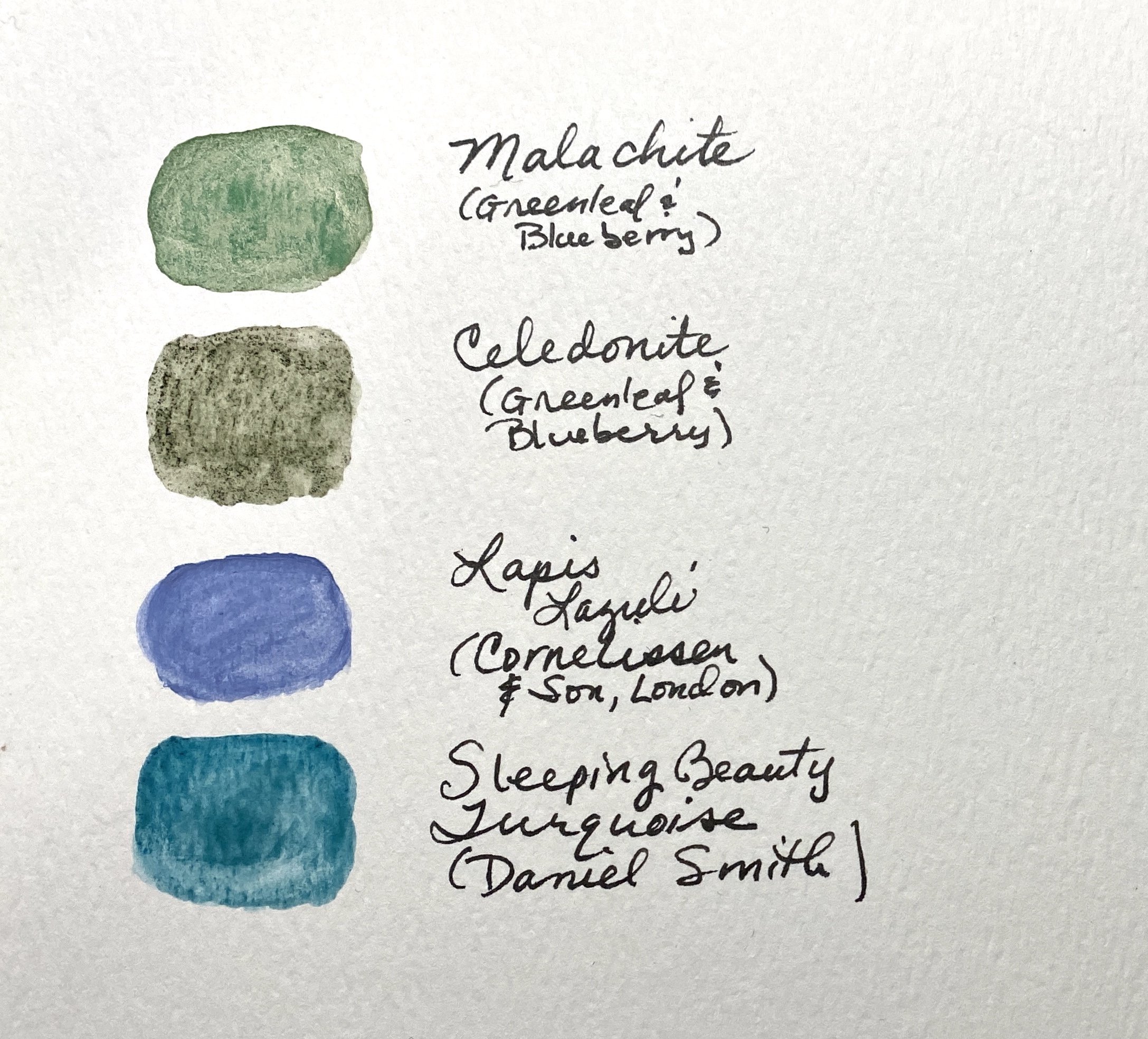
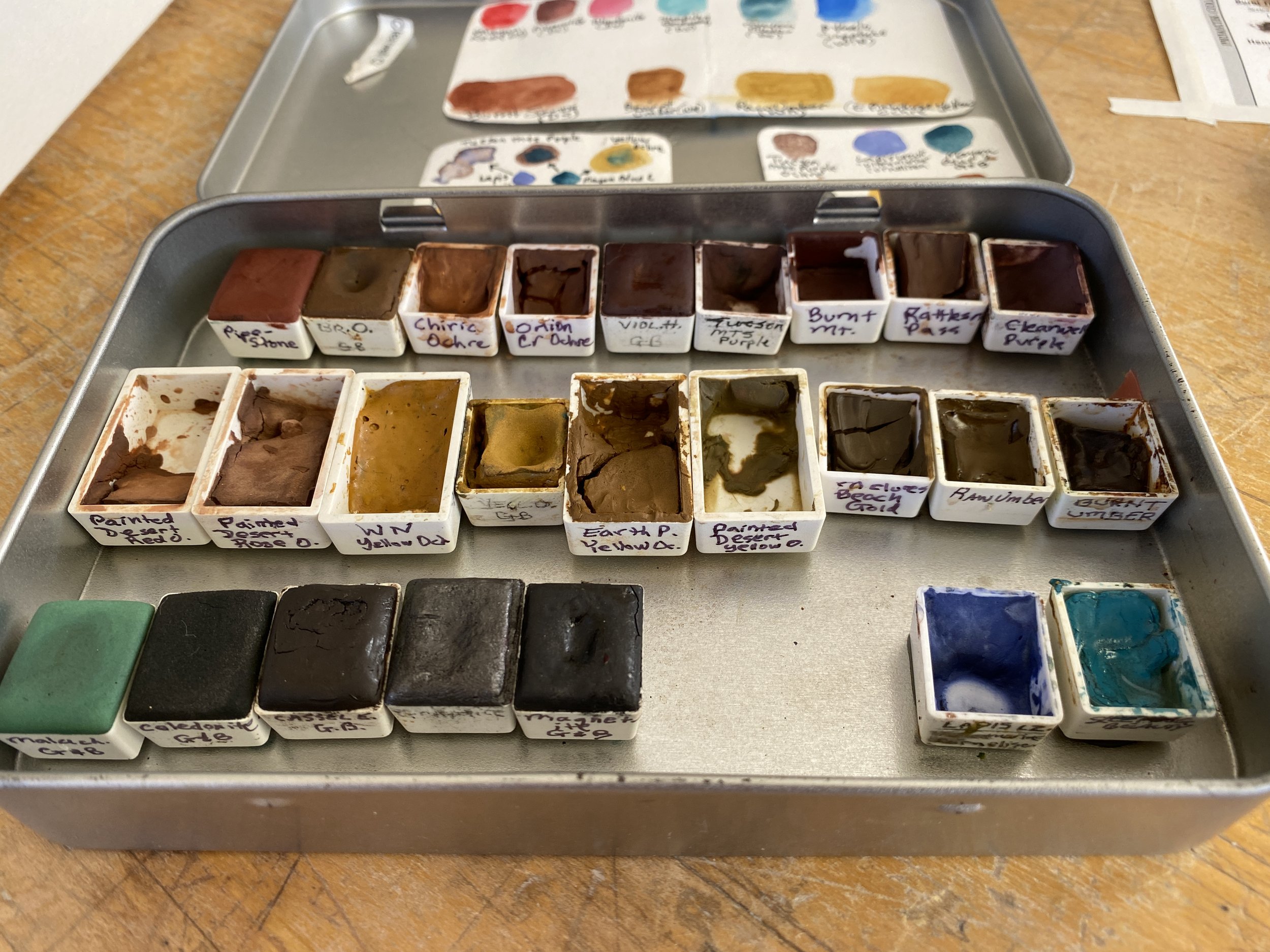
Images from Workshop Participants
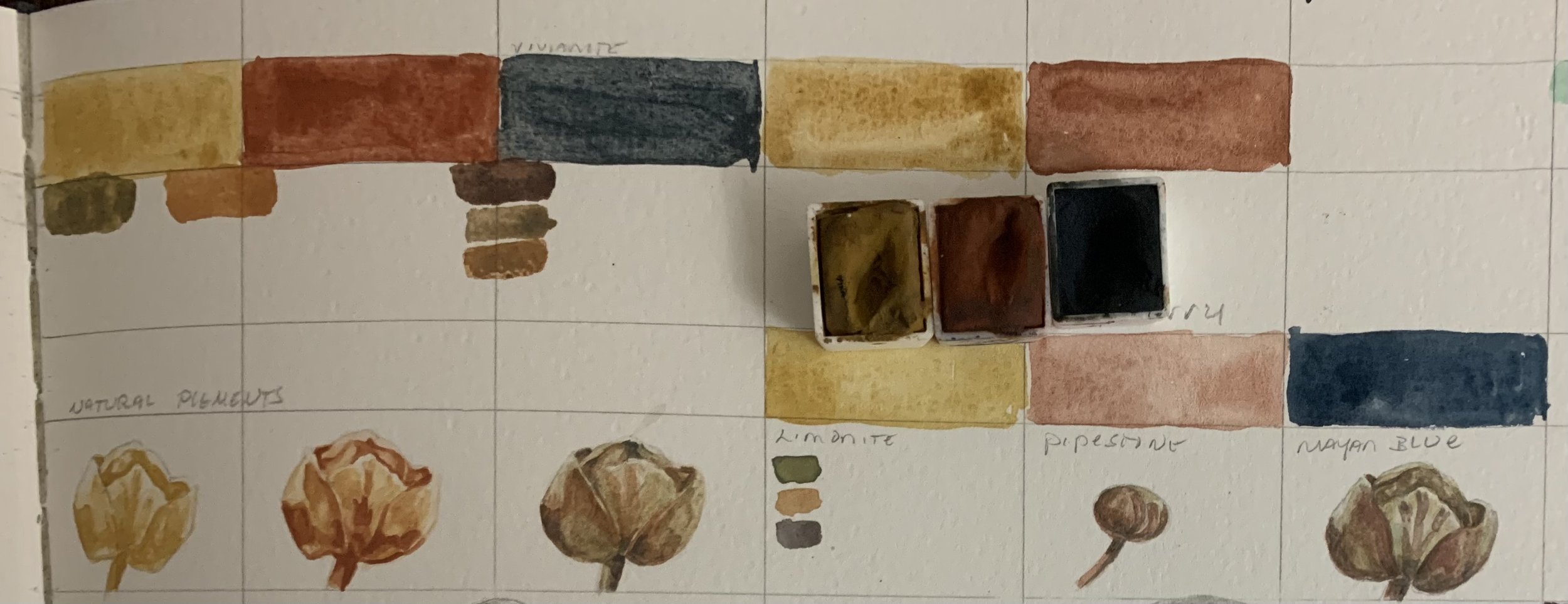
Virtual Field Trip to Arctic Alaska
I recently returned from a two-week exploration of the Alaskan high and middle Arctic—and fell in love! I'd love to take you there, so jump aboard as we head back to Point Barrow and Uqtiagvik, and then journey up the "haul road" to Prudhoe Bay, enjoying the Brooks Range and looking for caribou and muskox. [You can view my journal pages from my journey by clicking the link above.]
Length: 2 hours
Resources from the Field Trip
To access the Virtual Field Trip online, my interactive journey with dozens of images and videos and maps: https://360exploring.s3.us-west-1.amazonaws.com/Arctic+Alaska/output/index.html
CHAT transcript — click > https://www.dropbox.com/s/epenu1vs7lxtkgl/Chat%20Transcript%20Virtual%20Field%20Trip%20Alaska.pdf?dl=0
Click image at ABOVE to initiate download of the workshop PDF with all the information. Or, use: https://www.dropbox.com/s/xhbhlextkbvnr4v/Alaska%20Virtual%20Field%20Trip%2010-2021.pdf?dl=0

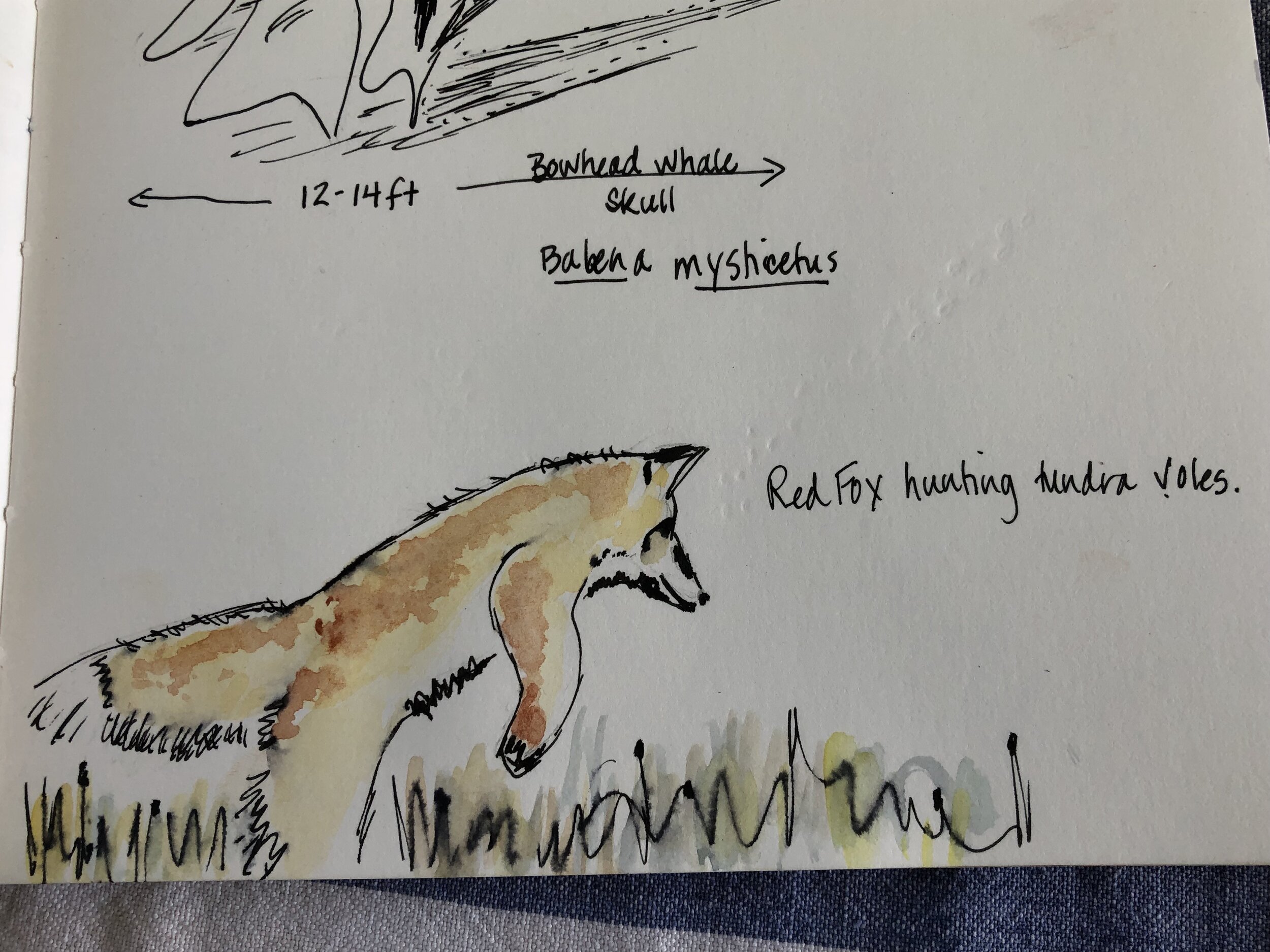

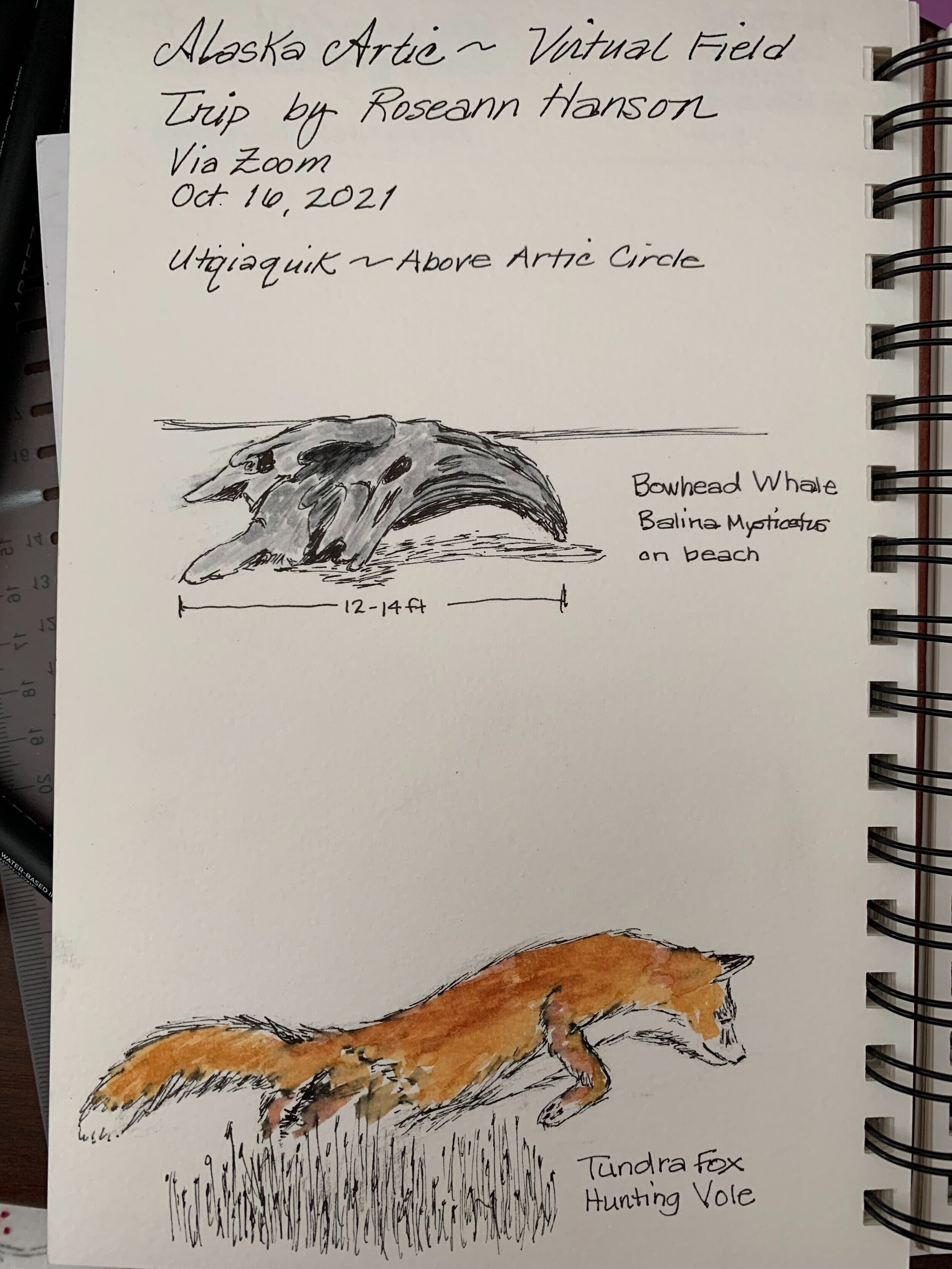

Field Arts Workshop: Elegant Ink for Field Notebooks
Join me for a celebration of the art of elegant ink in our sketchbooks. While I do love color in my journal, I also love the beauty of well-wrought pen sketches.
We’ll cover types of pens and inks (from ballpoint to fountain pens, including the pluses and minuses of the types); practice mark-making and values; and work on a couple of different types of sketches using one image to create each, so we can see how different styles of linework each produce a different “feel” on your pages.
Length: 2 hours
Images at right: Creating various “palettes” for your marks is a great exercise and very useful to keep tucked in a pocket of your journal for reference. The different types of stroke, texture, and tone are like words in a language or paint colors in a palette: you choose each for a different effect, feel, tone, or emphasis.
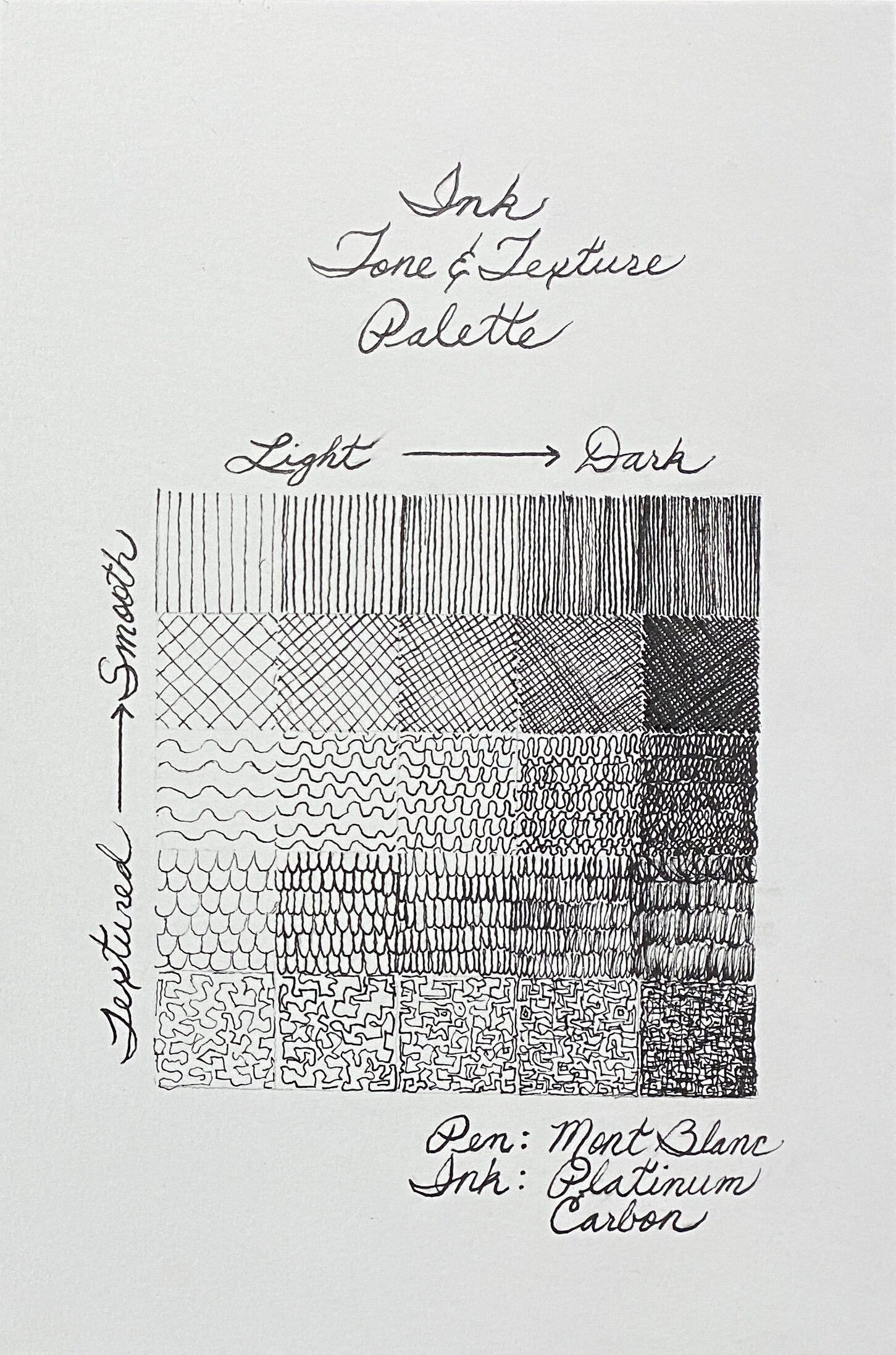

Resources from the Workshop
CHAT transcript — click > HERE <
Click image BELOW to initiate download for the workshop PDF with all the information, sample images, and links. Or, use: https://www.dropbox.com/sh/rvlzr0a9hezdgjr/AACw6pH9jwhj6sQ-rvmM_GGwa?dl=0
Bonus! I did a short video (no sound) of how to clean and refill a fountain pen:
DEMOS FROM THE WORKSHOP



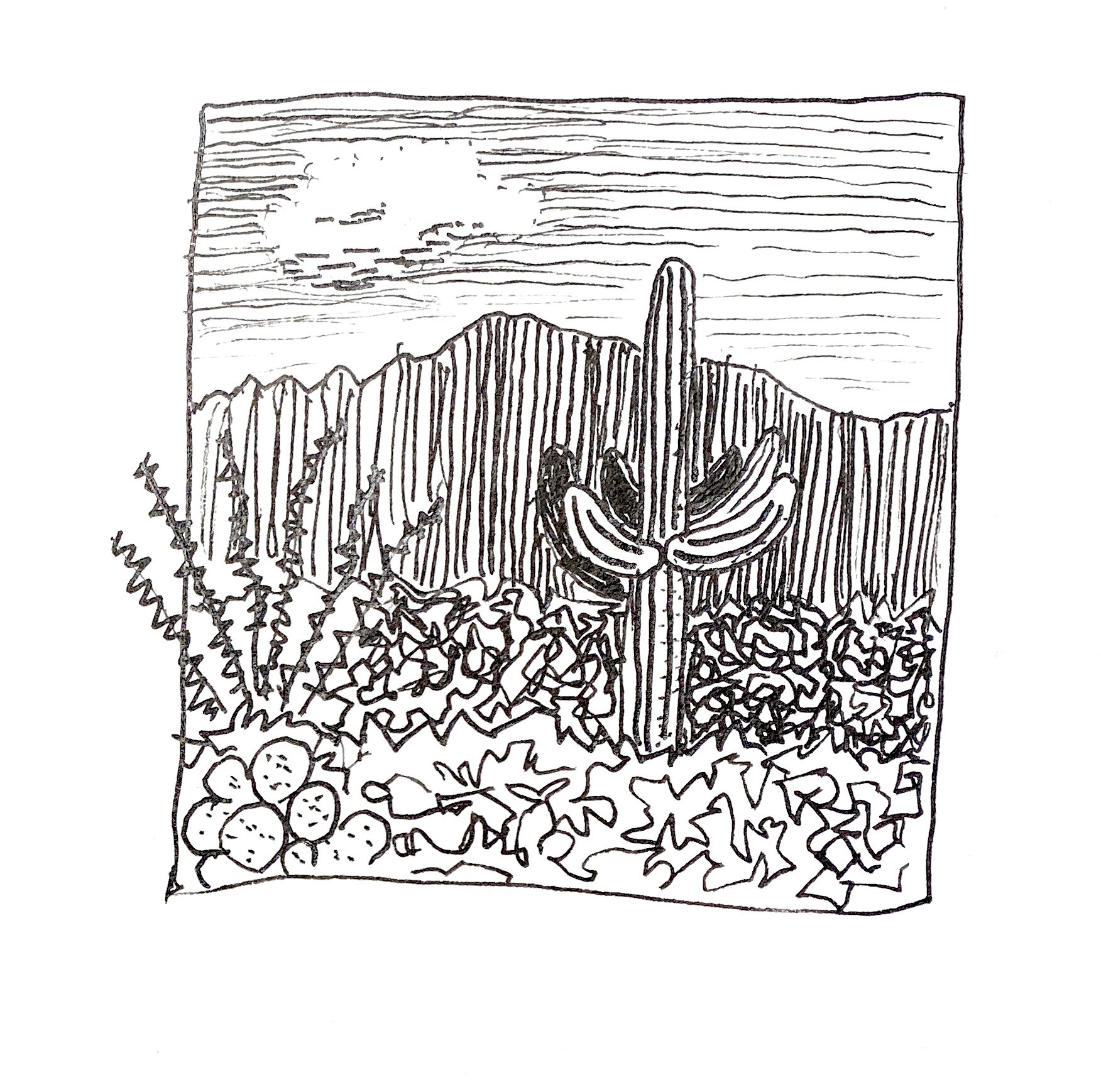
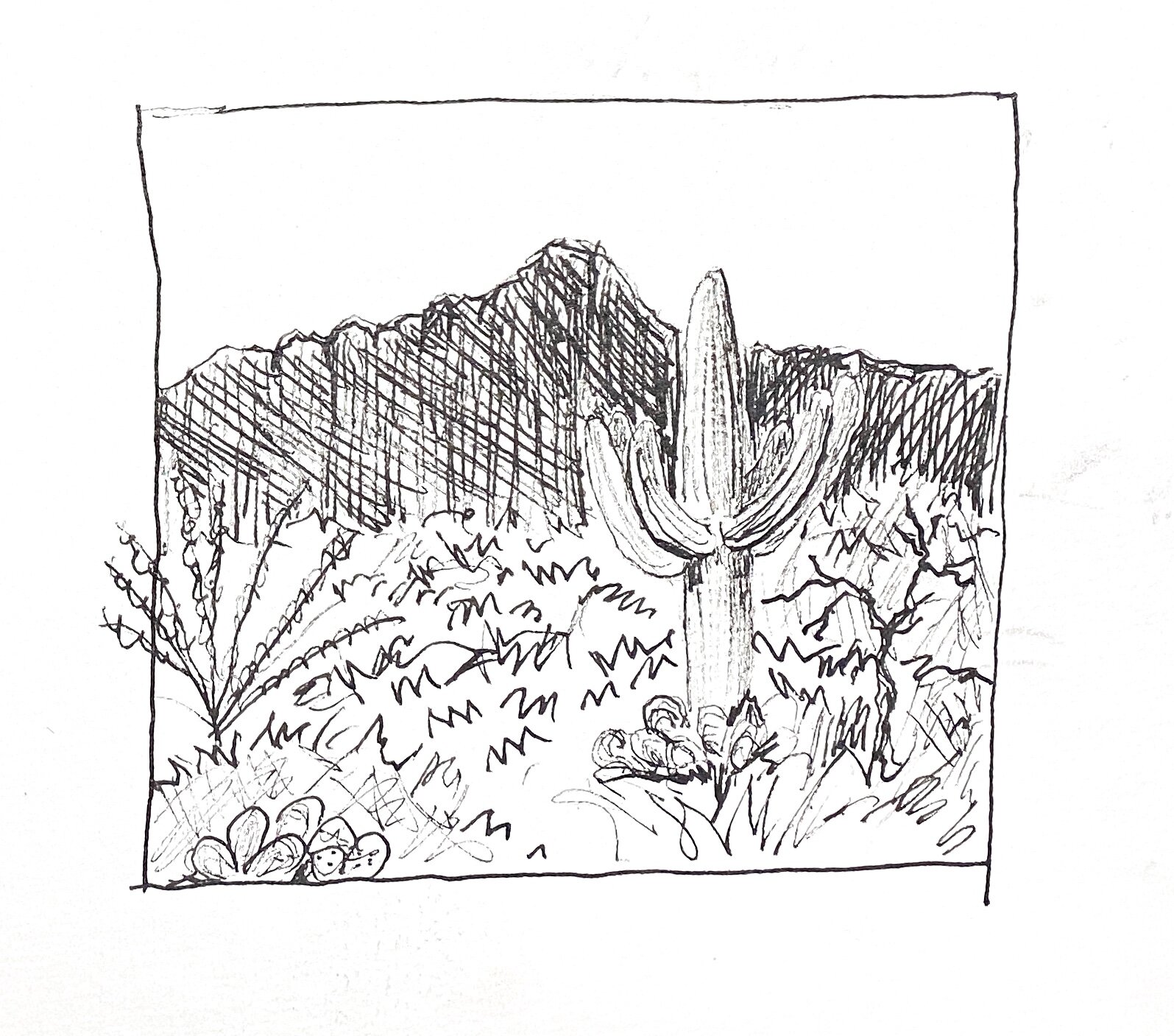
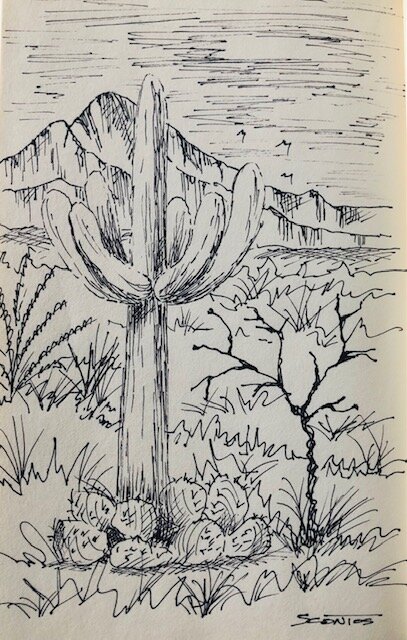

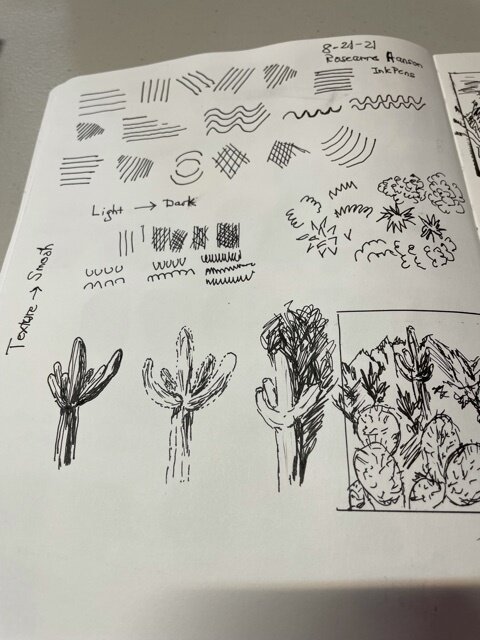
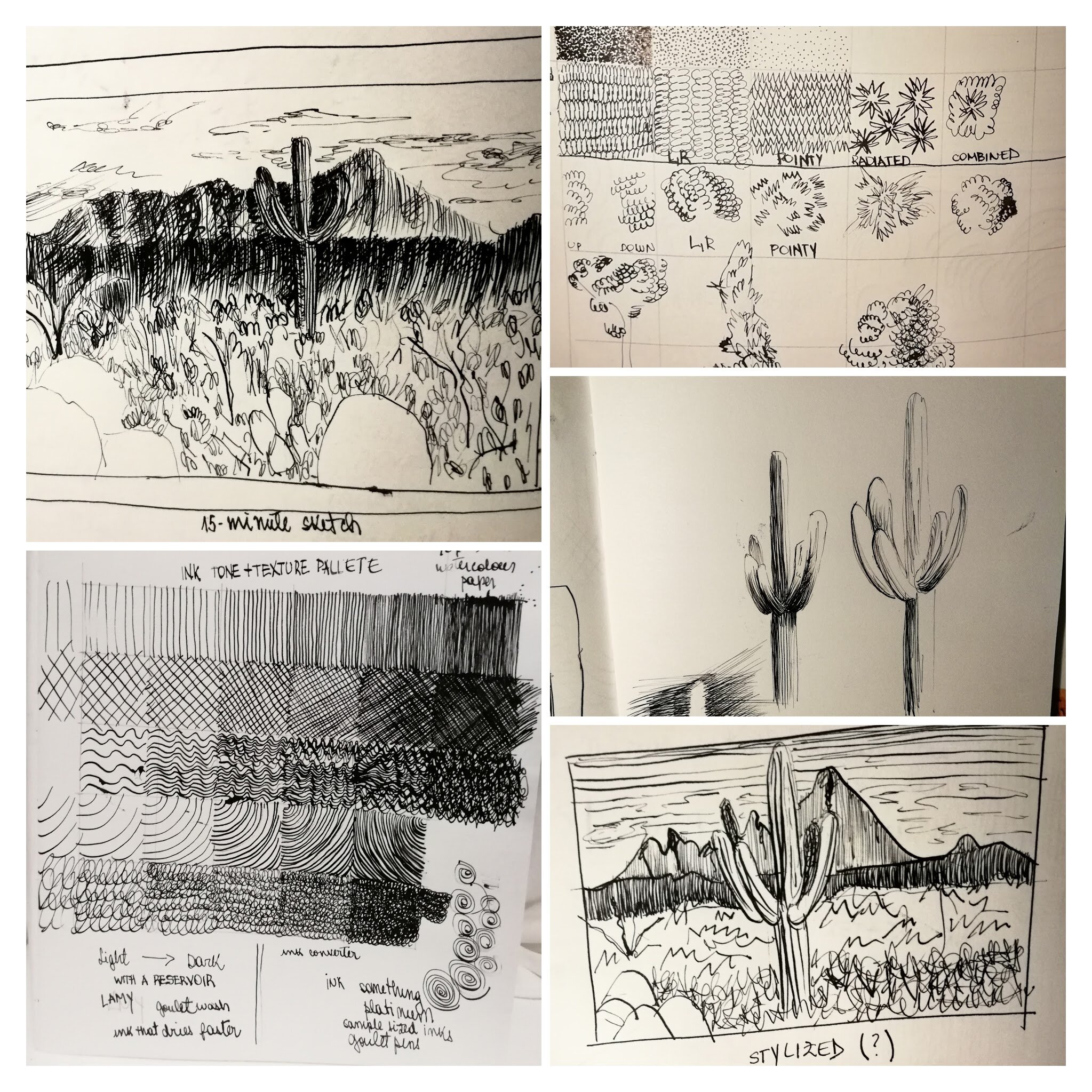
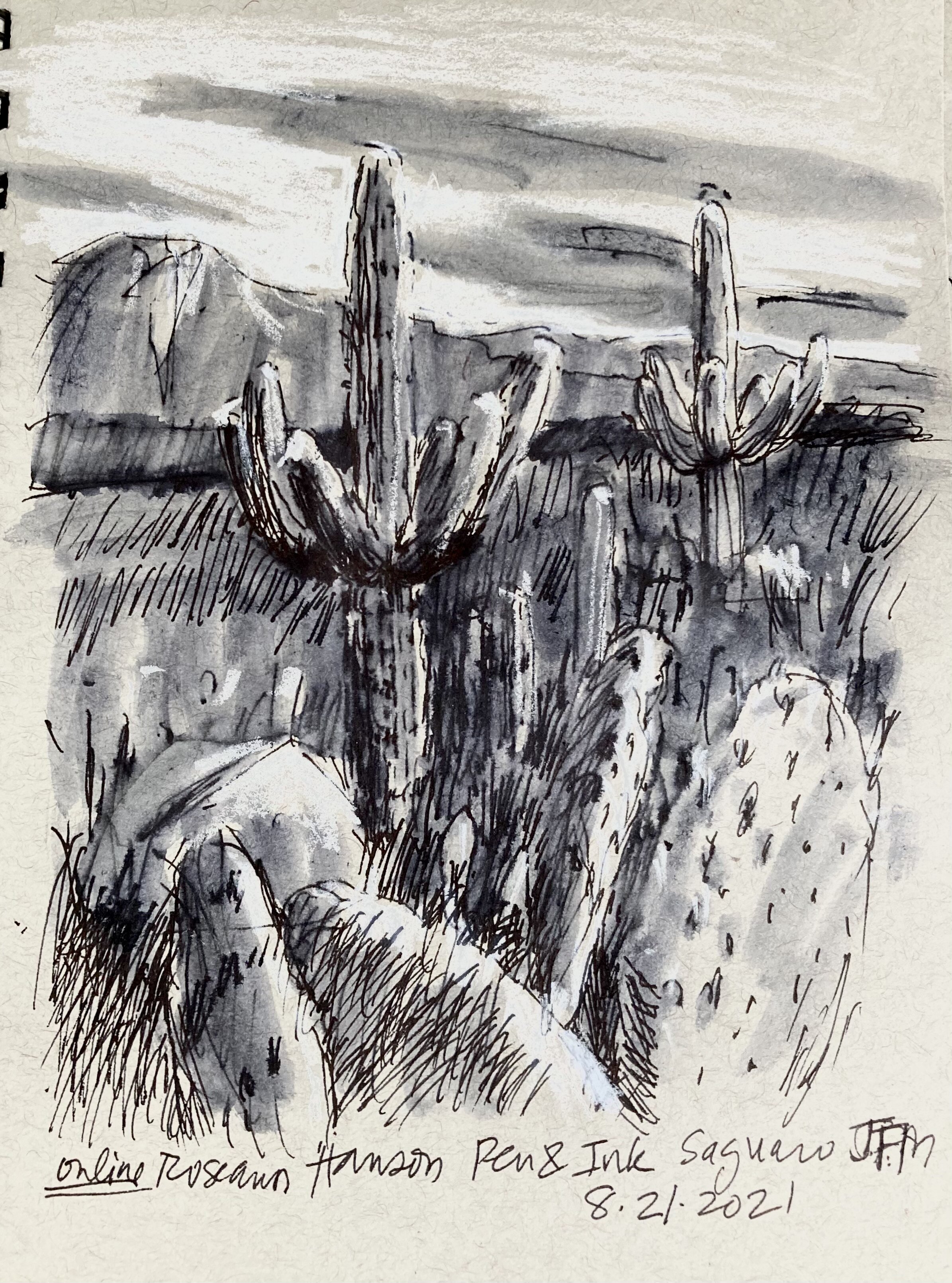
Field Arts Workshop: Weather 101 for Field Notebooks
Creating a cloud ID chart is a great way to practice cloud-painting skills as well as to learn the main cloud types.
Metadata for your field notebooks is a crucial addition, to give your entries a solid foundation in context: date, time, sunrise / sunset, moon phase, and weather. Weather is fun to learn: What are the clouds? How do you ID them? How do you tell the wind speed? What are the symbols for recording weather?
In this free Field Arts tutorial, we will dive into learning about weather data, what is climate vs. weather, where weather forms and how, and how to ID clouds. Then we’ll create a cloud-chart that you can keep in your journal for future reference.
Length: 2 hours
Resources from the Workshop
pdf with all links and download link for images and ALL THE charts (CLICK IMAGE):
Click image to initiate download. Or, use: https://www.dropbox.com/sh/rvlzr0a9hezdgjr/AACw6pH9jwhj6sQ-rvmM_GGwa?dl=0
SUGGESTED PAINTS AND SUPPLIES:
Ruler and pencil
Pen with waterproof ink
And for the color, two approaches:
1) Traditional:
- watercolor paper (9x6 or larger), at least 90 pound
- cobalt or cerulean; these are pretty and wash easily, and also lift easily. French ultramarine is wonderful but does not lift as well and does granulate a little, so it will settle into the texture on your paper, which you may or may not like.
- burnt sienna to mix with your blue to create a nice gray for the clouds
- alternatively, shadow violet
OR
2) gouache:
- toned paper (dark grey or tan)
- gouache paint in white and blue and burnt sienna
I actually found the toned with white gouache to be much easier for this chart exercise!
You can find my list of minimalist colors and tips on color mixing here: https://www.exploringoverland.com/field-arts-tutorials-list/2020/7/5/minimalist-watercolor-for-nature-journaling
COLORS I DEMONSTRATED:
Manganese Blue (Old Holland)
Cyan (Greenleaf & Blueberry)
Cobalt (Daniel Smith)
Cerulean (Daniel Smith)
French Ultramarine (Daniel Smith)
Pthalo Blue (Green Shade, Daniel Smith)
Goache Set from Caran D’Ache (white, yellow, blue, red, burnt sienna)
This is the reference image for creating your own cloud chart for your journal.
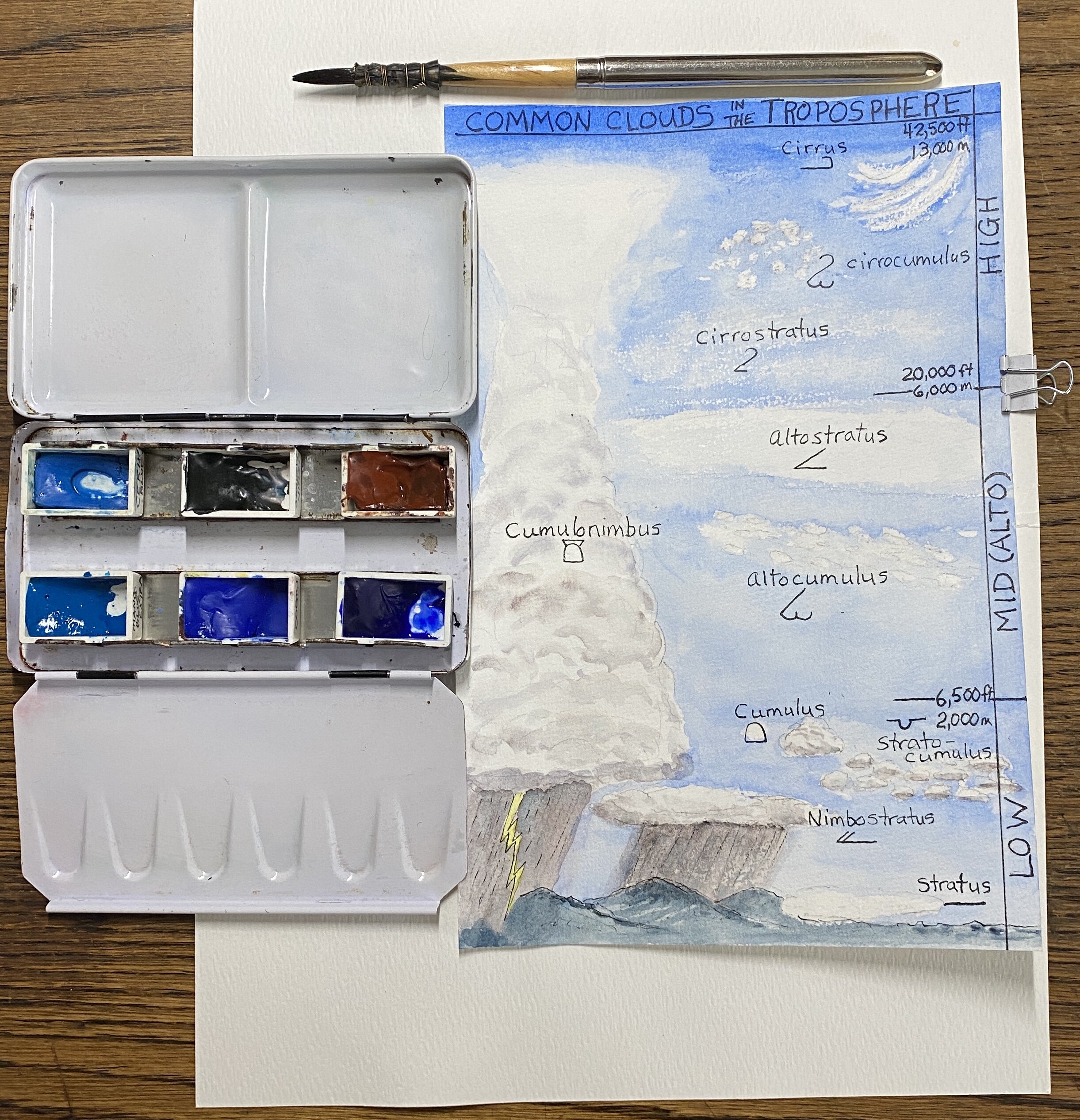

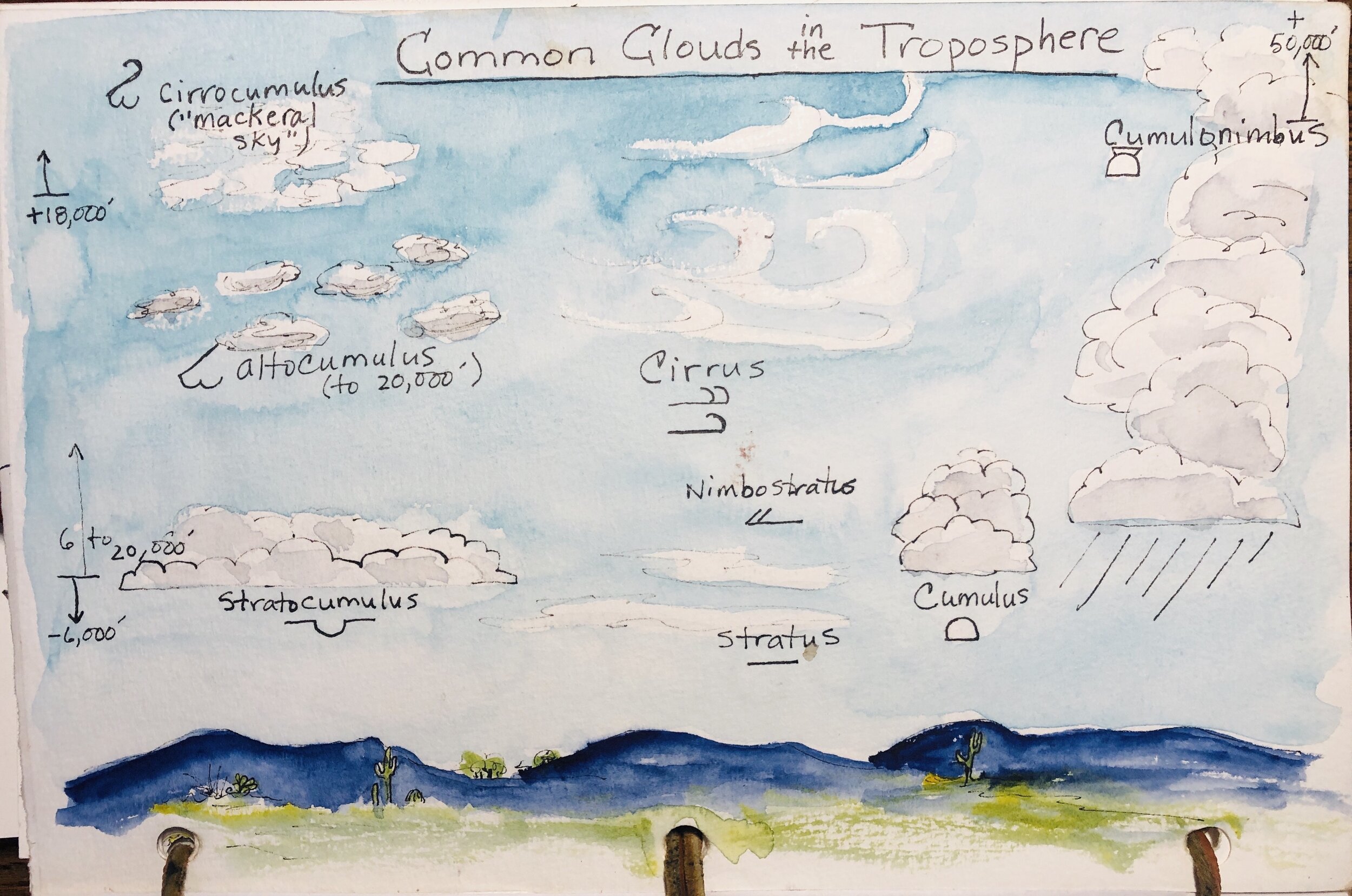
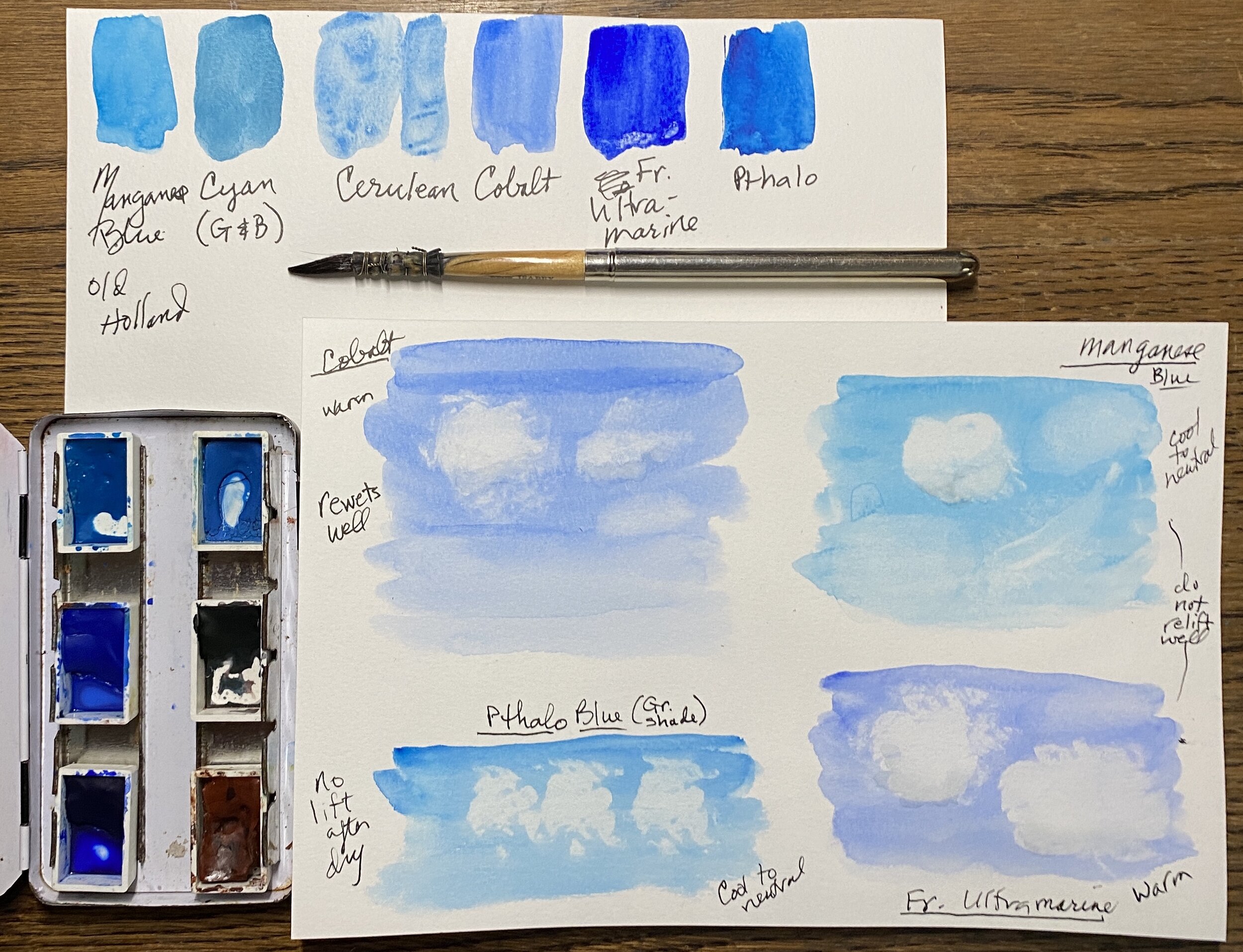
Field Arts Workshop: Animal Tracking 101 for Field Notebooks
Female lion and cub tracks, Great Rift Valley, Olkiramatian, Kenya (click to enlarge).
Join me for a free online workshop on the basics of animal tracking—and different ways to add them to your field notebooks and nature journals. I’ve spent 30 years tracking wildlife and teaching tracking for conservation groups, and my husband Jonathan Hanson and I wrote the Basic Essential Guide to Animal Tracking.
Learn how to quickly tell canine from feline tracks, domestic dogs from wild, different gait patterns, and how to “read” a track story.
I’ll also show how to use my clear Perspex Palette-Easel ) to trace a track, and a template for making your own unique track ruler, as well as a free Quick Tracking Tips card.
Length: 2 hours
Resources from the Workshop
Perspex palette with dry erase:
Downloads (Tracking Tips Bookmark and Tracking Ruler):
Here’s a free printable tracking ruler, or order the same plastic original one that I use in the workshop, from Sue Morse at KeepingTrack.org. Sue is one of my tracking mentors. Her book is amazing, and recently updated.
field guides:
“Basic Illustrated Animal Tracks” by Roseann and Jonathan Hanson https://www.amazon.com/Basic-Illustrated-Animal-Tracks/dp/1493017179
The two best deep-dive tracking training books:
Paul Resendez, “Tracking and the Art of Seeing” https://www.amazon.com/Tracking-Art-Seeing-Animal-Tracks/dp/0062735241
and Sue Morse, “Wildlife and Habitats” https://keepingtrack.org/keeping-track-store
Good in depth basic field guides:
“Scats and Tracks of the Desert Southwest” by James C. Halfpenny, illustrations by Todd Telander https://www.amazon.com/Scats-Tracks-Desert-Southwest/dp/1560447869
and
https://www.amazon.com/Mammal-Tracks-Sign-American-Species/dp/0811737748
Recommended in the chat:
Oldie but goodie: Animal Tracks by Olaus J. Murie, Peterson Field Guide Series. Love the line work and clear illustrations.
“Mammal Tracks & Sign” by Mark Elbroch
For kids: John Townsend “Life-Sized Animal Tracks”
Animal Tracks of Alaska by Sheldon and Hartson is a handy little guide to take with you, has info on many different animals including common birds and amphibians.
“Foundations for Awareness, Signcutting and Tracking” - Robert Speiden
John Rhyder’s Animal Tracks Field Guide (stipple drawings of tracks in United Kingdom) https://www.woodcraftschool.co.uk/books
Wild Tracks!: A Guide to Nature's Footprints - is another good kids book
Leslie Dendy’s “Tracks, Scats and Signs” (Take Along Guides)
ROSEANN’S DEMO PAGES FROM THE WORKSHOP:


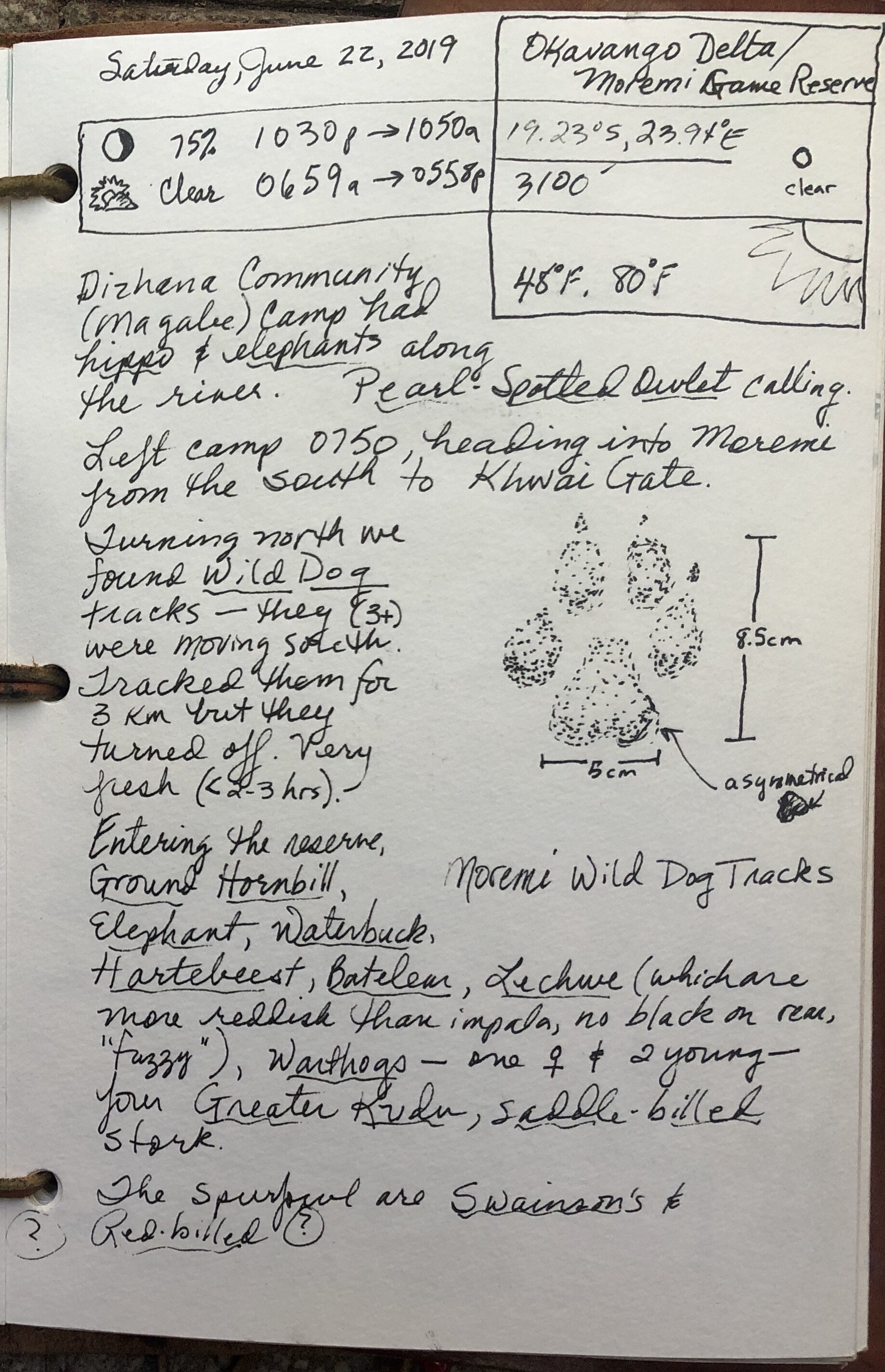

You can find my list of minimalist colors and tips on color mixing here: https://www.exploringoverland.com/field-arts-tutorials-list/2020/7/5/minimalist-watercolor-for-nature-journaling
ROSEANN’S DEMO IMAGES FROM THE WORKSHOP:
Mountain lion track (southern Arizona).
Wild Dog tracks (Botswana, Okavango Delta).
Mountain lion tracks (southern Arizona).
Field Arts Workshop: Cartography 101 for Field Notebooks
Let’s explore cartography for your nature journals and field sketchbooks. Adding maps is fun and although they can be challenging and even intimidating, they will greatly enhance not only your journals but your understanding of a place.
Traditional maps with features such as contours and shading to show relief
Linear maps that unfold or scroll from point-to-point on an exploration of a place or region
Picture-highlight maps of a place, including non-scale ideas for quick mapping
Behavior maps depicting such things as an animal foraging or defending a territory
Length: 2 hours
Resources from the Workshop
Google Interactive View of the Northern Ranges, Yellowstone:
Downloads (Cartographic Elements and Features):
JPG of cartographic elements and features (printable for your journals):
PDF of cartographic elements and features (larger format):
Video of Yellowstone Northern Ranges:
https://www.nps.gov/media/video/view.htm%3Fid%3D17806168-1DD8-B71B-0BE946127DB84B95
METADATA AND NATURE DATA for MAPPING LOCATION:
Location: Confluence of Yellowstone River and Lamar River, “Yell-Mar,” in the Northern Ranges
Latitude: 44 degrees 55’ 13” N
Longitude: 110 degrees 22’ 04” W
Elevation: 1849 meters (6066 feet)
Low:36 degrees F
High: 55 degrees F
Sunrise: 1135 am
Sunset: 0937 pm
Moon phase: 73% waning
ROSEANN’S FIELD NOTES PAGES from THE WORKSHOP:





You can find my list of minimalist colors and tips on color mixing here: https://www.exploringoverland.com/field-arts-tutorials-list/2020/7/5/minimalist-watercolor-for-nature-journaling
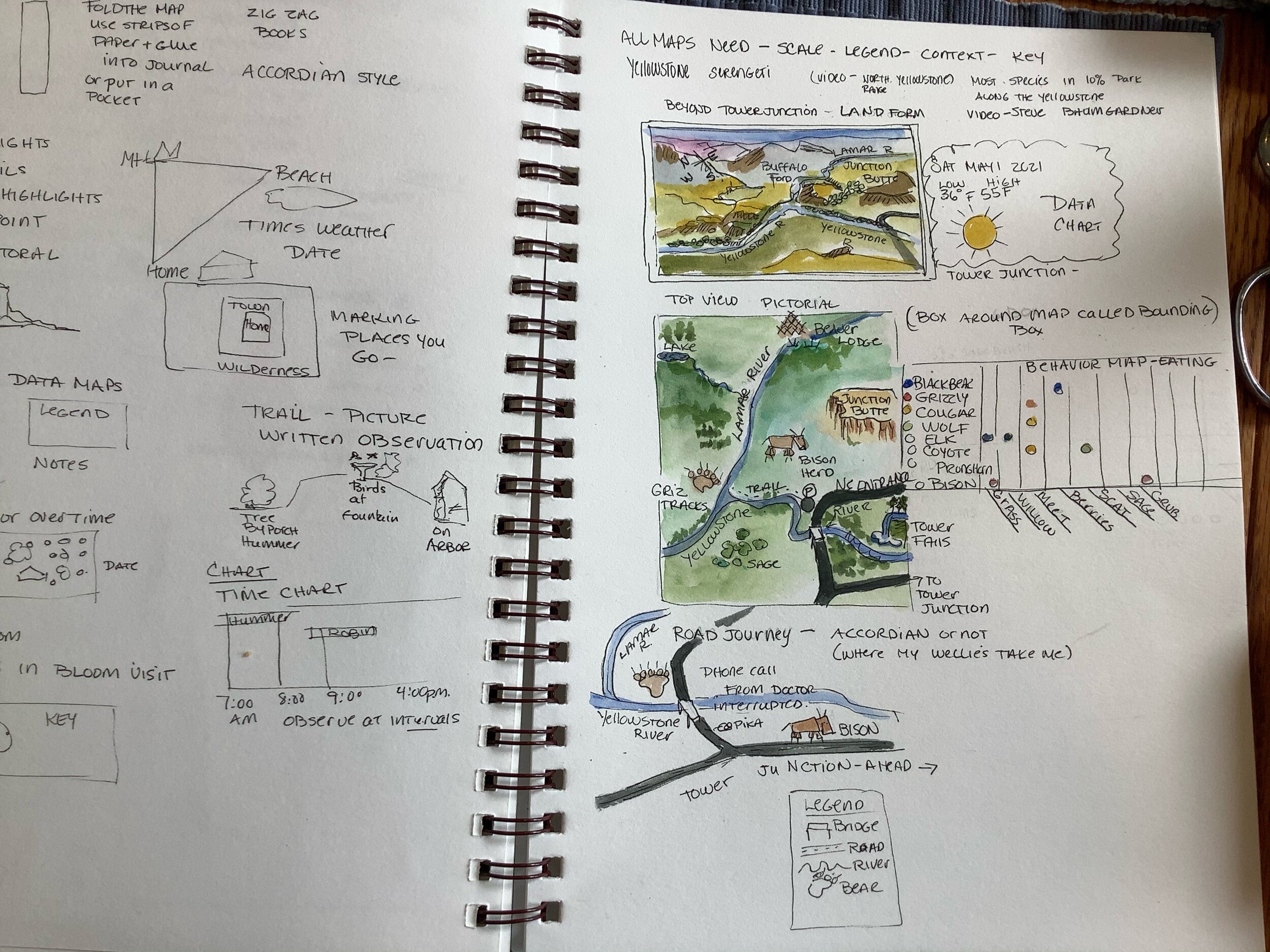
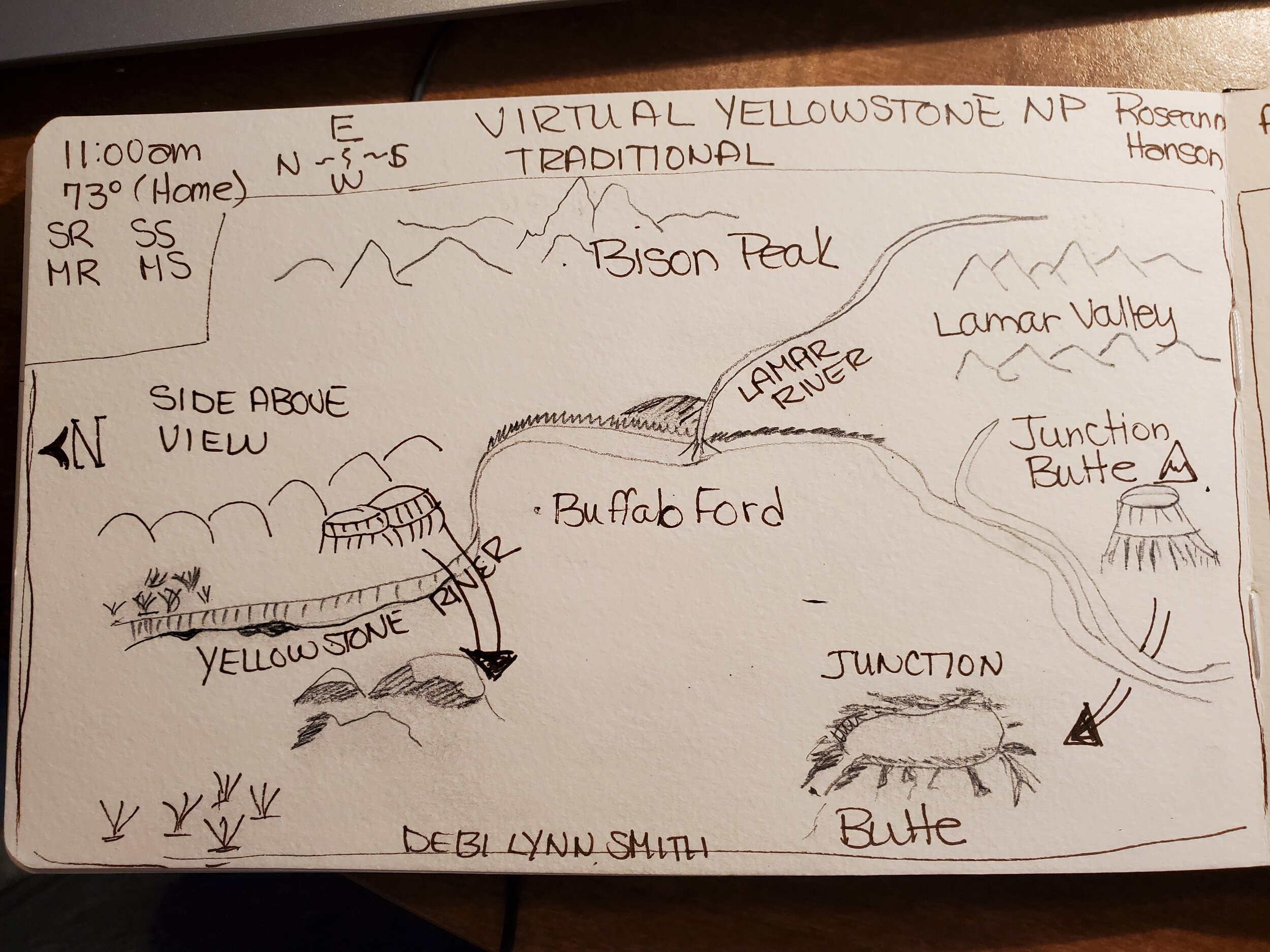
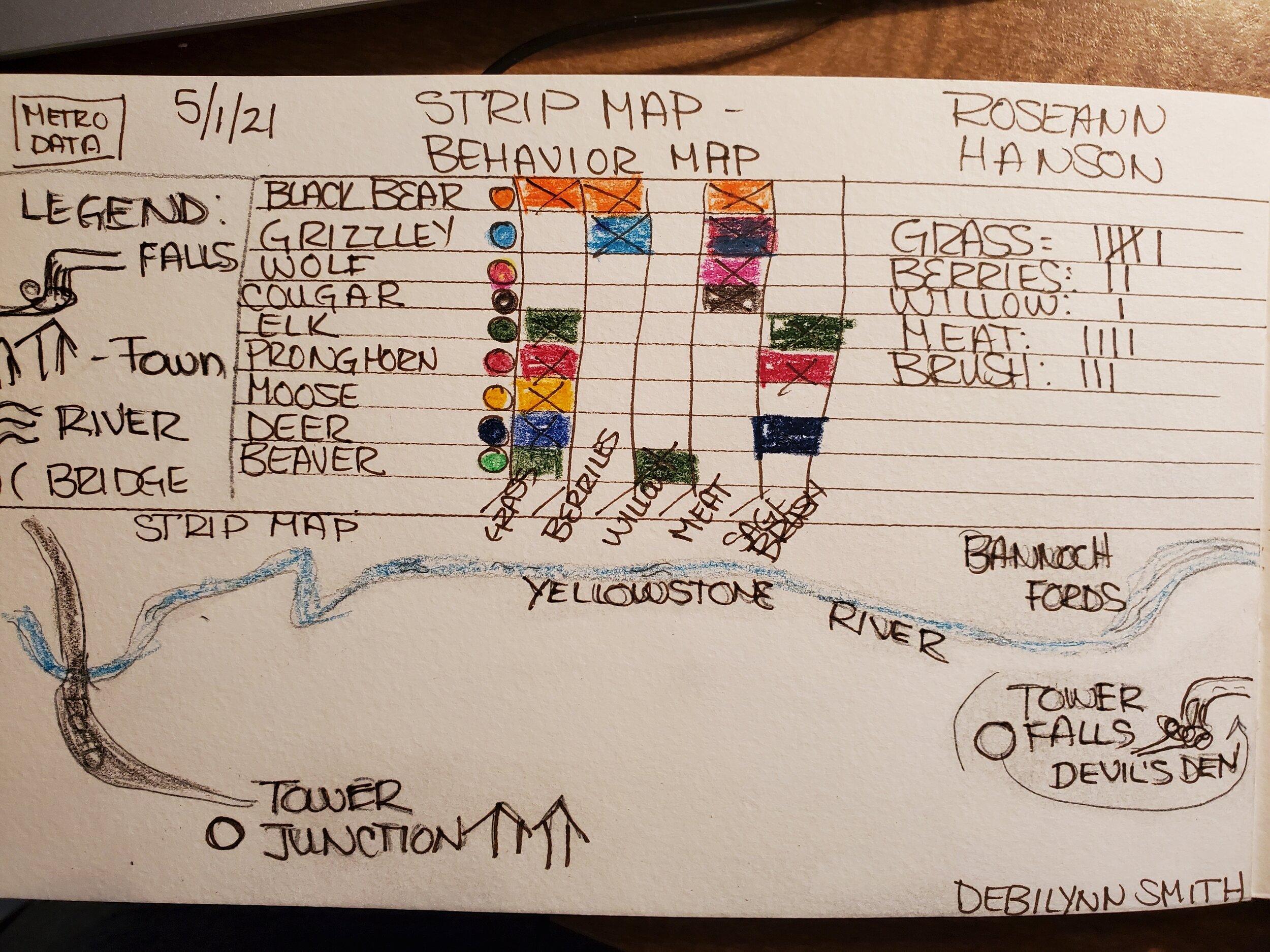
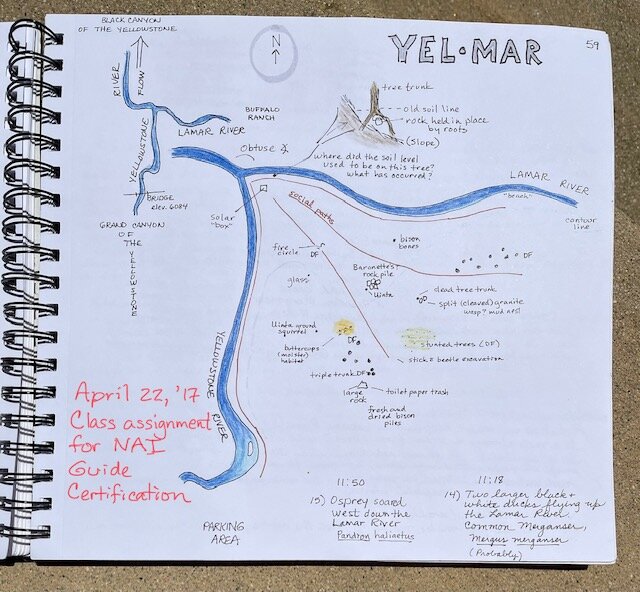
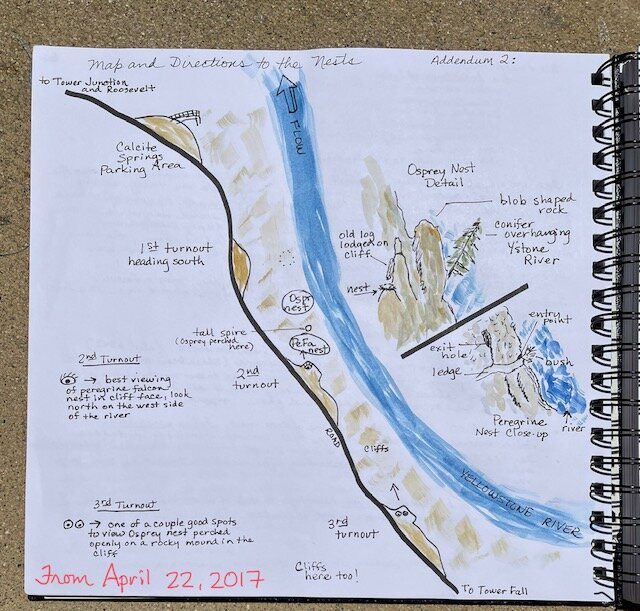
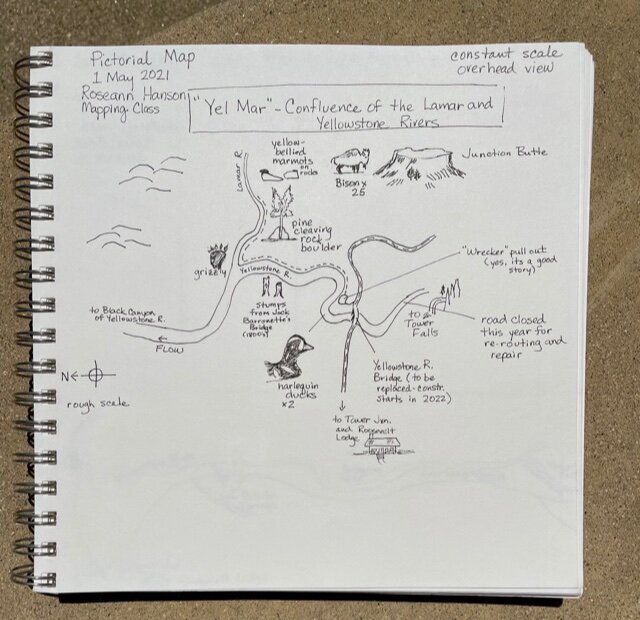
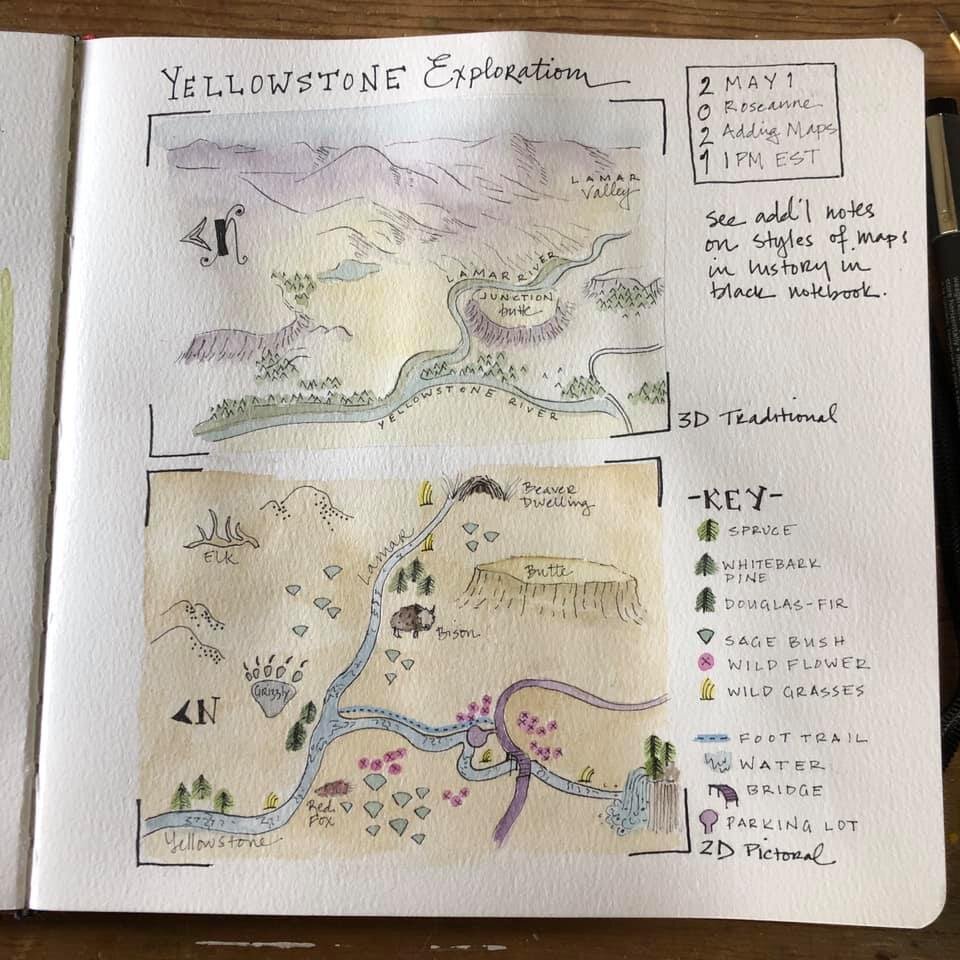
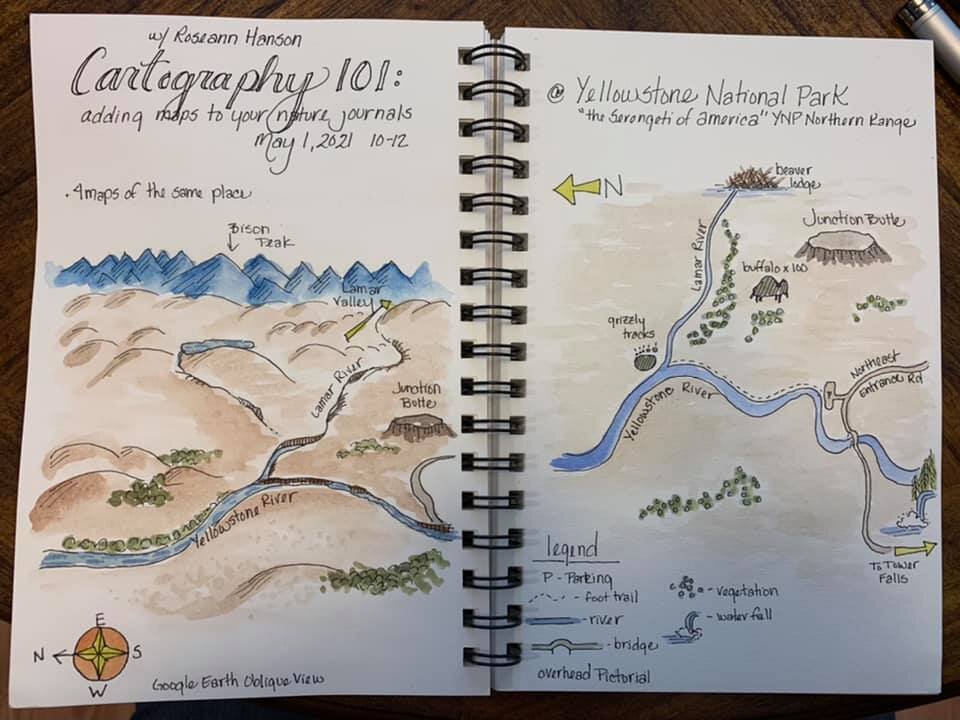
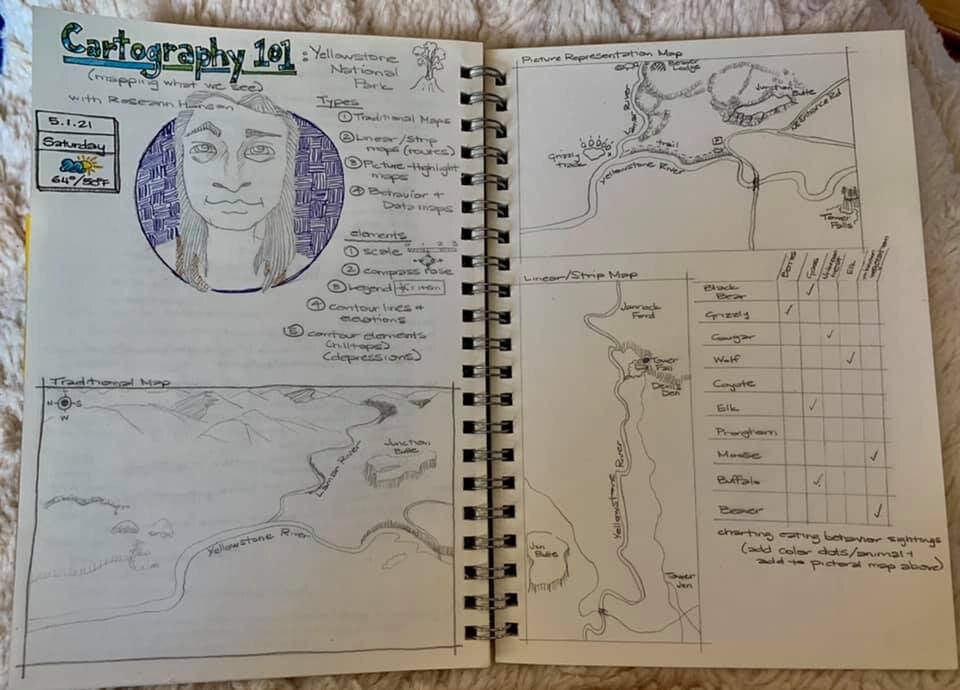
1. Traditional Map - original view
2. Pictorial Map - original view
3. Linear or Strip Map - original view
4. Behavior Map - original view
Virtual Field Trip: Let's Explore Mars!
Join me on a truly out of this world virtual field trip sketching the Martian landscape!
Let’s see how many different reds we can use to depict the Red Planet as we explore the astrobiology of Mars aboard the Mars Curiosity and Perseverance Rovers. We’ll also dive into the natural history of the dunes and weather, and learn about space travel . . . all from the comfort of your Earth studio!
Sketch along or just observe, I’ll narrate as I go to demonstrate why I choose to focus on what subjects and how to quickly capture them in your field notebooks and nature journals.
Length: 1.5 hours (although it might go a little over)
Resources from the Workshop
Google Mars Interactive View:
https://www.google.com/maps/space/mars/@0,-110.9387418,22963938m/data=!3m1!1e3
NASA Mars Science:
Astrobiology:
METADATA AND NATURE DATA for MARS:
Location: Gale Crater
Latitude: -4.521663 degrees S
Longitude: 137.38952 degrees W
Elevation: -4,501 meters (-2.8 miles)
Low: -105 degrees F
High: 9 degrees F
Sunrise: 0530 am
Sunset: 0630 pm
Two moons:
Phobos (largest moon) has a transit of 66 hours
Deimos has a transit of 10 hours
ROSEANN’S FIELD NOTES PAGES from THE WORKSHOP:
You can find my list of minimalist colors and tips on color mixing here: https://www.exploringoverland.com/field-arts-tutorials-list/2020/7/5/minimalist-watercolor-for-nature-journaling
participants’ field notes pages:
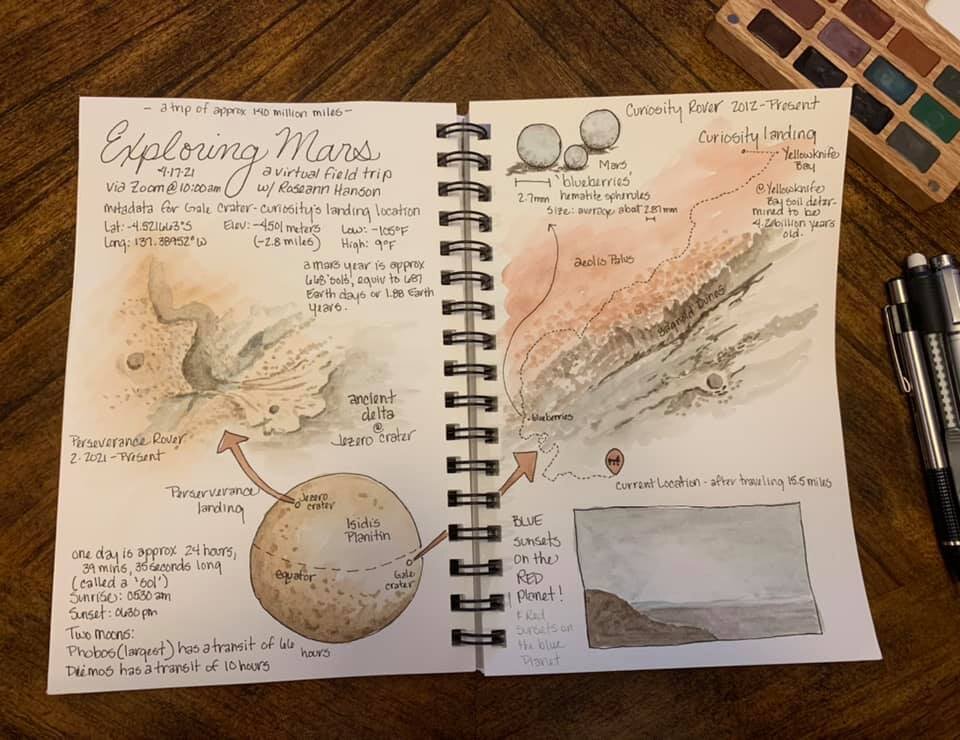
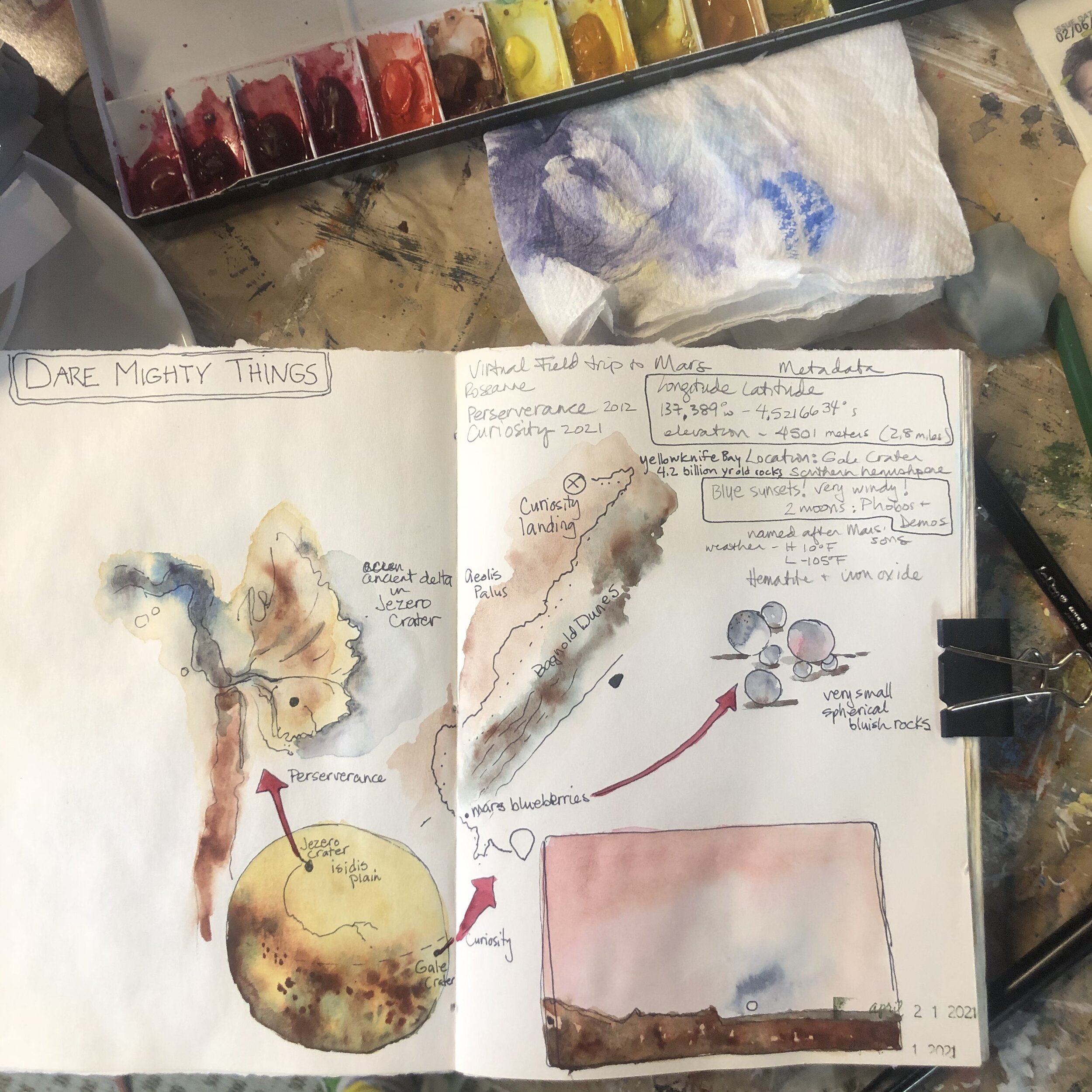
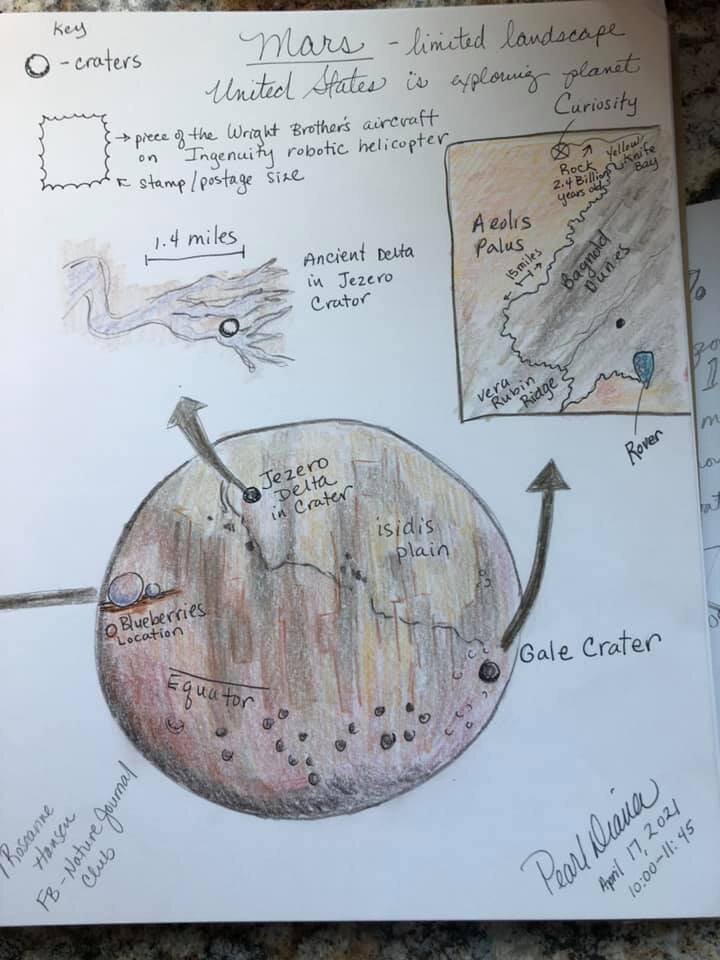
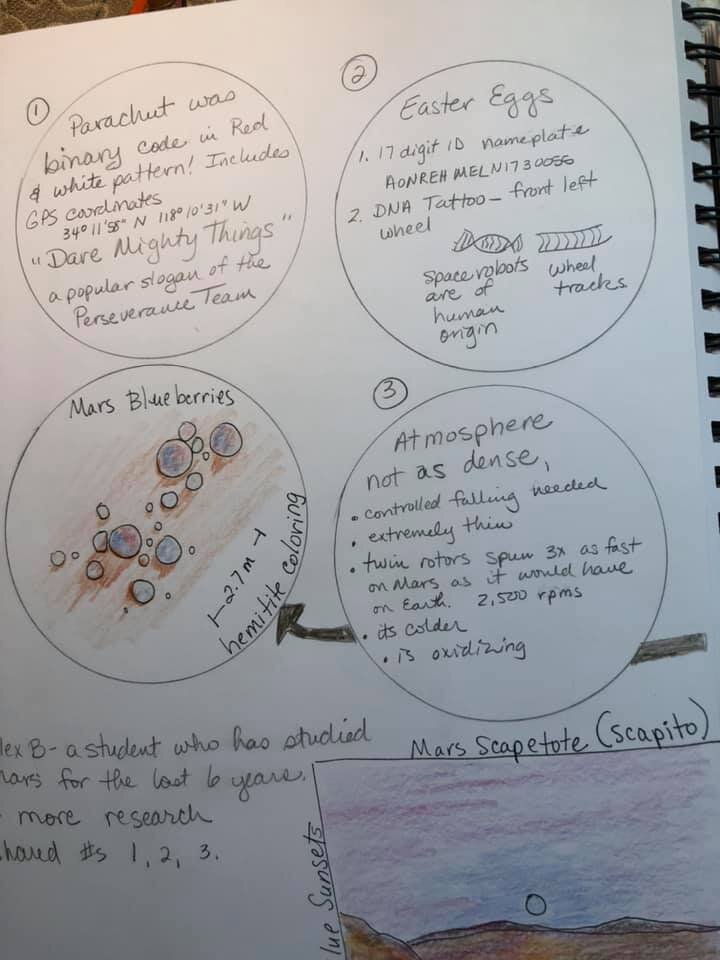

Curiosity landing site in Gale Crater; path of the rover as of today.
Jezero Crater; Perseverance landing site.
Blue sunset.
Mars “blueberries,” average 2.7 mm in diameter.
DARE MIGHTY THINGS
The Perseverance parachute design contains binary code with two messages: “Dare Mighty Things” —the motto of the mission — and the JPL address in Pasadena.
Far better is it to dare mighty things,
to win glorious triumphs,
even though checkered by failure . . .
than to rank with those poor spirits
who neither enjoy nor suffer much,
because they live in a gray twilight that
knows not history nor defeat.
– Theodore Roosevelt
Field Arts Workshop: Optics 101, Choosing and using binoculars and scopes
Field optics are vital tools for naturalists and explorers. But the range of options can be confusing:
Porro or roof prism?
Best magnification / lens diameter combo?
Close focus?
Field of view?
Waterproof?
What is meant by BaK4 glass? Flat field? Multi-coating?
Jonathan and Roseann have been using field optics professionally for over 35 years—and were early fans of Swarovski Optik: Jonathan used an early pair of 10x50 Habichts in his sea kayaking business in the 1990s. They will walk you through all the elements of what makes a quality pair of binoculars or spotting scope, and what is worth paying for—or not. Using Swarovski, Leica, and a few other brands as examples, they will also make recommendations based on workshop attendees’ field uses (we’ll send you a questionnaire before the workshop).
This workshop is suitable for anyone who uses or is considering buying field optics: naturalists, travelers, explorers, birdwatchers, and hunters.
An interactive Q & A session will be included, with Ben Lizdas of Swarovski Optik.
When: Saturday, March 13, 2021
Length: 1.5 hours
SPECIAL DEAL: Note that for a limited time (March 13 – 28), 7P Overland will be offering select Swarovski optics in their shop with a special Exploring Overland deal: free shipping and a free cleaning kit. https://7p.io/product-category/expedition-optics/
Introduction to Nature Journaling for a Wild Life - Tucson Festival of Books
Join me for a 38 minute talk where I introduce my book, Nature Journaling for a Wild Life, its features, and show pages from my journal, and then do a demo in my own journal of how I set up and add sketches and watercolor to my pages.
Nature Journaler Best Practices – Check-in for beginners (or anyone)
The hardest part of nature journaling isn’t the sketching and painting—it’s maintaining your practice.
If you are new to nature journaling, or struggling with an ongoing practice, join us for a check-in session to share our experiences and frustrations making nature journaling a regular part of our lives.
The aim of this 90-minute session will be to talk about success or struggles, and our community will help find solutions and suggestions.
We had a lot of great sharing during this workshop with breakout sessions.
Zoom does not support recording individual breakouts, but we were able to record one, and our leaders give synopses of the other two.
Some of the main takeaways and suggestions we have:
Give yourself permission to shape your practice to what works for you.
Be kind to yourself and to your output.
The most important thing to establishing a lasting practice is to make it a habit, and to do that you really do need to make frequent journal entries (at least when you are starting out; those of us who have been doing this for decades, it’s now a habit, so going a week or two without journaling is not going to end our practice).
If you are overwhelmed with journaling daily or even 3-4 times a week, make it a very simplified way of journaling: do a spread in your journal that represents a week, labeling it with the dates. Then, each day add one thing . . . a bird you saw (draw it if you want) or just describe in good notes . . . some phenomenon like leaves budding . . . the weather . . . any observation. You can do this in boxes (seven) or just anywhere on the page spread. By the end of the week you have a nice double-page spread, and your daily practice is supported, well on its way to habit!
Virtual Field Trip: Winter Wonderlands
Join me on a virtual field trip sketching winter wonderlands around the world! Experiment with different ways to represent snow and ice . . . from the comfort of your warm studio!
We’ll learn about wavelengths and why snow is white and glaciers are blue; explore using blue for shadows in show; practice winter “colorways;” how to represent animal tracks; and sketch some icicles.
Sketch along or just observe, I’ll narrate as I go to demonstrate why I choose to focus on what subjects and how to quickly capture them in your field notebooks and nature journals.
If you’re shy, don’t worry—we don’t require anyone to share their work and you can remain completely anonymous and worry-free!
Length: 2 hours
Resources from the Workshop
WHAT COLORS?
French Ultramarine Blue - granulating, makes lovely grays by mixing with Burnt Sienna. Also makes beautiful snow-shadow and sky colors.
In my mini triad palette Daniel Smith (CMY = cyan, magenta, yellow) plus two extras —
Manganese Blue Hue
Quinacridone Rose
Aureolin Yellow (Cobalt Yellow PY40)
Burnt Sienna
Indanthrone Blue
Other useful colors:
Readymade grays - Payne’s Gray or Jane’s Gray (which is French Ultramarine and Burnt Sienna already mixed).
Fun - Shadow Violet and Moonglow, are more purpley grays.
PRACTICING WINTER COLORWAYS WEBLINKS
Study in Blue, by Scott Kranz Photography:
https://www.scott-kranz.com/landscape-portfolio
Lake Solitude, Grand Tetons, Wyoming:
Kenai Fjords, Alaska:
CANELO HILLS VIRTUAL FIELD TRIP IN 360-DEGREE VIEW:
https://360exploring.s3-us-west-1.amazonaws.com/WinterWonderland/output/index.html
METADATA AND NATURE DATA for CANELO HILLS, SOUTHEASTERN ARIZONA, USA:
31.557 degrees N
110.55 degrees W
5,182 feet
Sunrise 7:12AM / Sunset 6:02PM
Moonrise 2:42AM / Moonset 1:12PM
High 65 / Low 37
Clouds: Altocumulus “mackerel” sky
Original pages by Roseann, completed onsite during the real field trip in January.
Virtual Field Trip Pages by Roseann
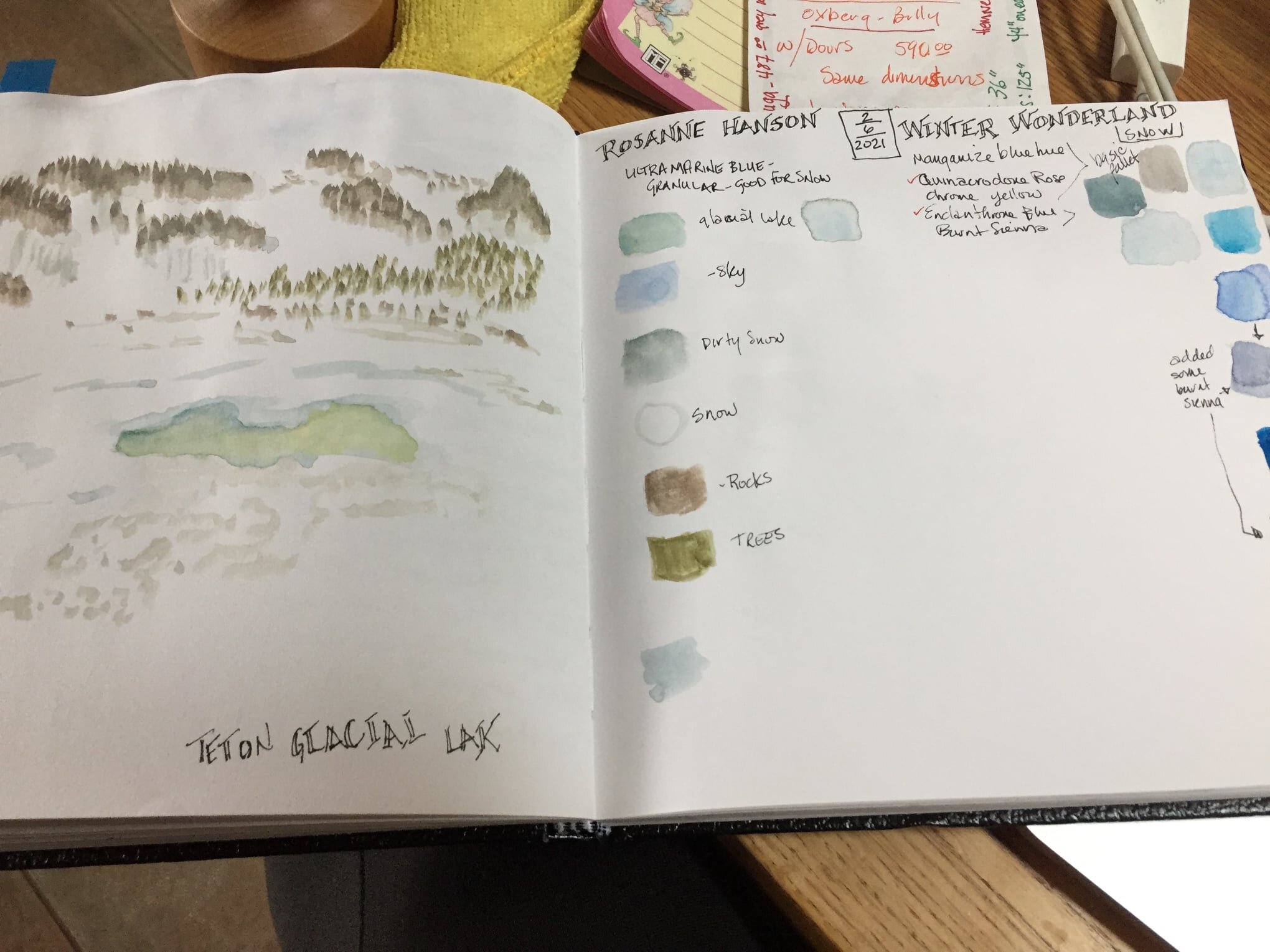
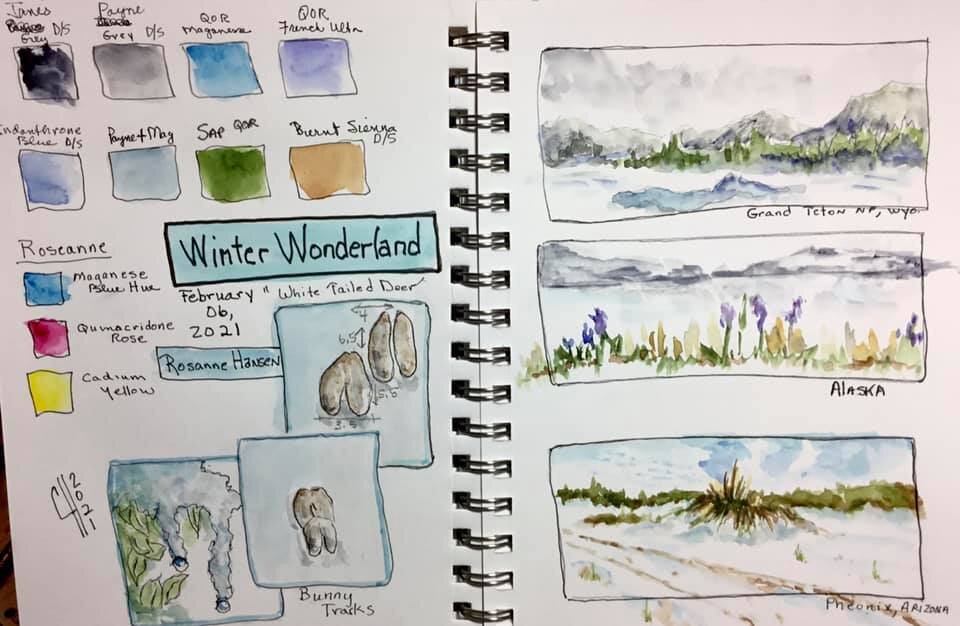
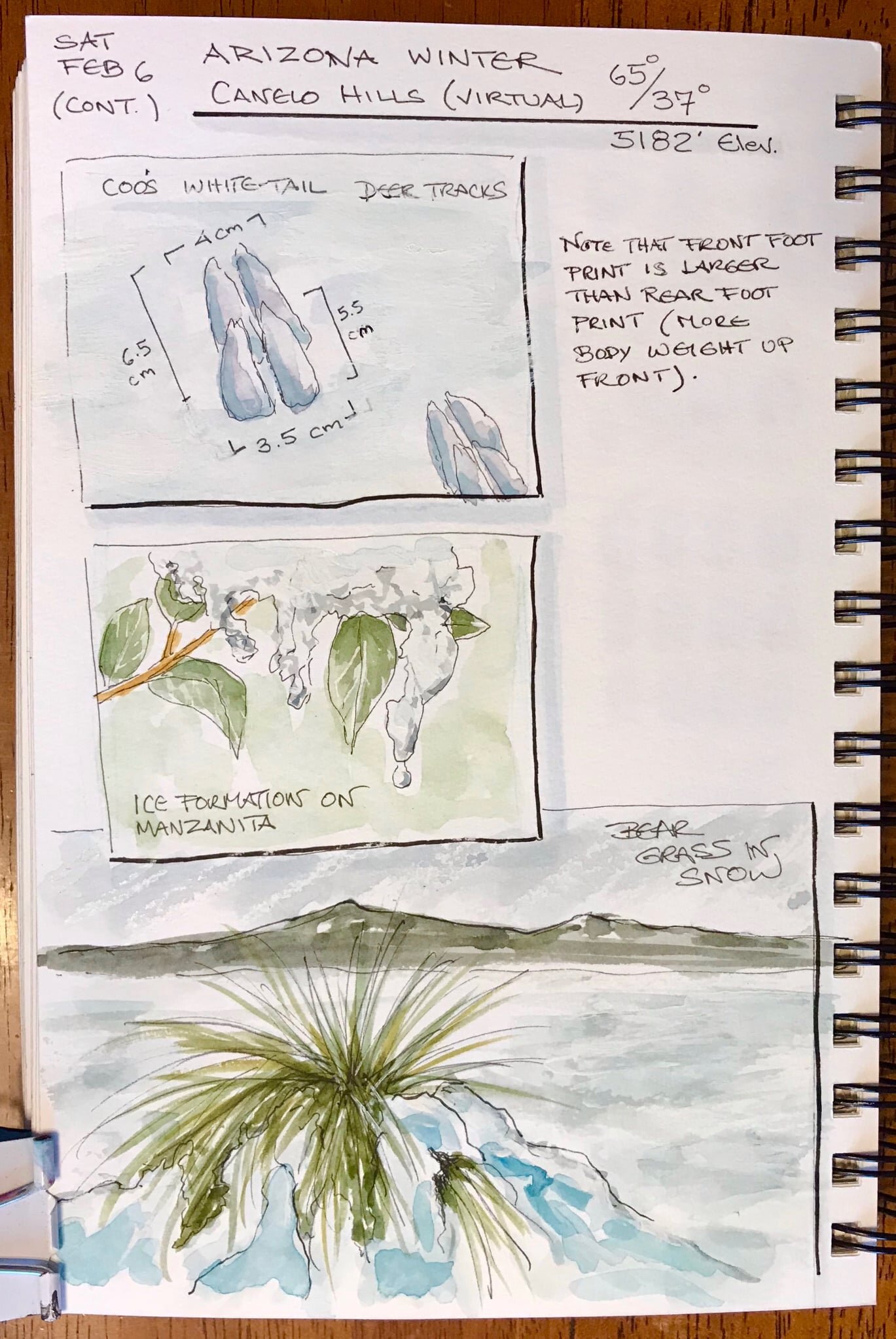
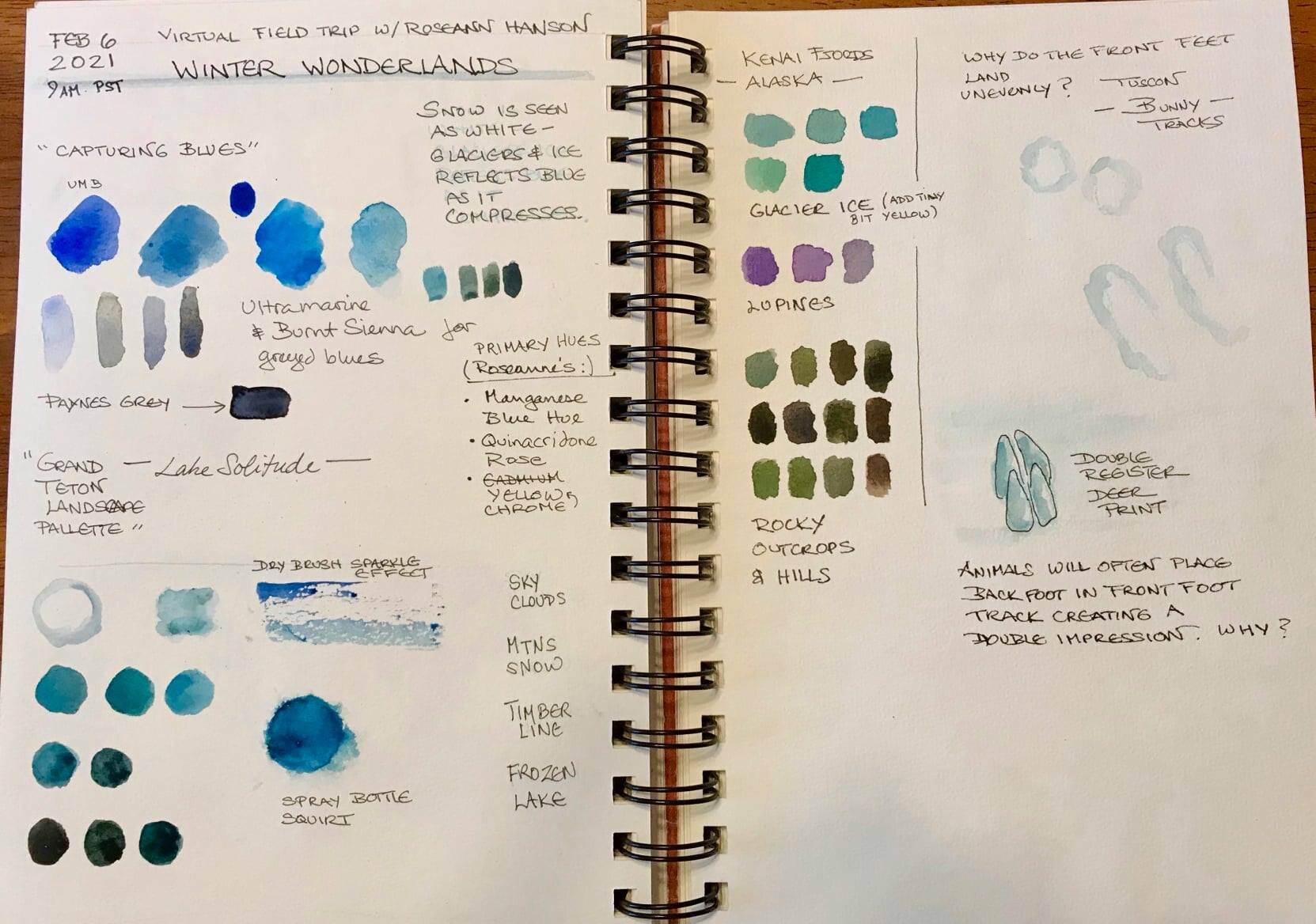


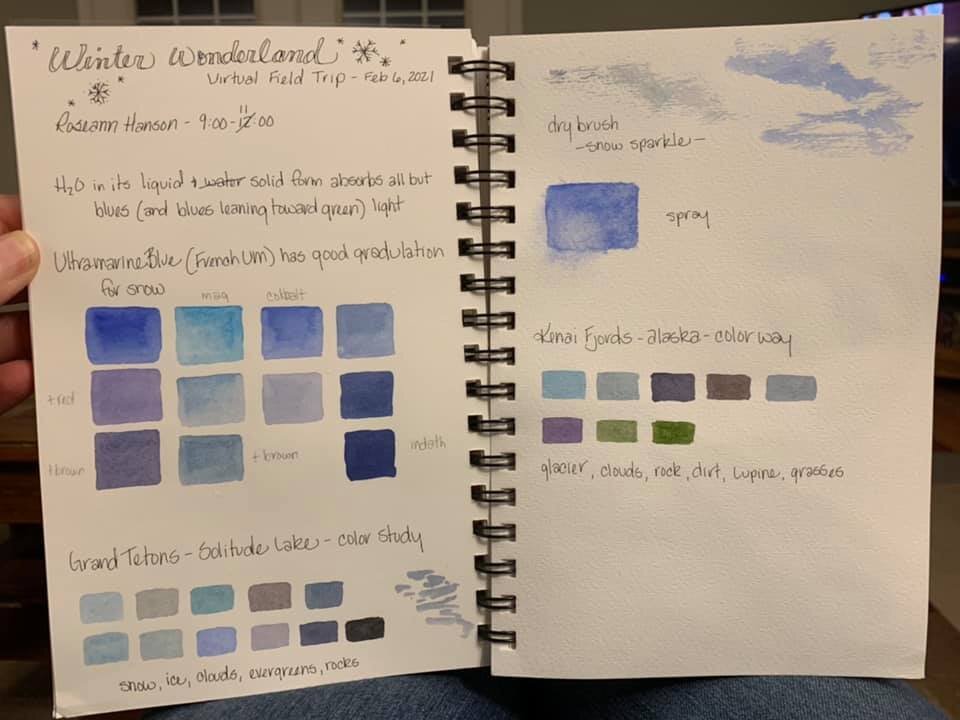
Support free tutorials! Click to contribute to the Tip Jar!
Using Grids: 3D cube landscapes and more
Join me for a free online workshop on how to draw “3-D” landscape cubes — in which you envision taking a giant cutter and pulling a cube out of a landscape, showing the sliced edges and details such as soil and creeks and roots (see here and here for examples). John Muir Laws details them in his wonderful book The Laws Guide to Nature Drawing and Journaling.
These are not easy to do— I struggled with these complex drawings “live” in the field. Where to place the cube, how to envision placing the elements correctly. I always drew mine from photos, then actually printed them and sketched the cube over the photo, or used Photoshop to put a cube over the digital photo.
But with a fun new tool ( the new clear Perspex Palette-Easel ) I will show you how to easily capture a very fun view of a landscape. Make your own (I’ll include instructions), or order one from my shop ($13 with a dry-erase marker or $12 without).
Length: 2 hours
Resources from the Workshop
IMAGE FOR PRACTICE DRAWING GRID LANDSCAPITO
IMAGE FOR PRACTICE-DRAWING CUBE LANDSCAPE
METADATA AND NATURE DATA for ROMERO POOLS, SANTA CATALINA MOUNTAINS, TUCSON, ARIZONA, USA:
32.414359 N, -110.872213 W
3713 feet elevation
Sunrise 0722 am
Sunset 0529 pm
Moonrise 0136 pm
Moonset 0258 am
Moonphase 75% illumination / waxing
High / Low temperatures - High 63/ Low 45 (degrees F)


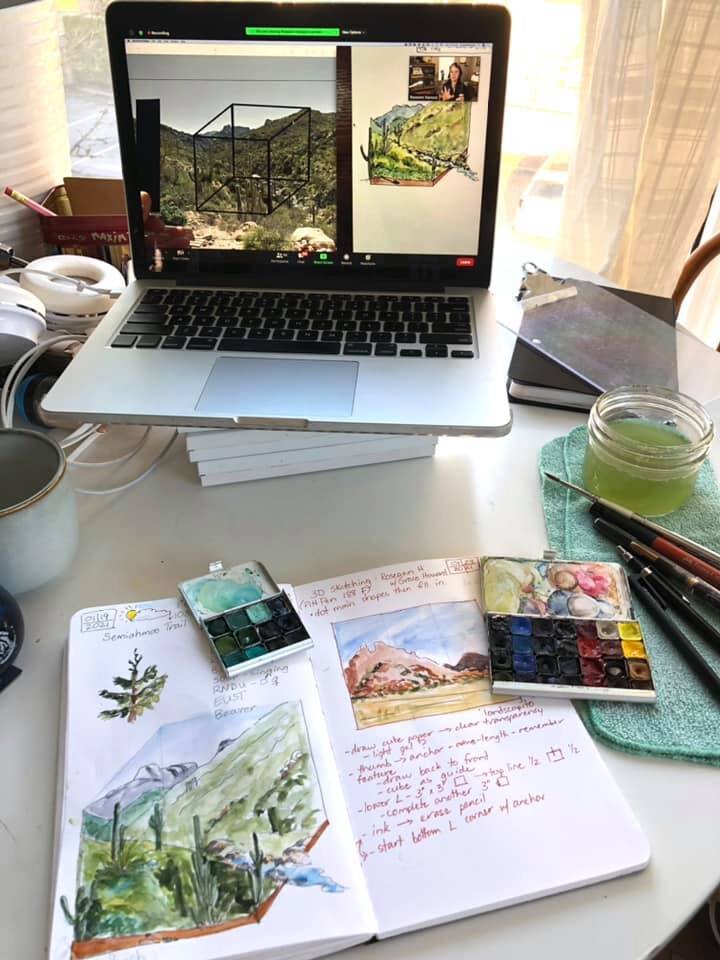
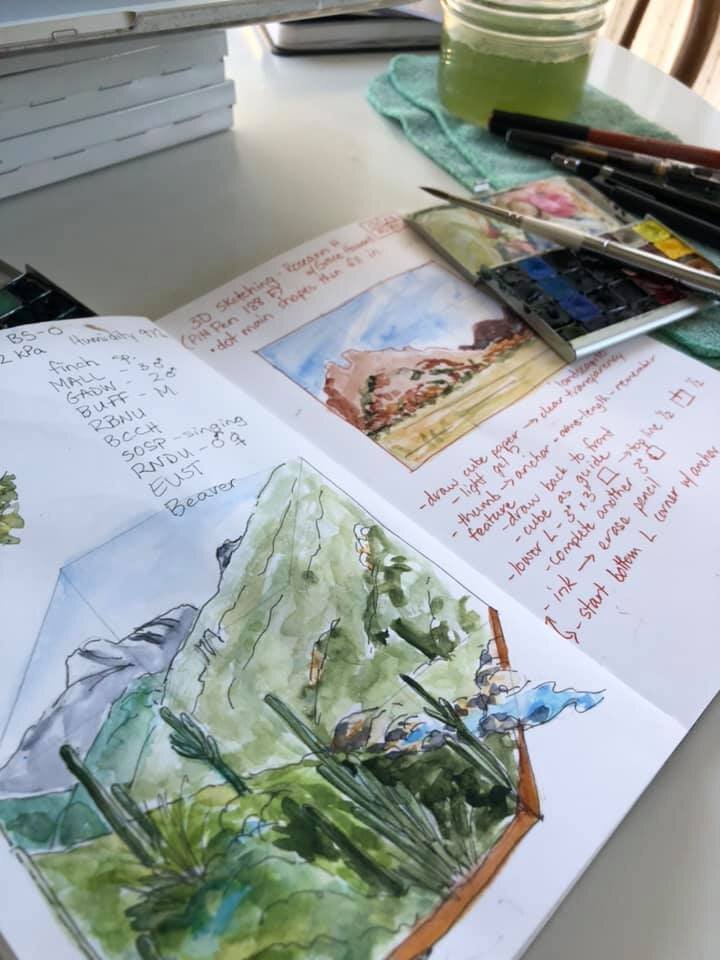
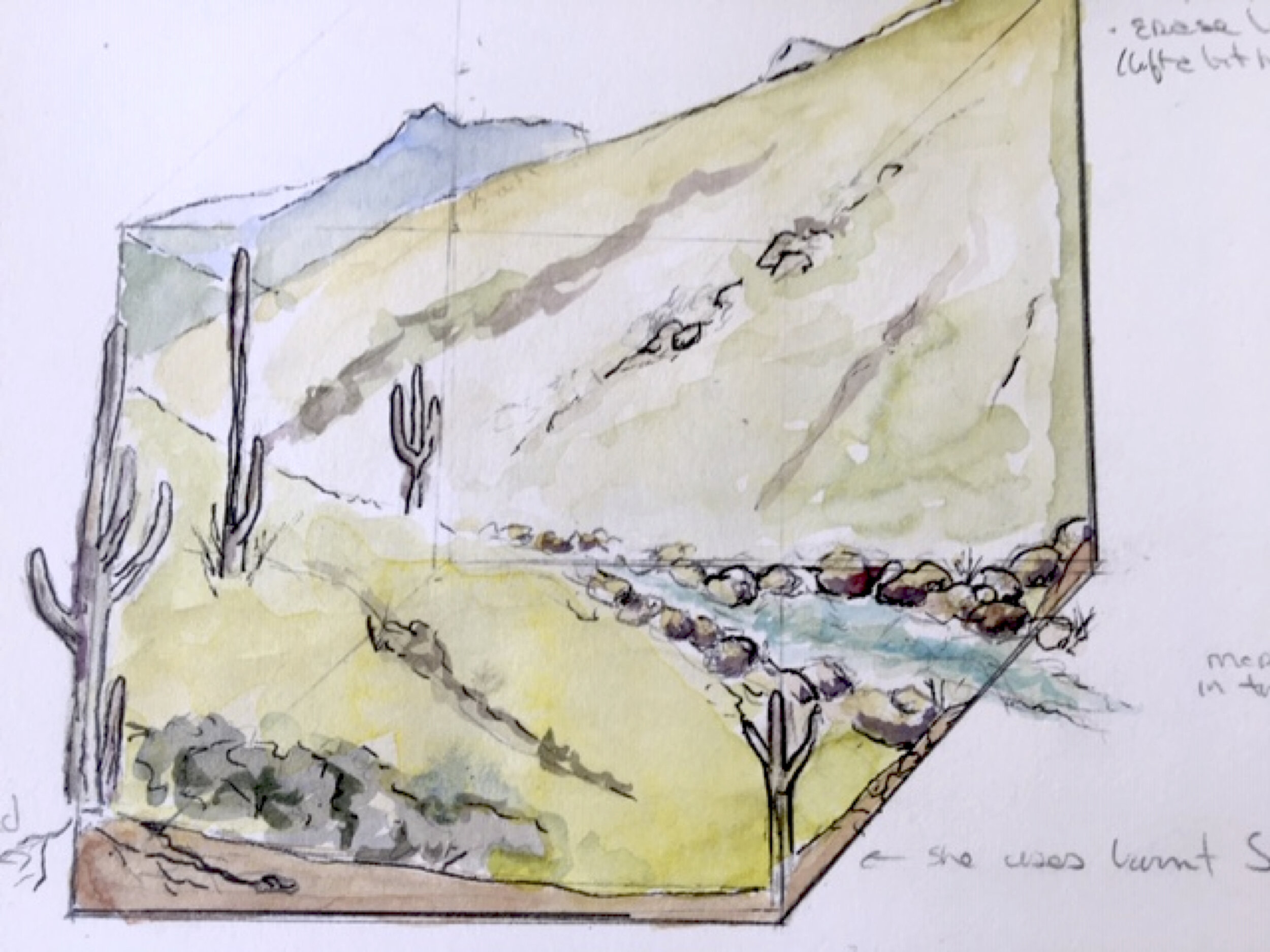
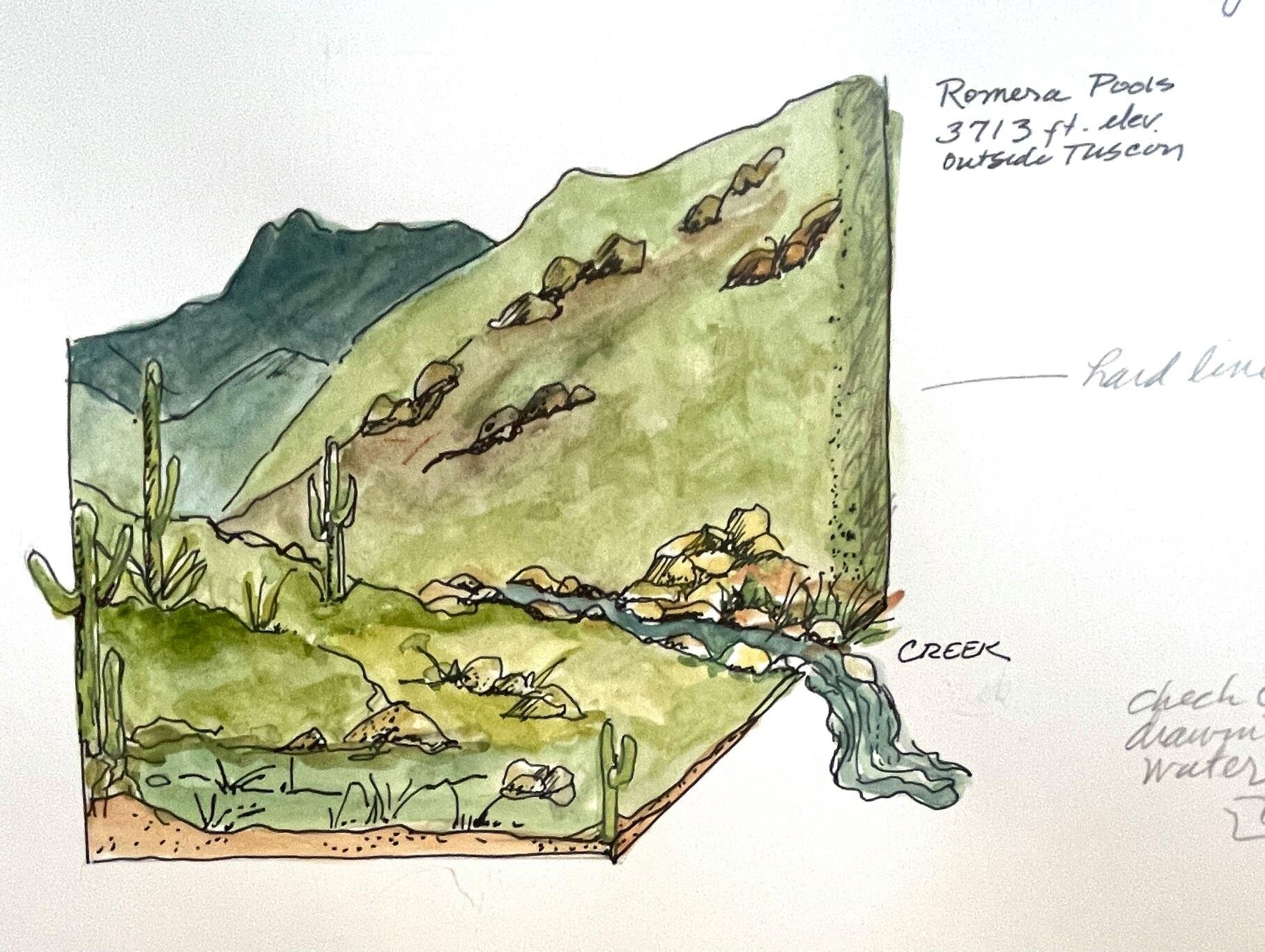


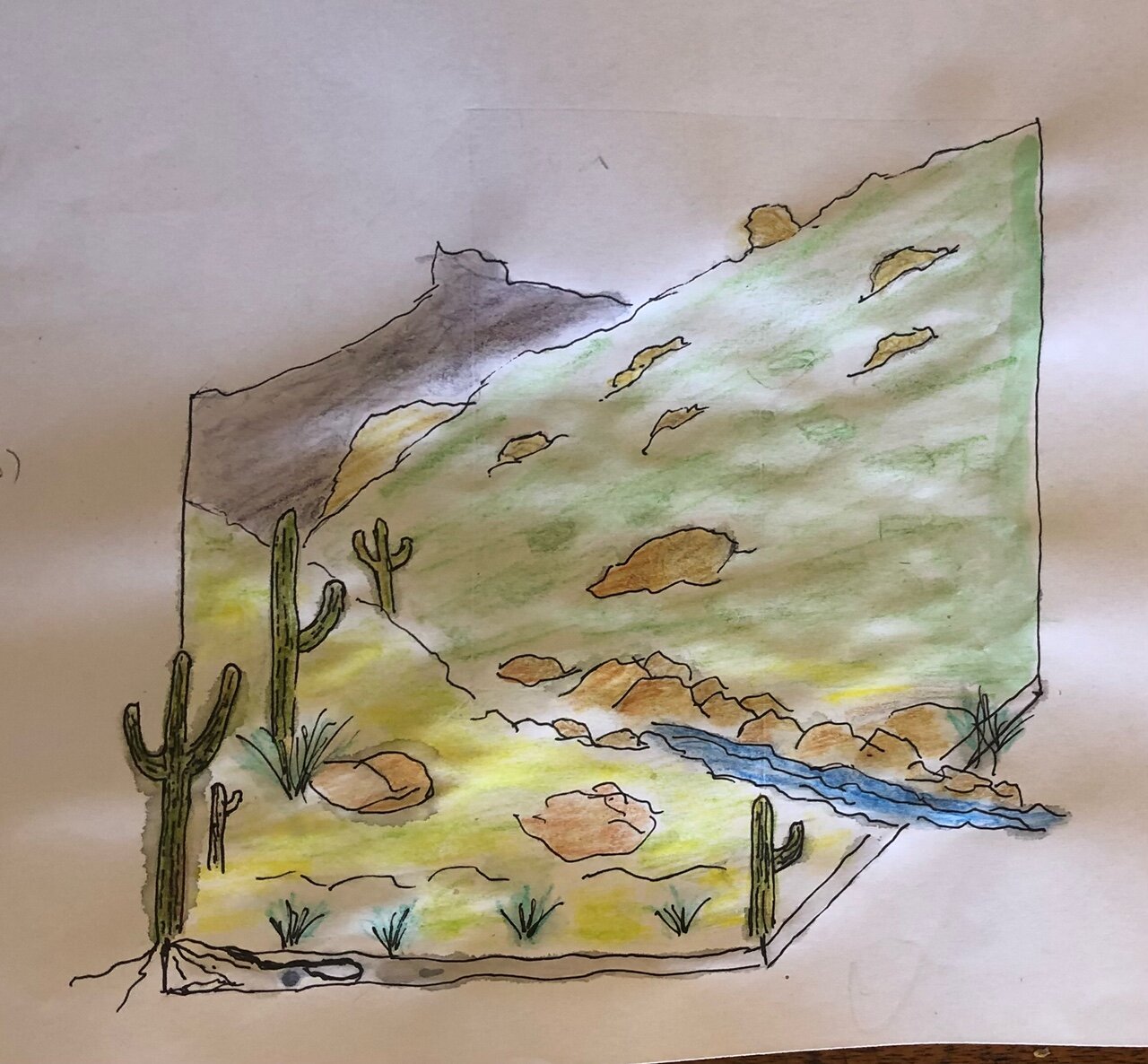
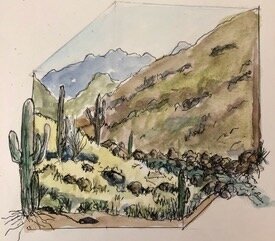
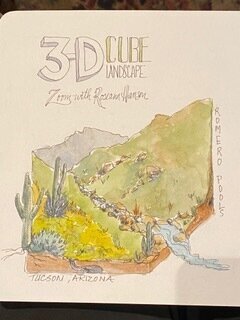
Support free tutorials! Click to contribute to the Tip Jar!
Virtual Field Trip: Mountains and Mesas
Join me on a virtual field trip from Moab, Utah, to Aspen, Colorado, all along backcountry roads through some of North America’s most spectacular scenery as the colors begin turning fiery yellow and red.
Sketch along or just observe, I’ll narrate as I go to demonstrate why I choose to focus on what subjects and how to quickly capture them in your field notebooks and nature journals.
Here is the link to my special Virtual Field Trip experience online so you can explore on your own, at your own pace; click on the “i” icon at the beginning of the “tour” so you can get the instructions on accessing the images and videos (the only scene I sketched that isn’t on the tour is the Gunnison River, which I included below):
https://360exploring.s3-us-west-1.amazonaws.com/Mountains-Mesas-2020/output/index.html
Resources from the Workshop
METADATA AND NATURE DATA:
Gunnison River fall scene.

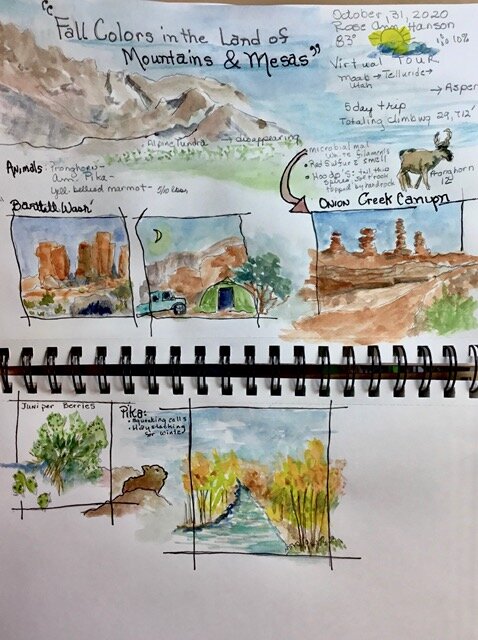


Support free tutorials! Click to contribute to the Tip Jar!
Virtual Field Trip: Monarchs & Milkweeds Micro Safari
Join me on a new kind of exploration—a micro safari! You don’t have to go far to discover wonderful things. We’ll hunker down in a field of milkweed and observe, learn about, and sketch monarchs, as well as many other insects. BONUS: If we have time we might just scoot down to Mexico to observe winter monarch habitat as well. (EDITING NOTE: We had to blur-out some of video at the end; I didn’t have permission to use the PBS / BBC footage even for a free education clip! Sorry about that! You can see the video clip in the link below.)
Footage in the explorations is from: Yosemite Nature Notes; Dominique Lalond Nature Films on YouTube; PBS Nature.
Roseann’s pages from the demonstrations in the workshop.
I mostly use a limited palette of five transparent watercolors (all Daniel Smith): aerolin yellow; quinacridone rose; manganese blue; burn Sienna; indanthrone blue). For the iridescent beetle, though, I followed John Muir Laws’ tutorial in his book The Laws Guide to Nature Drawing and Journaling, and first laid down a pthalo green and a little bit of pthalo blue, then added the darks with blue-black mixed with ultramarine blue and burn Sienna, which lifts off easily. The pthalos are very staining so are good to use if you are lifting color from on top of them.
Resources from the Workshop
Metadata and Nature data:
IMAGES FROM EACH STOP (CLICK TO ENLARGE; RIGHT-CLICK TO DOWNLOAD):
Workshop Attendees’ Pages
Adding Pages to My Handmade Leather Journal
In this short tutorial I demonstrate how I lace pages into my simple leather journal using leather shoelace. I've been using this system for over 20 years and it is inexpensive and versatile, allowing me to archive my pages in three-ring binders.
To see previous posts on how I made my journal and my Minimalist Stand-Up Sketching Kit and printable downloads for weather data, use the links below.
Virtual Field Trip: Unique Grasslands of the World
Join me as we explore three of the world’s grasslands—Australia’s Southern Tablelands in New South Wales, Brazil’s Cerrado, and Alberta’s Southern Prairies—to observe, take notes on, and sketch some well-known animals as well as some lesser-known and fascinating creatures! Sketch along or just observe, I’ll narrate as I go to demonstrate why I choose to focus on what subjects and how to quickly capture them in your field notebooks and nature journals.
Resources from the Workshop
Metadata and Nature data:
Images from each stop (click to enlarge; right-click to download):
Virtual Field Trip: Safari to Botswana
Join me as we head to Botswana for a special virtual safari!
We’ll explore, sketch, and take notes on elephants and their behavior, all virtually.
If you haven't started adding sketches to your field journals yet, don't worry—this session is going to focus on observational skills and recording data in the field. I might do a sketch or two, but definitely demonstrate survey counts and behavior tallies. Or just sit back and enjoy watching elephant antics. If you’re shy, don’t worry—we don’t require anyone to share their work and you can remain completely anonymous and worry-free!
RESOURCES FROM THIS VIRTUAL FIELD TRIP:
Practice identifying three basic age groups by learning to sketch them, thus learning their key features.
ON ELEPHANT BIOLOGY:
This article has a cool diagram of the bones of the foot (h/t Olivia C.):
http://elephant.elehost.com/About_Elephants/Anatomy/The_Feet/the_feet.html
PARTICIPANTS’ PAGES:
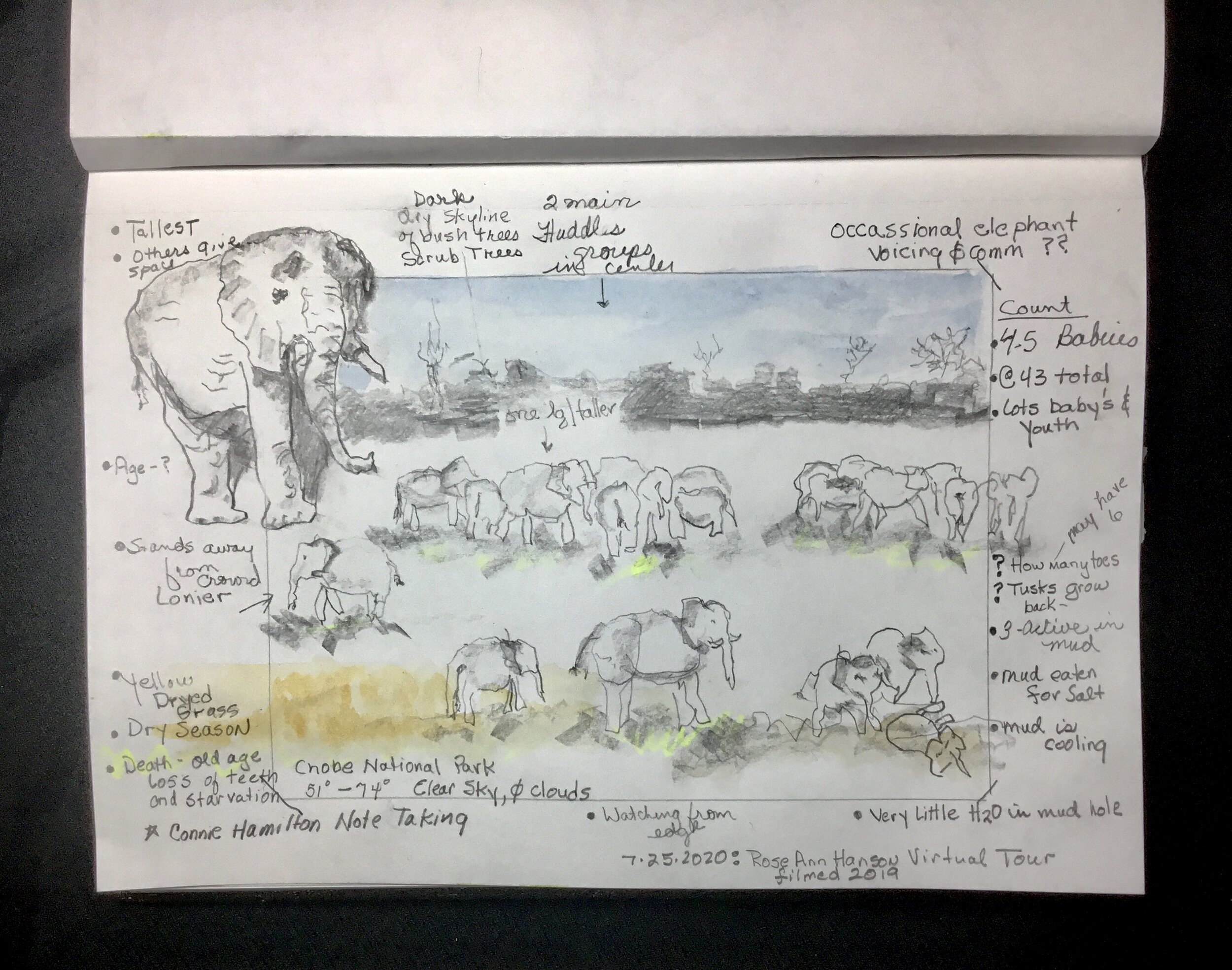



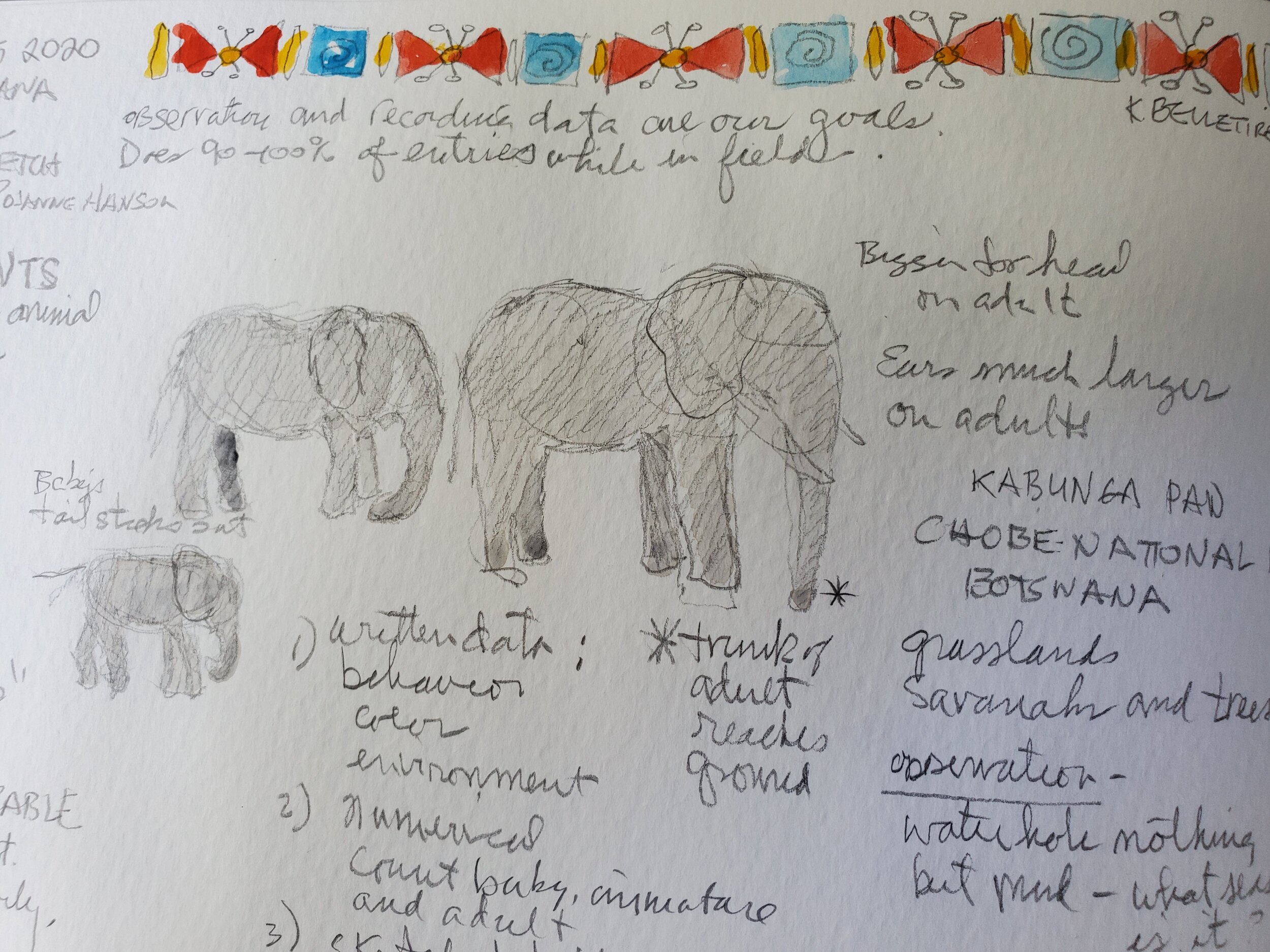
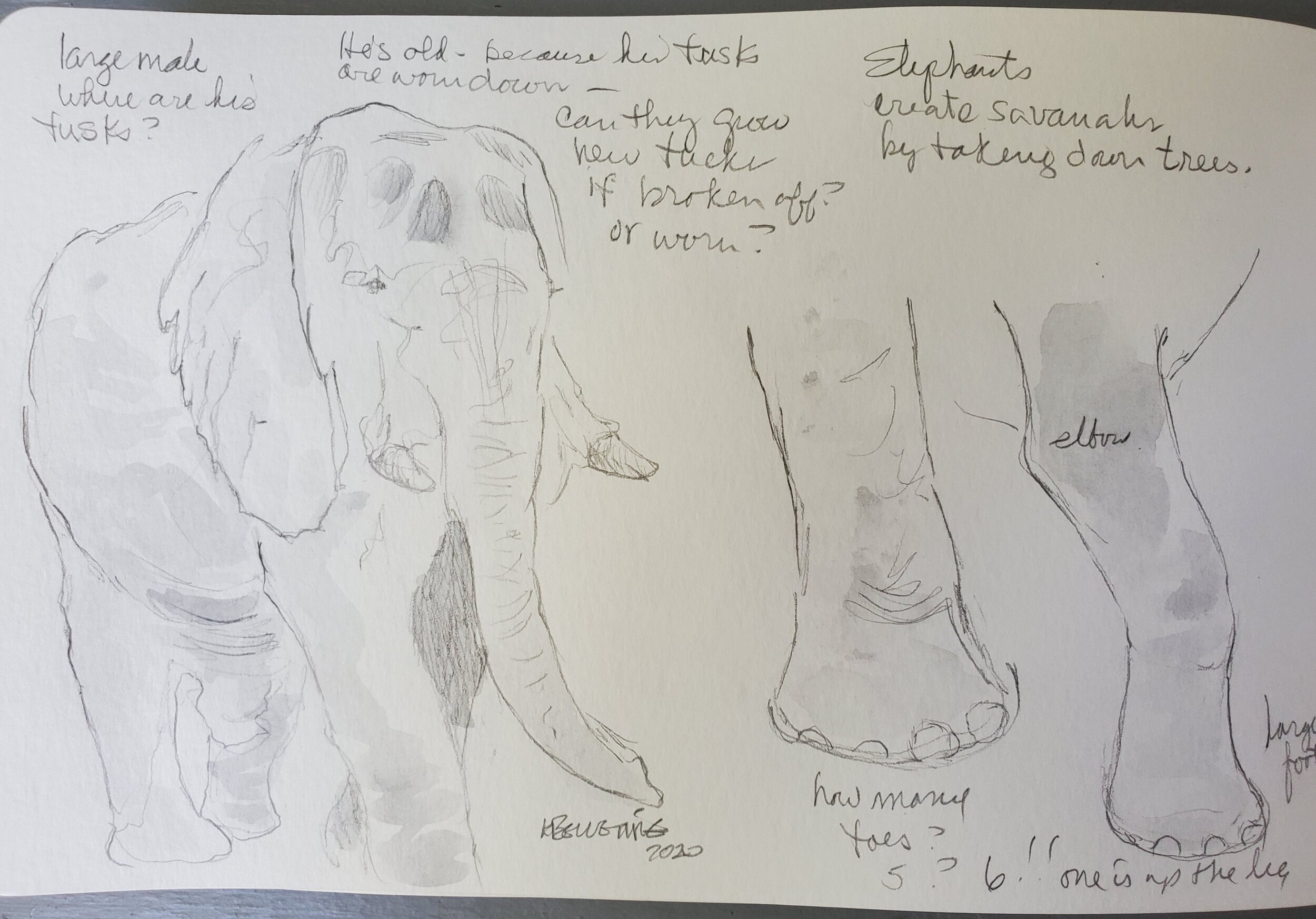
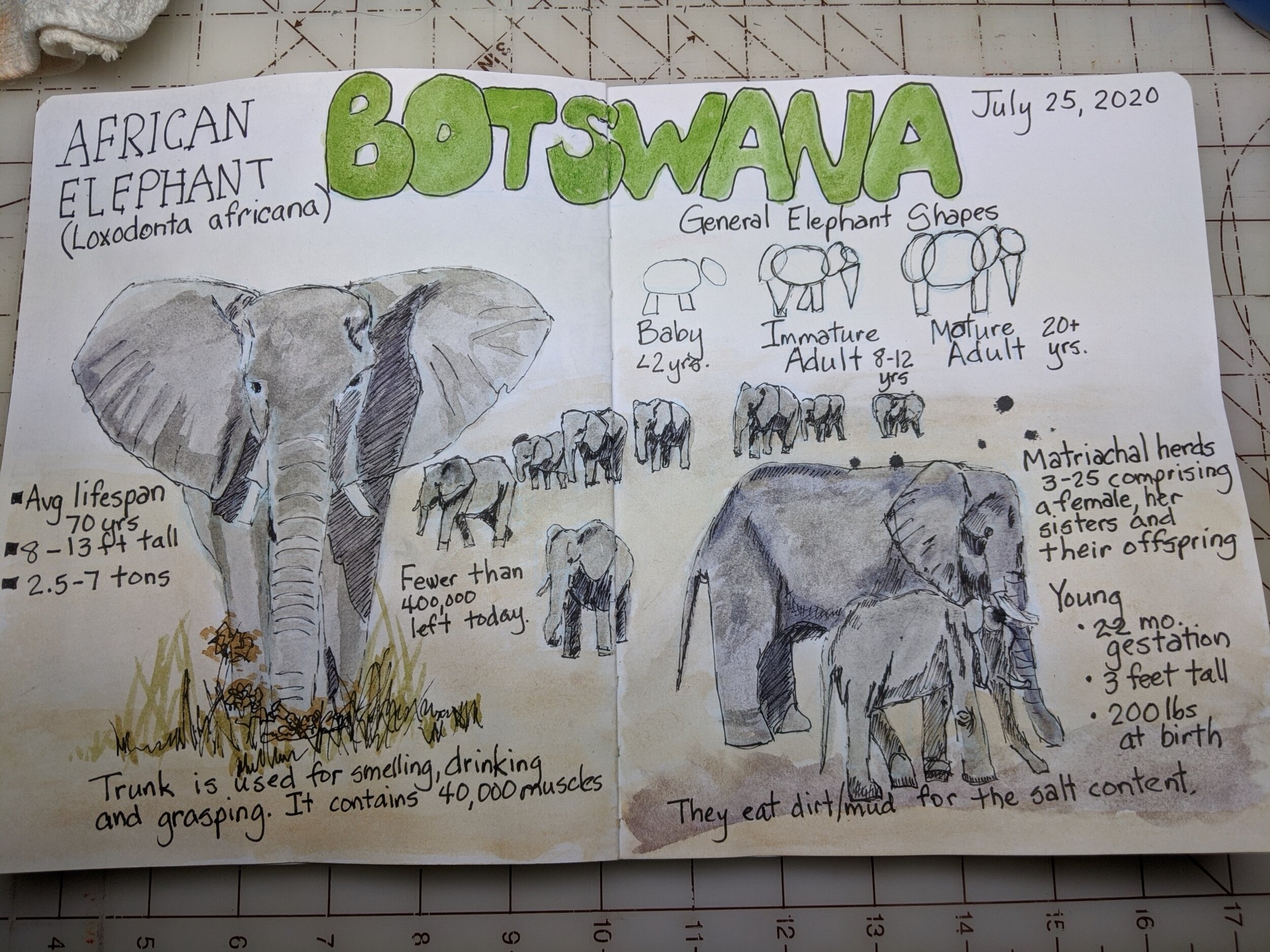
Virtual Field Trip: Yellowstone National Park
Join us as we head to Yellowstone National Park—without the crowds! We explore, sketch, and take notes on geyser basins, plants, wildlife, and the Grand Canyon of the Yellowstone, all virtually. Sketch along, or just watch, I explain how I pick what to sketch, where I put it on a page, and plan to leave room for nature data and notes.
Some tips and resources mentioned in the workshop:
Google Earth tour of Yellowstone: use this link here
PDF with metadata and nature data for each of the stops we made in the park. Download here.
Here are the images we used for sketching (all from the Google Earth tour, in the public domain; credit named where given):
Roseann’s finished pages:
Participants’ pages:
Don’t miss out! Get notifications of new tutorials, upcoming workshops, books, and more right to your in-box. We don’t over-do it, and we always respect your privacy. Promise!
#fieldarts #sketching #naturejournal #watercolor @swarovskioptik_nature #swarovskioptik_nature
Virtual Field Trip: Lake District National Park
[Scroll down for resources for the workshop.]
May 24, 2020 — Zoom workshop-demonstration on quickly sketching landscapes in the field, by Roseann Hanson (University of Arizona Desert Laboratory on Tumamoc Hill / ExploringOverland.com Field Arts Institute) and Ryan Petterson (Stanford University School of Earth Energy and Environmental Sciences).
Roseann and Ryan are both field scientists and naturalists, and keep field journals / nature journals with notes and sketches in pen, pencil, and watercolor.
In this workshop, we take you on a virtual field trip to the Lake District in England using a 360-degree-view website, and then each of us demonstrates how we zero in on a scene, and then do a live sketch and discussion of our thinking and drawing process and techniques, adding color at the end.
Plan to draw along, and we answer questions as we go.
[Please note: during Ryan's sessions a camera / Zoom malfunction created a less-than-ideal resolution, which we are trying to fix.]
----------------------------------------------------------
RESOURCES FOR THE WORKSHOP:
Explore the region we’ll be visiting on our virtual field trip, Mosedale, Wasdale Head, Ritson’s Force, Lake District, NW England:
VRGlaciers, University of Worcester website
Click on the orange “TAKE ME THERE” to go to the 360-degree view; we’ll be at site #4 and later, #3 and #6.
To see Wasdale Head region on Google Maps, click here.
If you would like to sketch and paint along with me and Ryan, have your field notebook / nature journal handy, and a waterproof pen (if doing watercolor, too) or pencil.
John Muir Laws on sketching “landscapitos”— here, and peruse Instagram for great quick-sketches hash tagged #landscapito here.
Screen shots for our sketching demos:
Instructor and participant sketches from the workshop:
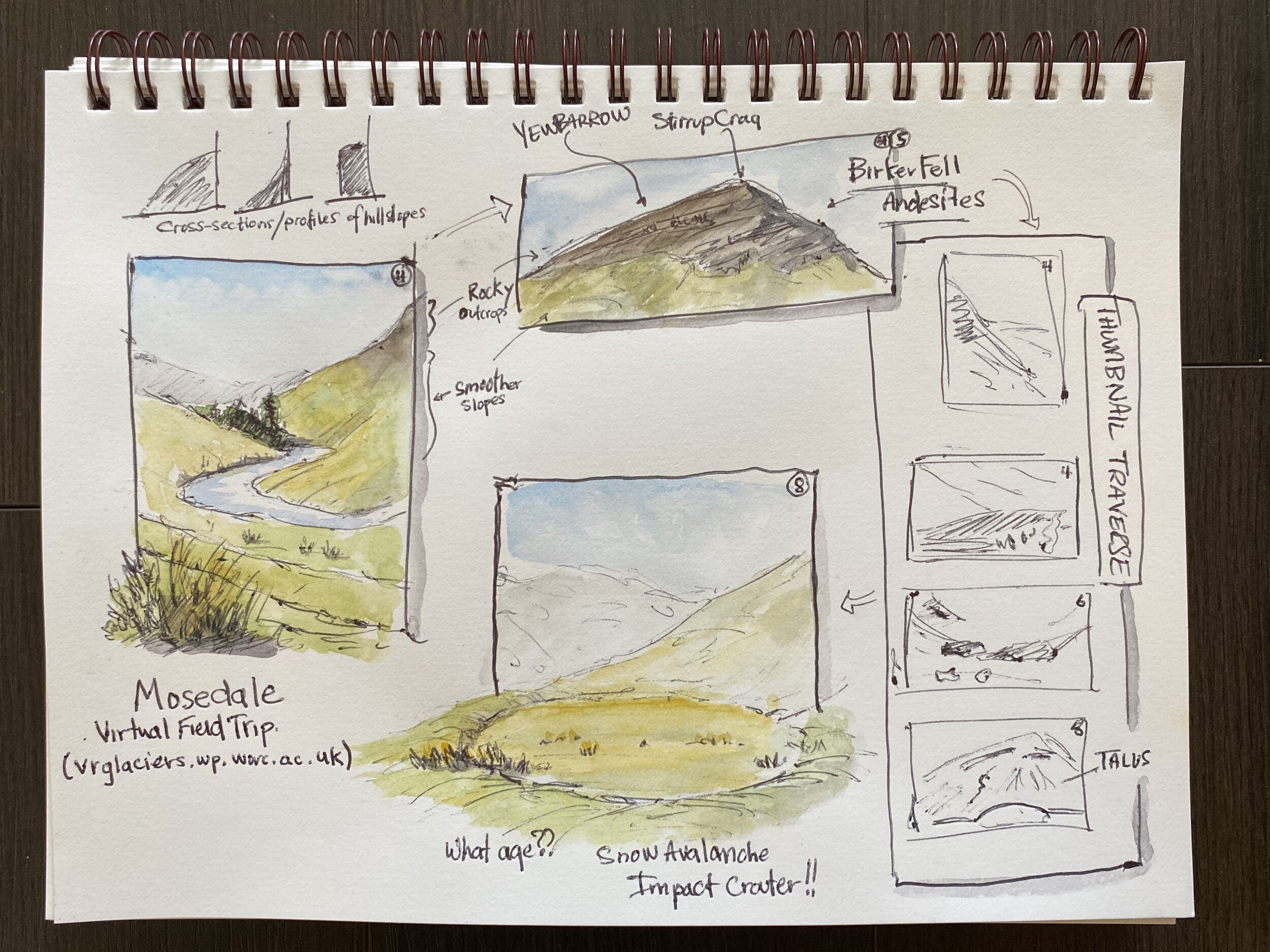
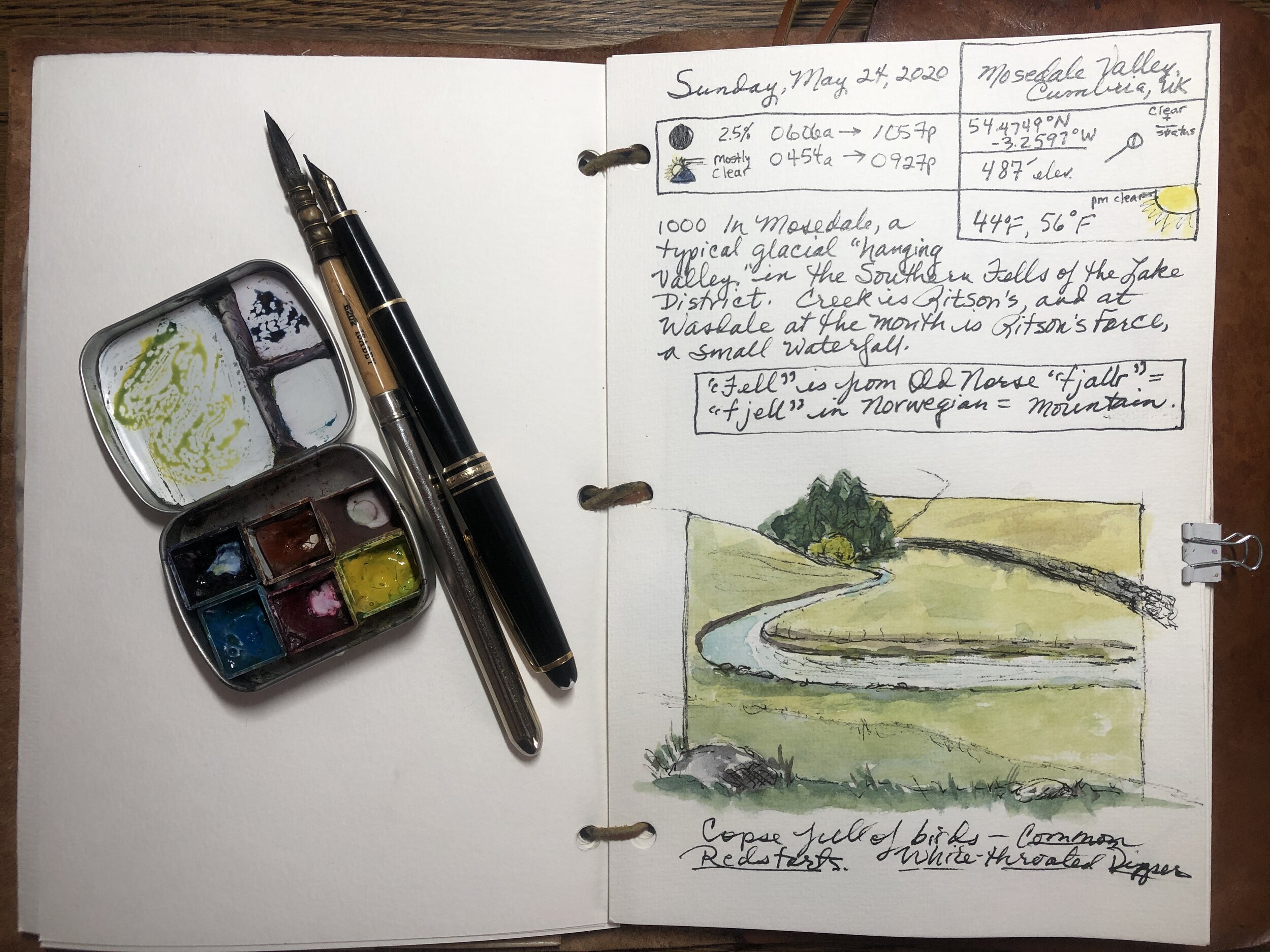
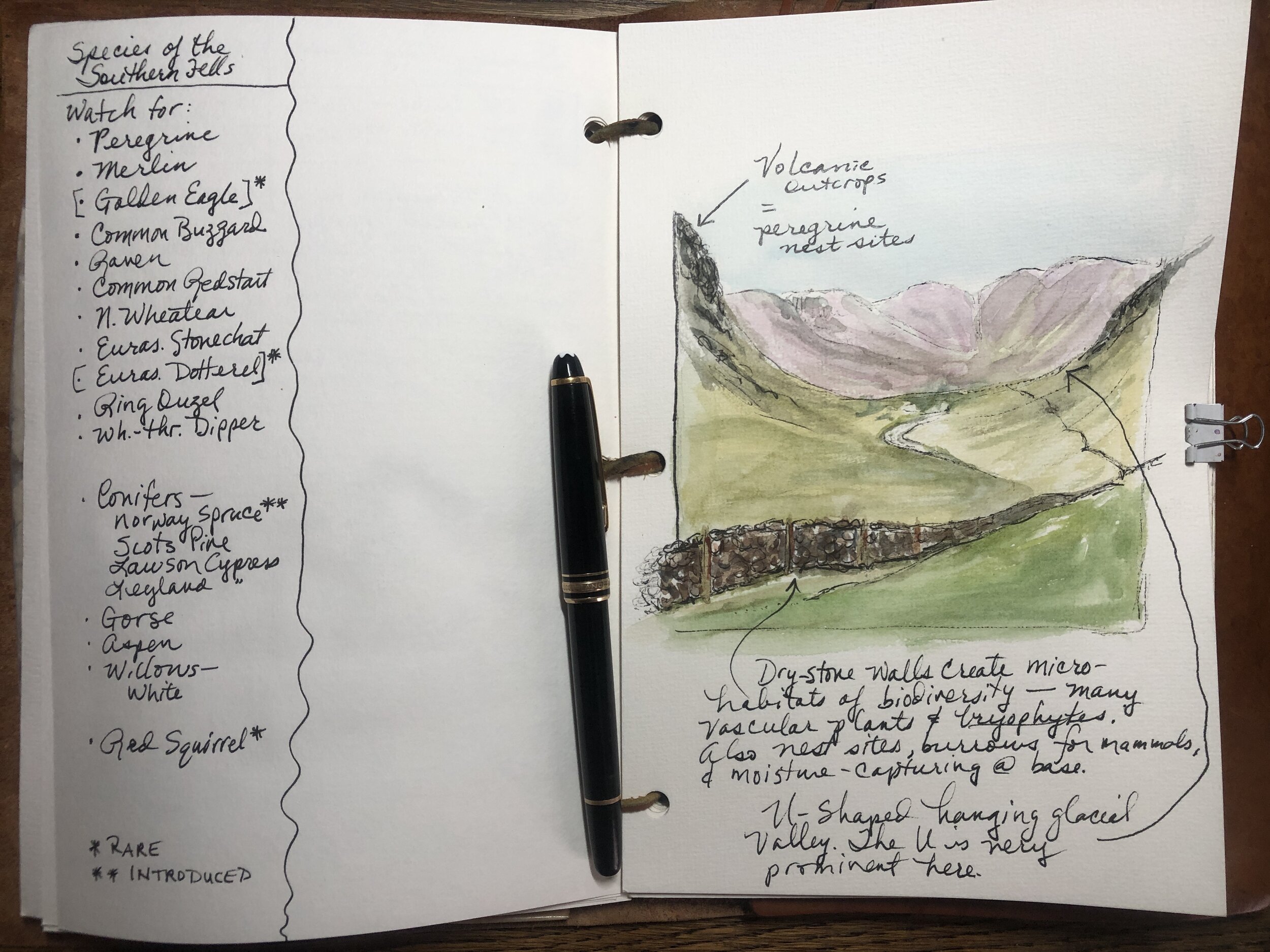


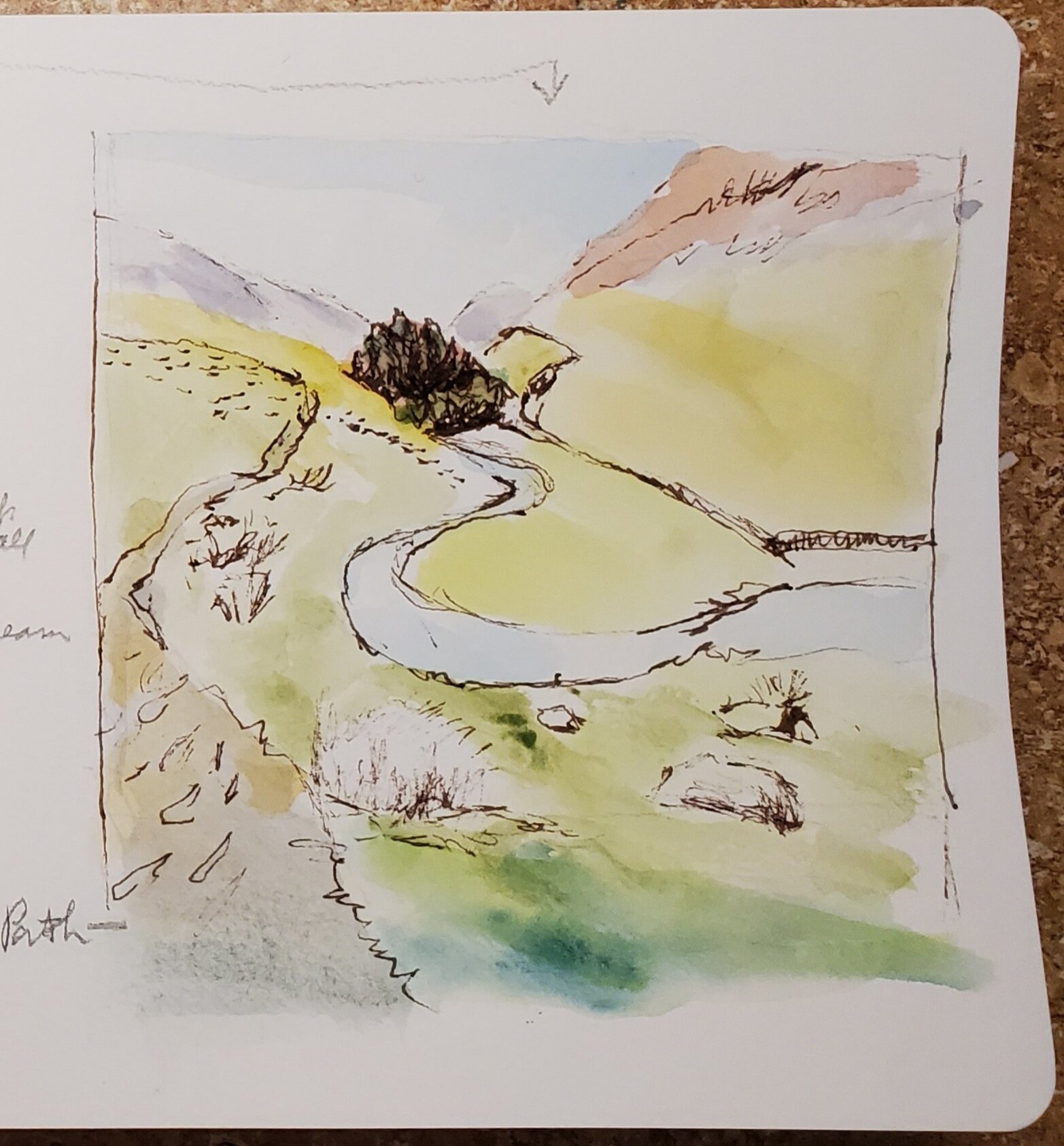
Roseann's palette in a small tin (see here):
Ryan’s palette (in ExpeditionaryArt.com’s mini paint kit):
----------------------------------------------------------
Online resources:
John Muir Laws' Nature Journal Club:
facebook.com/groups/naturejournalclub/
----------------------------------------------------------
Books:
Nature Journaling for a Wild Life by Roseann Hanson
Available at ExploringOverland.com through our Field Arts Institute:
exploringoverland.com/field-arts-shop
Laws Guide to Nature Drawing and Journaling:
----------------------------------------------------------
Follow us on IG:
@roseannhanson @desert.laboratory @ry_pett @stanfordearth
Facebook/roseannhansonexplore
#fieldarts #sketching #naturejournal #watercolor @swarovskioptik_nature #swarovskioptik_nature


